



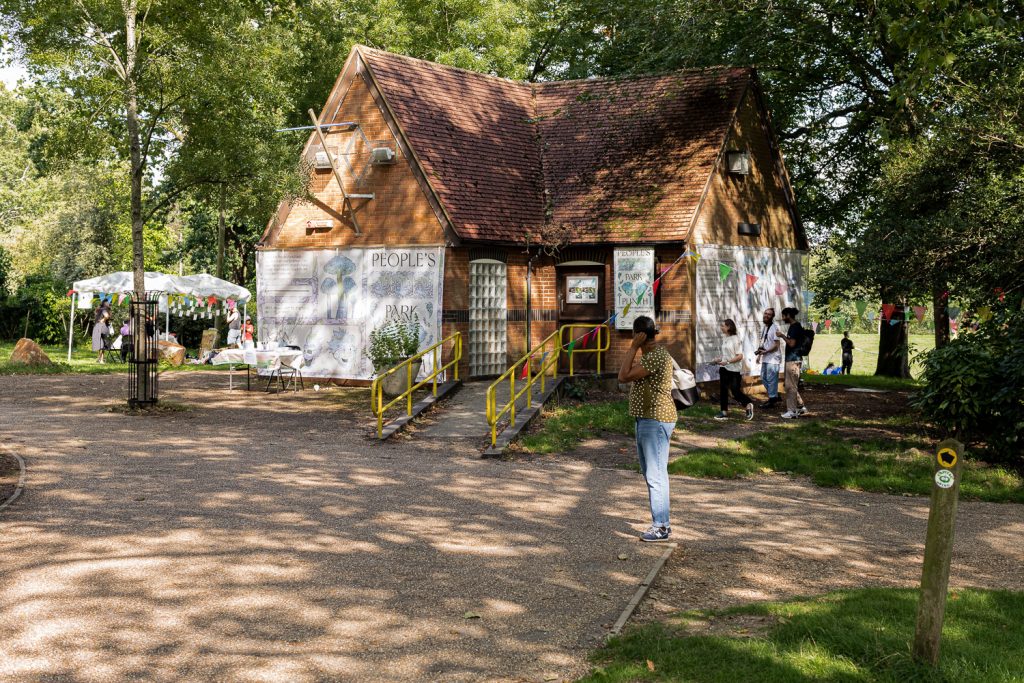
In 2019, we celebrated 150 years of Finsbury Park being the ‘People’s Park’ – a place where we can all do things together. In 2020 protests across the UK saw public artworks toppled from plinths, while the pandemic left us separated and isolated.
With this in mind, we launched the People’s Park Plinth this summer, as a way to re-explore our public spaces by turning Furtherfield Gallery inside out and expanding its digital arts programme beyond our walls and into the life of Finsbury Park.
We collaborated with incredibly talented artists, curators and local park members to create 3 ‘taster’ digital public artworks that speak about the park’s heritage and local stories. In May, June, and July we showcased a different digital art experience each month.
In August, the park made its pick! We will be launching a larger commission of Based on a Tree Story this Autumn, and to continue celebrating the heritage, artistry and local voices from Finsbury Park, all the ‘taster’ artworks will be available until January 2022.
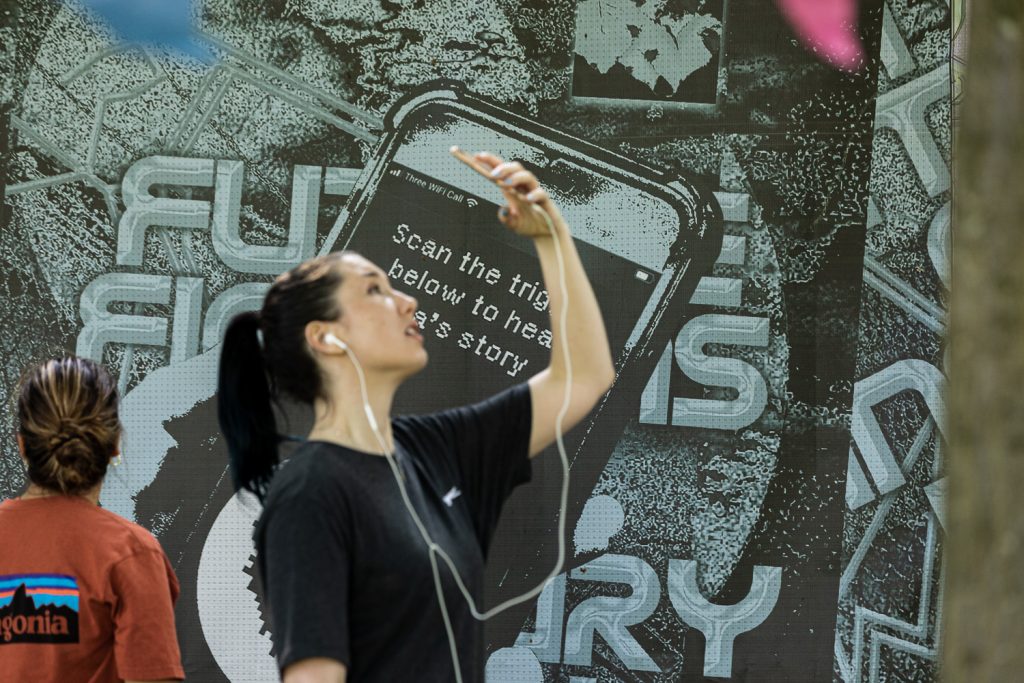
If you are in Finsbury Park you can use the camera on your phone to scan the QR codes on the People’s Park Plinth (presented on the exterior of our Gallery building in the centre of the park). They are all free to access, any time, with any smartphone – but you might want to have some headphones handy too.
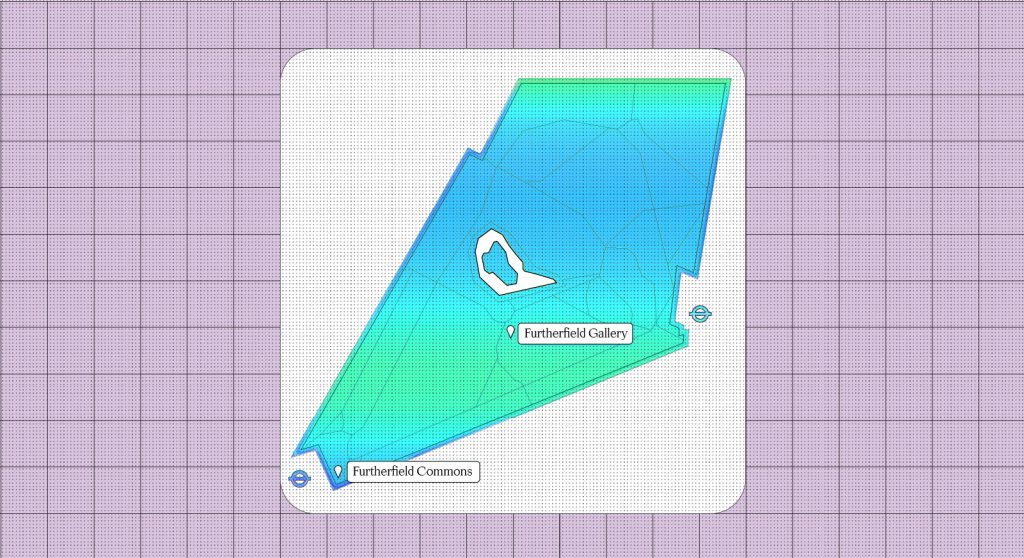
If you are somewhere else you can click the links on the People’s Park Plinth website to find the artworks.
It’s your park so it’s your pick!
Sign up here to get involved in choosing the artwork that most belongs in the heart of Finsbury Park next year.
Breath Mark x Lisa Hall & Hannah Kemp-Welch
Live until January 2022
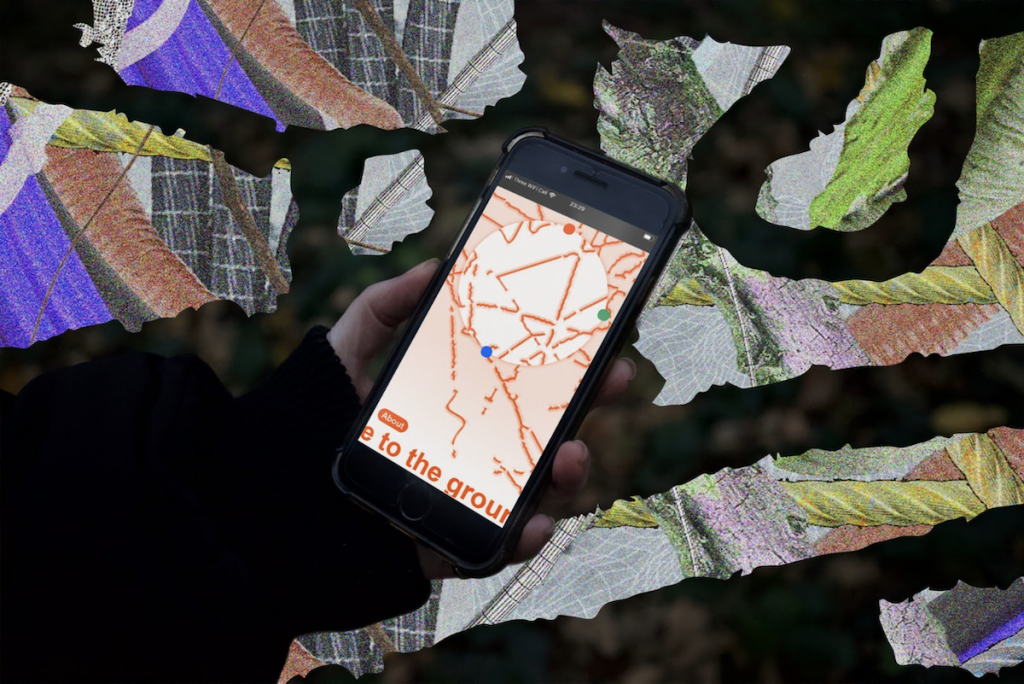
A site-specific, interactive sound work creating moments of connection between strangers of all species.
Follow this sound work as it leads you across the park to meeting points for animals, plants and strangers. As you listen, consider the needs of all these inhabitants and our symbiotic relationship that is increasingly under threat. Between heartbeats, vibrations and the alignment of crossing paths, this work sounds out a shared existence, putting these moments of connectivity with strangers of all species on the People’s Park’s Plinth.
The work features interviews with volunteers at Edible Landscapes, a forest gardening group based onsite at Finsbury Park: David Berrie, Imogen Simmonds, Jo Homan, Juliette Ezavin and Theo Betts. The artists were commissioned by Breath Mark, a curatorial collective formed as a part of the Royal College of Art’s MA Curating Contemporary Art Programme Graduate Projects 2021 in partnership with Furtherfield’s People’s Park Plinth project.
Taster: In this first iteration of the artwork, one sound pathway ‘Close to the ground’ is presented.
Larger commission: If this work had been selected in the public vote in August 2021, a further two sound pathways and a trail to find them would have been revealed.
HERVISIONS x Ayesha Tan Jones
Live until January 2022
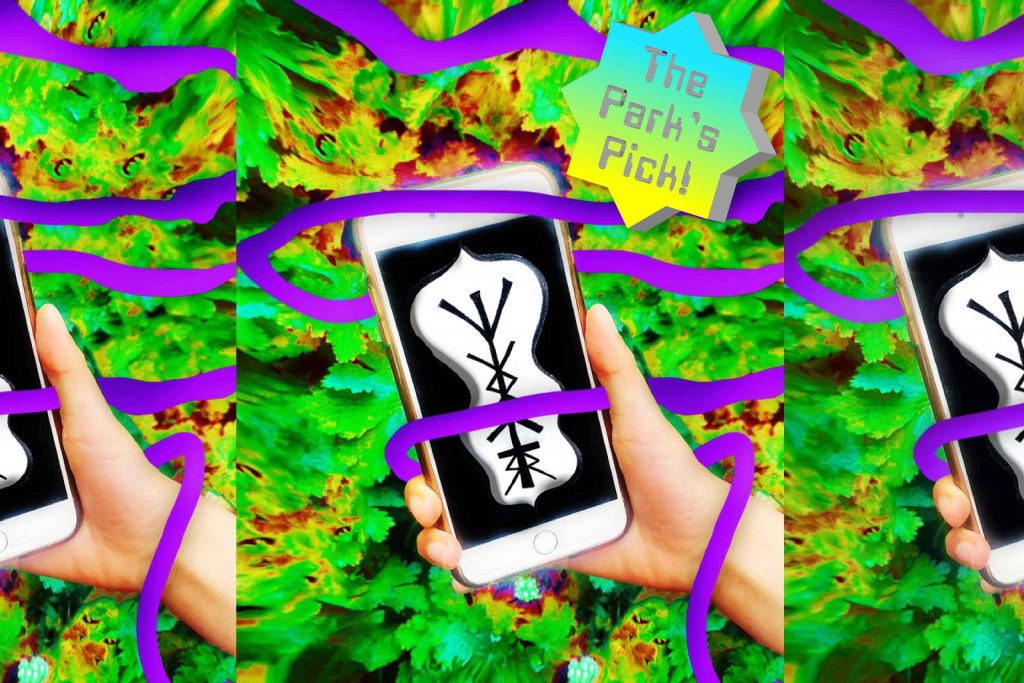
A site-specific, sonic augmented reality encounter with a digital tree sprite that tells tales of the tree’s past, present and future.
The trees of Finsbury Park are very old, and they have been witness to a lot of change and growth. If the trees had a voice, what would they share?
Based on a Tree Story brings to life Furtherfield Gallery’s nearby resident, a London plane tree dubbed the Trunk Triplets Tree, situated in Finsbury Park and the soils from which they grew, part of the now-extinct ancient woodland, Hornsey Woods. From medieval history to sci-fi futures, their stories are told through an augmented reality and audio experience, giving viewers an insight into the past, while arming them with inspiration and knowledge to help protect the trees into the future.
The project activates a digital tree sprite that shares a fable crafted through local research, site visits and discussion with Ricard Zanoli, the Park Ranger.
Taster: In this first iteration of the artwork one tree story is presented.
Larger commission: This work was selected in the public vote in August 2021 and further two tree stories and a trail of clues to find them will be revealed this Autumn.
Desree x Drumming School with Alex Dayo x Studio Hyte
Live until January 2022
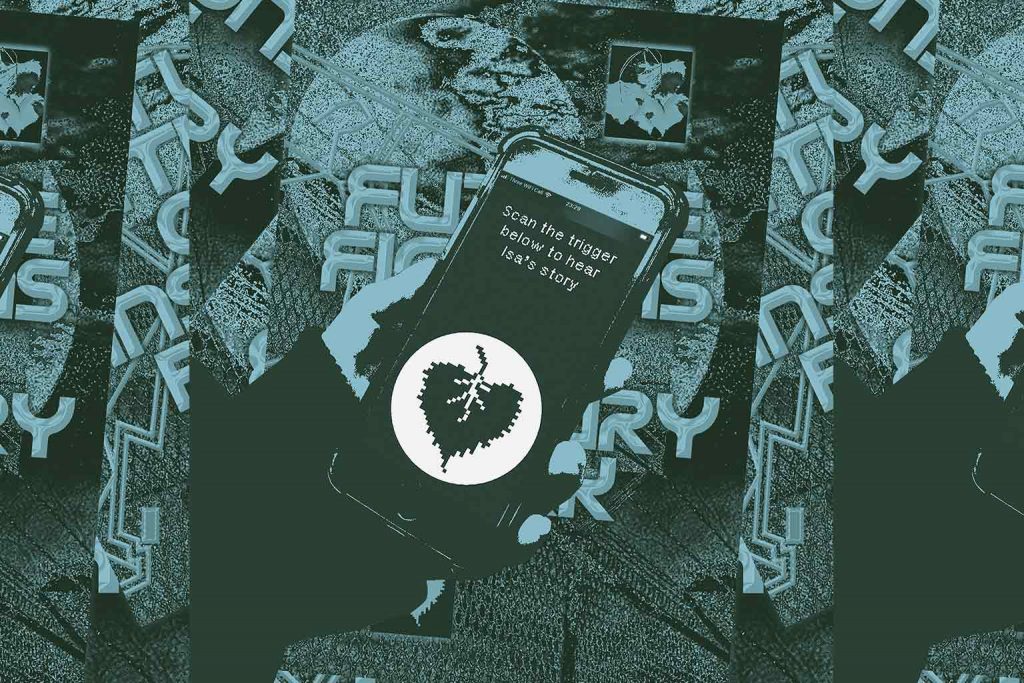
An augmented reality (AR) sci-fi zine comprising three stories that bring together writers, musicians, and local residents to explore alternative visions of a Finsbury Park of the future.
For this first iteration of the AR zine, released in July 2021 as part of the People’s Park Plinth programme, we present The Light and Dark: an audio-visual story about a fictional character, Isa, who wakes up in a home they don’t recognize, surrounded by land that feels as foreign as the sky they sit under. Isa does not know how they made it there, but they do know they have to make it home before the host finds them. With only the wisdom of Grandwa, and the feeling in their chest, Isa discovers the power of their historical connection to what was, their land.
The Light and Dark has been written by local spoken word artist and writer Desree, and is accompanied by a unique musical composition by musician Alex Dayo and his park-based Drumming School, in collaboration with David Kemp. The visual design, AR experience and animation have been developed by Studio Hyte.
Taster: In this first iteration of the artwork the start of one future fiction is presented.
Larger commission: Had this work been selected in the public vote in August 2021, this fiction would have been completed and two more would have been revealed.
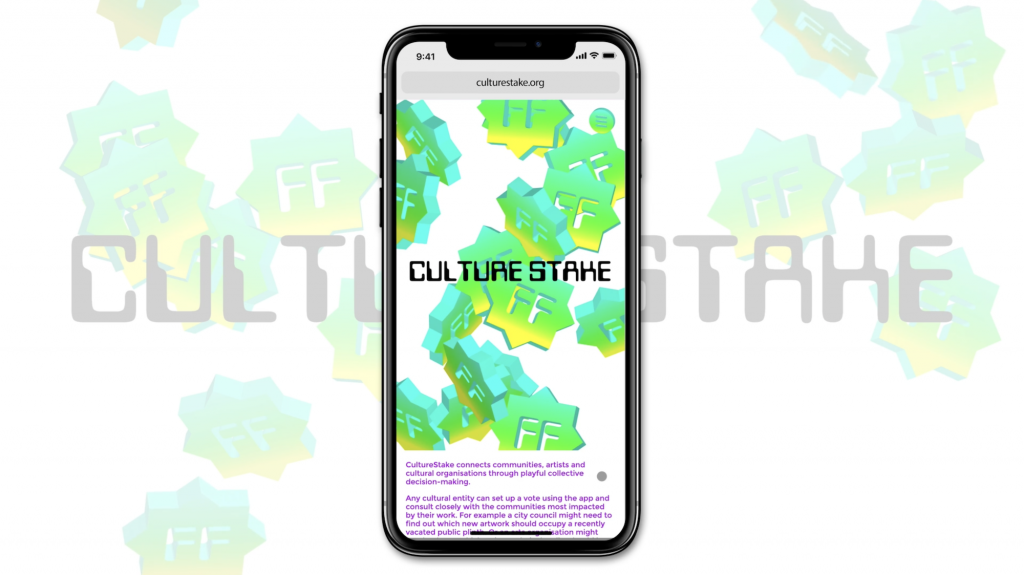
In August, after experiencing all 3 digital artworks, we asked people to pick which one they thought belonged in the heart of Finsbury Park by either:
Or
The park’s pick is Based on a Tree Story, and we are working with HERVISIONS and Ayesha Tan Jones to make a bigger and better version of their digital art experience – and then we will launch it on the People’s Park Plinth this Autumn!
We wanted everyone to express an opinion – even if visitors were far away what they felt mattered too. But if voters lived locally what they felt mattered more for the vote count – so we weighted the vote for anyone using the CultureStake app within or near the park.
If you are an arts organisation you can find out more about how you can use CultureStake to drive collective cultural decision-making at your own digital and physical events.
Breath Mark is a curatorial collective initiated as a part of the Curating Contemporary Art Graduate Projects Programme 2021, Royal College of Art. Comprising six international members, Breath Mark’s curatorial practice responds to the challenges of curating remotely and explores the interconnectivity of physical and digital site-specific experiences.
Members: Kevin Bello, Jindra Bucan, Harriet Min Zhang, Soyeon Park, Yifei Tang and Yuting Tang.
As part of extended public engagement, Breath Mark has collaborated with design studio An Endless Supply, on a digital microsite acting as a reading room allowing audiences to further engage with the artwork’s themes. We encourage visitors to extend their experiences through the texts, sounds and videos here: spaces.rca.ac.uk
Lisa Hall is a sound artist exploring how environments are built-in sound, while Hannah Kemp-Welch is a socially engaged artist concerned with listening. Hannah and Lisa met at London College of Communication while studying MA Sound Arts in 2010. They share an interest in public and private spaces, and how sound and audio technologies build networks and tell stories that often can’t be seen. They have collaborated on sound art projects for performances and installations at Tate Modern, CRiSAP, and Sound Reasons Festival: New Delhi.
https://www.sound-art-hannah.com
HERVISIONS is a femme-focussed curatorial agency supporting and promoting artists working across new and emergent technologies, and platforms with a strong focus on the intersection of art, technology and culture. HERVISIONS partner with institutes, organisations and galleries to create antidisciplinary exhibitions and innovative commissions. Select partners include, LUX, Tate, bitforms and Google Arts and Culture.
IG: @hervisions_
Ayesha Tan Jones AKA YaYa Bones work is a spiritual practice that seeks to present an alternative, queer, optimistic dystopia. They work through ritual, meditating through craft, dancing through the veil betwixt nature and the other. Ayesha weaves a mycelial web of diverse, eco-conscious narratives which aim to connect, enthral and induce audiences to think more sustainably and ethically. Traversing pop music, sculpture, alter-egos, digital image and video work, Ayesha sanctifies these mediums as tool’s in their craft. Selected recent commissions/exhibitions include: Shanghai Biennale (2021) Athens Biennale (2021) Solo Show at Underground Flower Offsite (2020) Serpentine Galleries, London (2019) IMT Gallery, London (2019) Mimosa House, London (2018), ICA, London (2018-2020) Cell Project Space, London (2018) Gropius Bau, Berlin (2018) Yorkshire Sculpture Park (2016-17). Ayesha is represented by Harlesden High Street Gallery, London.
https://www.ayeshatanjones.com/
Desree is an award-winning spoken word artist, writer and facilitator based in London and Slough. Currently Artist in Residence for poetry collective EMPOWORD, Desree explores intersectionality, justice and social commentary. Producer for both Word Up and Word Of Mouth, finalist in 2018’s Hammer & Tongue national final and TEDx speaker, she has featured at events around the UK and internationally, including Glastonbury Festival 2019, Royal Albert Hall and Bowery Poetry New York. Burning Eye Publishers republished Desree’s first pamphlet, I Find My Strength In Simple Things, in May 2021.
Alex Dayo comes from Burkina Faso where his professional musical career started in the 1980’s, accompanying the National Ballet Kouledafourou on tour as well as playing for African Royalty and globally recognised dignitaries at private and public events and the Ensemble des Radios and Televisions of Burkina Faso, based in Bobo-Dioulasso. In 1985, he founded Wountey, a collective of musicians who created a new fusion of traditional and modern music called Plenguedey, and, for fifteen years, toured across Africa and Europe, spreading Burkina Faso’s cultural fusion to a wider audience. His musical collaborations include Ali Farka Toure, Femi Kuti and Salif Keita from Africa and traditional Master Griots from Burkina Faso/Mali/Guinea/Gambia. An accomplished arranger, Alex incorporates African traditional, Fusion, Jazz, Rock, Latin and Caribbean influences. Alex moved to London in 2007, where he set up a drumming school. A highlight of Alex’s career was being chosen to play at the Opening and Closing ceremonies at the London 2012 Olympics.
http://drummingschool.co.uk/zantogola
DESIGN & DEVELOPMENT
Studio Hyte is an award-winning design studio, working between graphic design, interaction, and emergent communication. Their work includes branding, print, website, installation, and exhibition design. Specializing in forward-thinking, multifaceted visual identities within the arts and education sector. Whether through commissioned or self-directed projects, they aim to create meaningful, accessible, and thought-provoking work.
Formed of a small group of individual practitioners, Studio Hyte is the middle ground where all of our interests and practices meet. Their collective practice and research cover a broad spectrum of topics including language, inclusion & accessibility, egalitarian politics & alternative protest, and technology & the human.
IG: @studiohyte
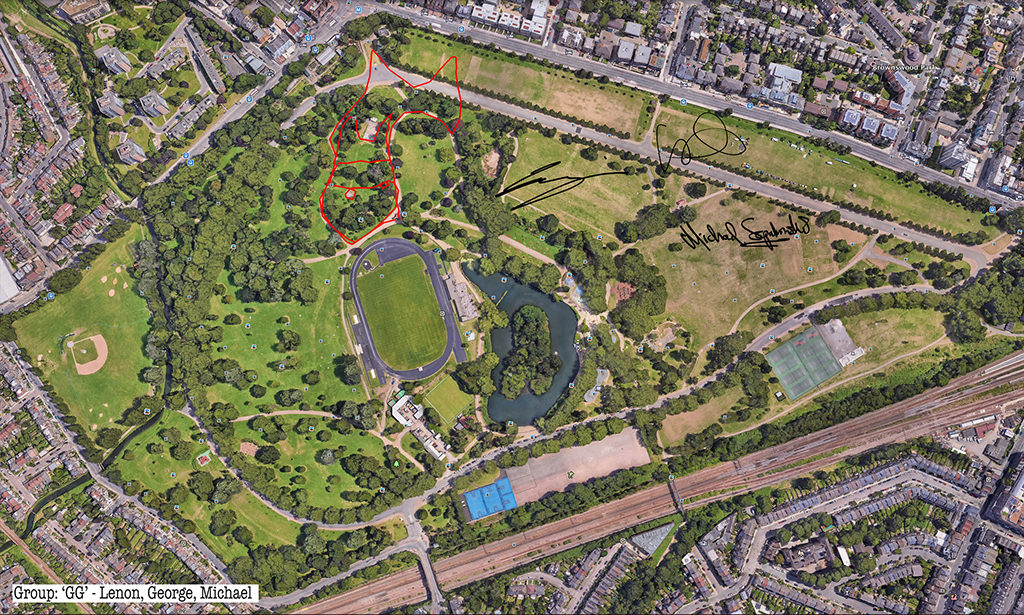
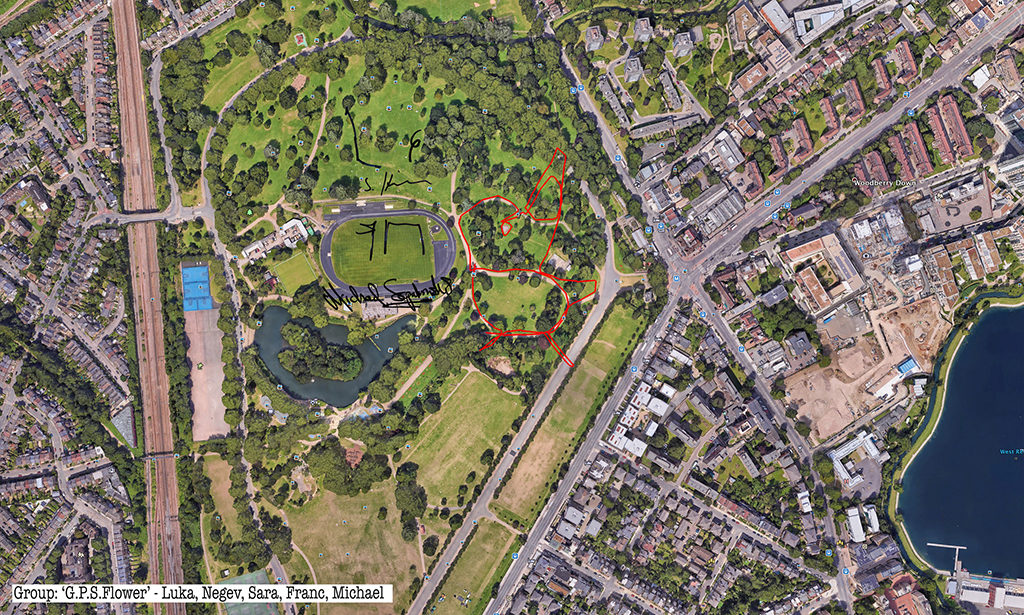
Recently I was approached to conceive and run an outreach project to accompany a solo show of work by Eduardo Kac at Furtherfield Gallery in North London’s Finsbury Park.
Among the works on show was one of Kac’s Lagoogleglyphs, large scale stylised representations of rabbits (something of a signature obsession for him) painted in some sort of sportsground emulsion directly onto a section of the park and allegedly of a scale which make it harvestable by the satellites Google rents for its various mapping activities.
Being completely frank, I have to say I entertained a degree of scepticism about Kac’s work—some of it falling within, in my view, one or both of two entertainment based metaphors—the ‘one-liner’ and the ‘theme park’—neither particularly positive elements of my critical lexicon.
Be that as it may, some of the work, particularly the less grandiose pieces (that delicate bunny flag flapping above the gallery!) were touched enough with real poetry to make me want to take up the challenge.
I say ‘challenge’ advisedly for I’m only ever interested in doing anything which in some sense challenges me and I also felt that my ambivalence about Kac would result in anything I ended up making containing a return element of ‘challenge’ or, perhaps more gently put, practical critique.
The word challenge also described the sense I had of wanting to counterpose collaboration, the collective, the everyday, to the artist with a capital ‘A’; of going some way to claiming art as a way of seeing and feeling and thinking together for All ( also with a capital ‘A’).
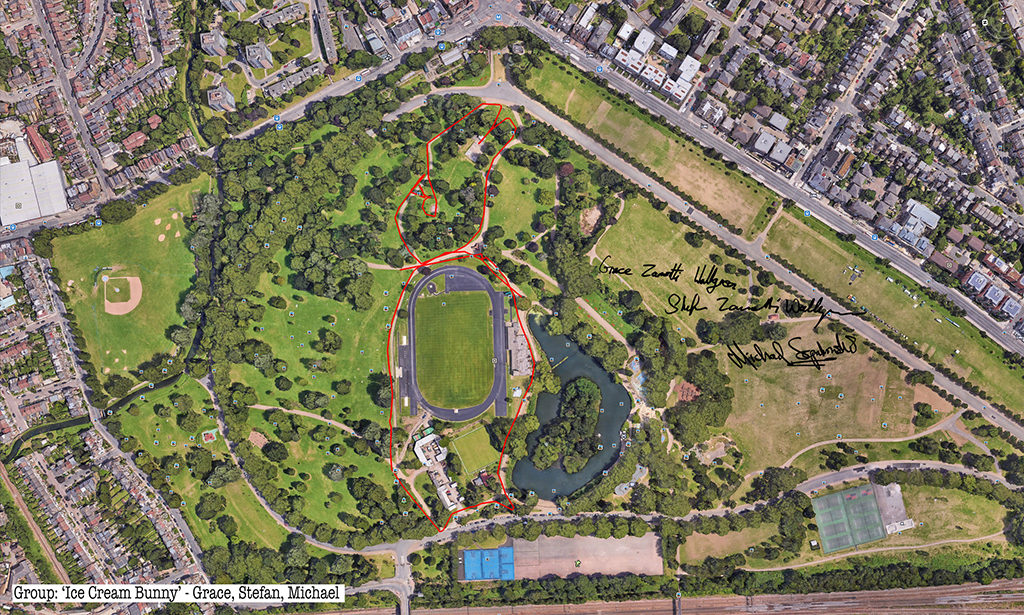
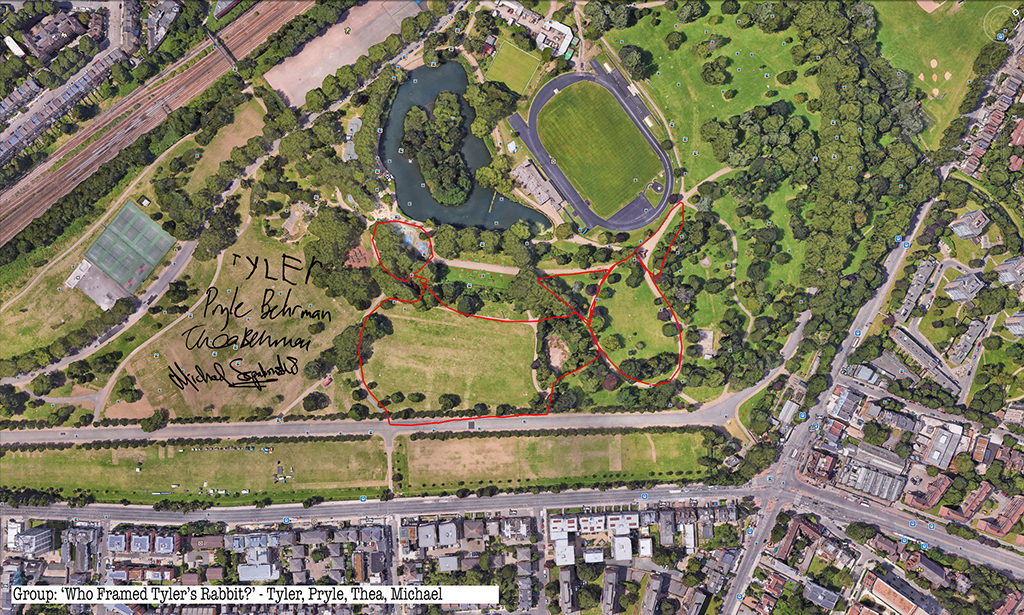
Reaching back in memory I pondered two remix/homage projects from the noughties which somehow straddled, in a pleasantly clunky fashion, practices both cutting edge digital (at least in their original moment) and time honoured too.
Apposite and practical stimuli for my 2018 purposes, they suggested elegant pathways to both honour previous work and to gently…um… stress-test it.
Both evinced rich humour, a warmth and a concomitant refusal to take themselves too seriously, qualities lacking in much contemporary art and both had a kind of performative klutziness I found entirely engaging.
Both were made in the first years of this millennium when digital and particularly online art was a wild west with a few fragile homesteads scattered here and there and not the orderly space it is today colonised almost entirely by the mainstream art world or commerce or both.
I recalled first a project by Nathaniel Stern where he hired South African billboard sign writers to paint physical representations of various, mostly art related, web pages.
The second was artist duo MTAA’s remix of Tehching Hsieh’s One Year Performance project, an endurance piece where Hsieh had forced himself to punch a timeclock on the hour, every hour for a whole year.
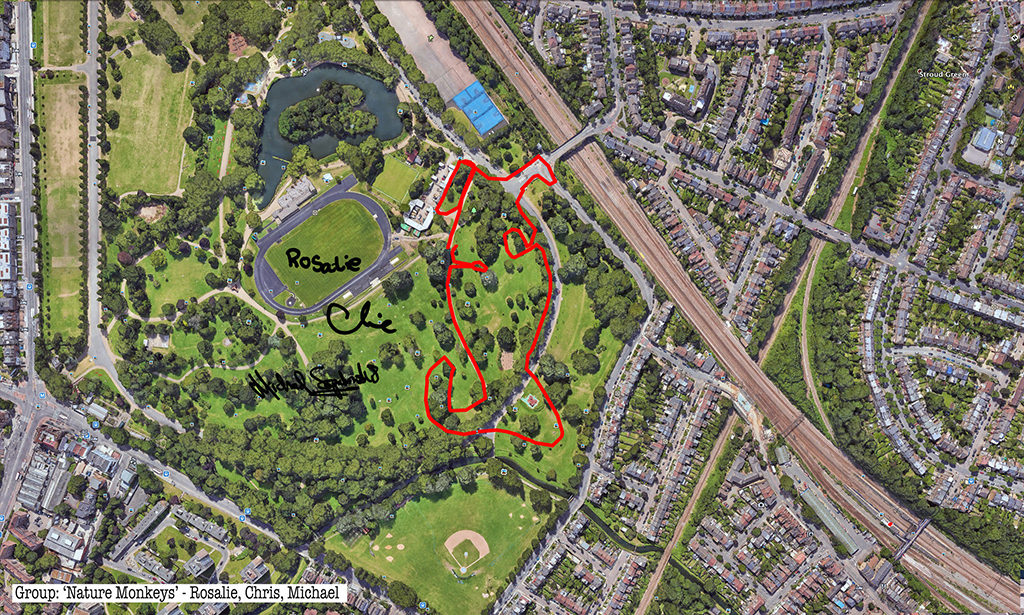
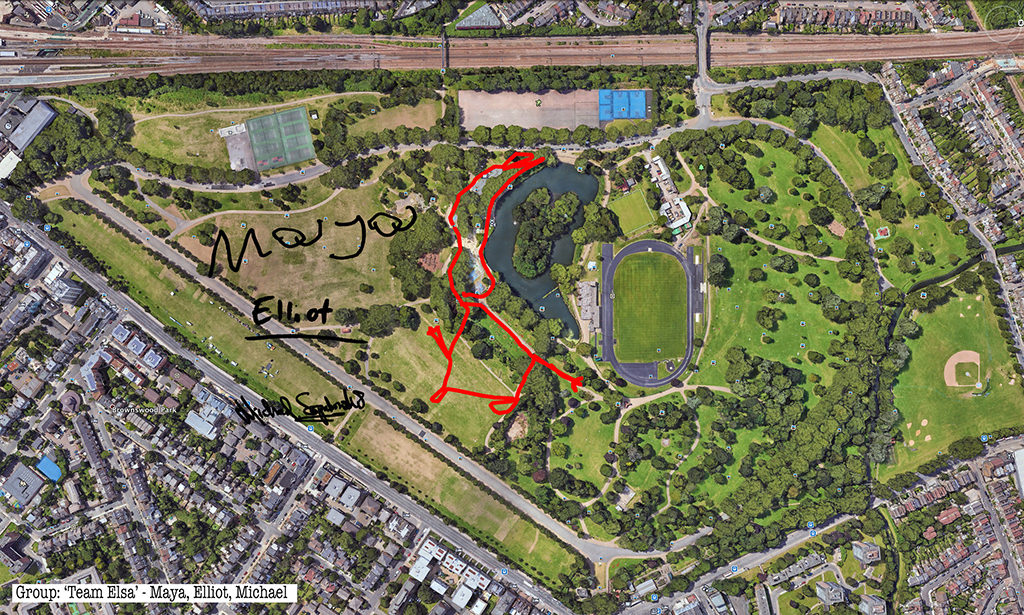
Reversing the premise MTAA’s Whid and River posted a database of video clips of themselves sleeping, eating, inhabiting the space and left it to the online viewer to watch these being digitally assembled (by Flash—remember that?) into a simulacrum of the original over the assumedly continuous period of a year.
Armed, fortified, prepared thus, I set to work—but I still needed a concrete plan and methodology.
Being a keen runner and the project taking place in a London Park in which I had run a 10k not long before (and now having endurance floating near the top of my mind) I felt some kind of park related physical activity would be an element and this would be a way of coming closer to those who loved the park but for whom the art gallery might not be their first association.
But still I lacked the concrete rabbit themed activity which would offer genuine practical, meaningful and autonomous artistic engagement and creation to participants.
I did not want to control what those participants would do but give them a clearly defined (clearly defined enough that all inputs from three separate days of activity could be brought together into a final unified work) and interesting task within which they would need to deploy creativity, focus and skill.
The fad for exercise related GPS devices had previously passed me by but one day whilst running with my daughter, who uses her phone and GPS enabled software to document her running in data and map form, I had a small epiphany—here there (might) be rabbits.
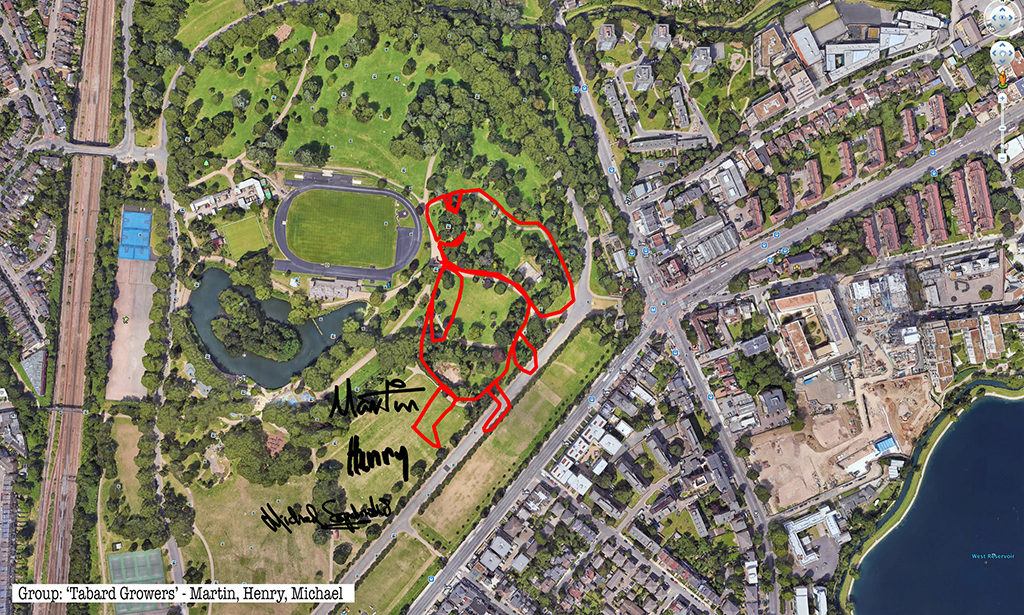
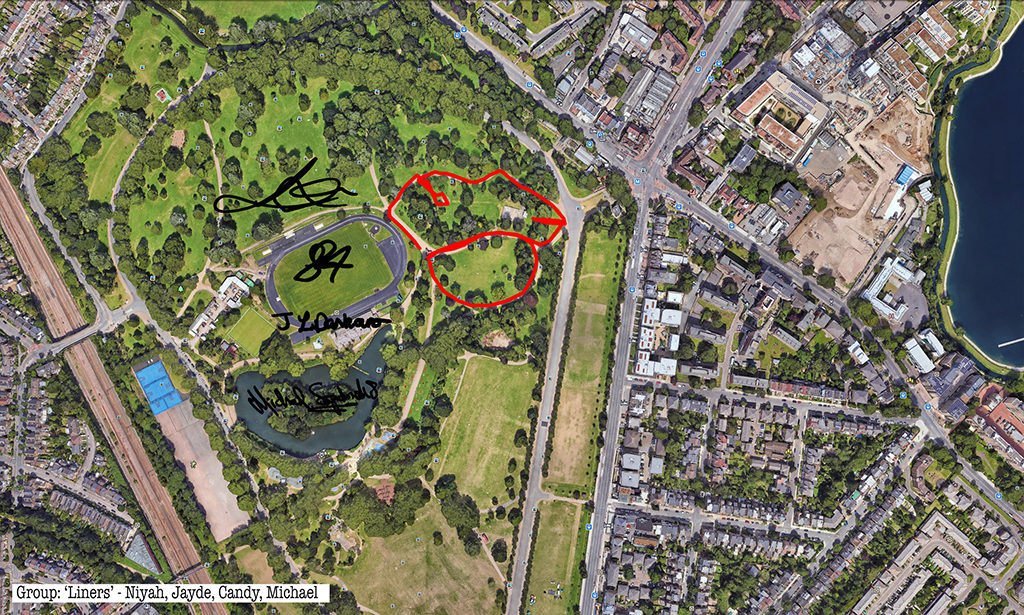
Rabbits, giant GPS rabbits, first planned and sketched by participating teams in marker pen over a satellite image of the park—ears, eyes, paws, body, fluffy tails emergent within its various paths and trails and features and obstructions.
And then, using these maps, we would carefully and attentively walk-out each monster rabbit trapping and freezing it as a succession of data, a series of co-ordinates in the memory of the GPS watch I would wear, finally to be reconstitututed as a continuous line drawing in turn fed back into a fresh satellite view of the park.
But that succession of co-ordinates, actuated by the actual movements of the human body (like a giant pencil lead or nib or brush) will resolve itself into something ancient—line, preconceived and then drawn out by human beings.
Being, together, both the very oldest form of mark making and something blink-of-an-eye recent too (well, as recent as the noughties efflorescence of so-called locative media which I shamelessly pillaged here.)
Inaccuracy in some measure a feature of both ancient and modern—the error margin of even GPS and GLONASS together, two sets of four satellites working in concert; the mix of will and skill and the fallibility and triumph too of flesh and bone and sinew which is part of what thrills and moves us in the arts.
This is what I had in mind.
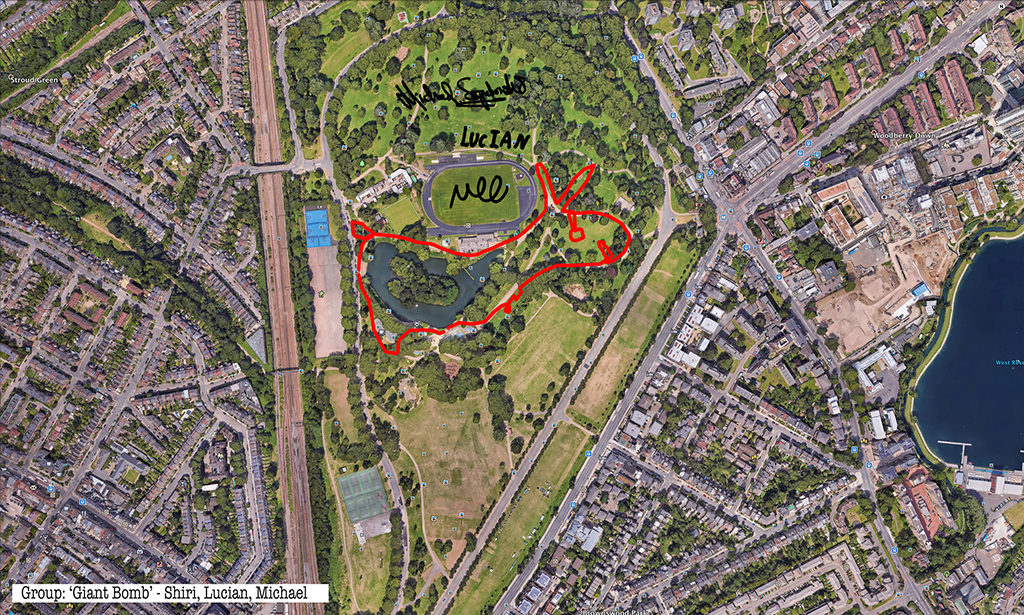
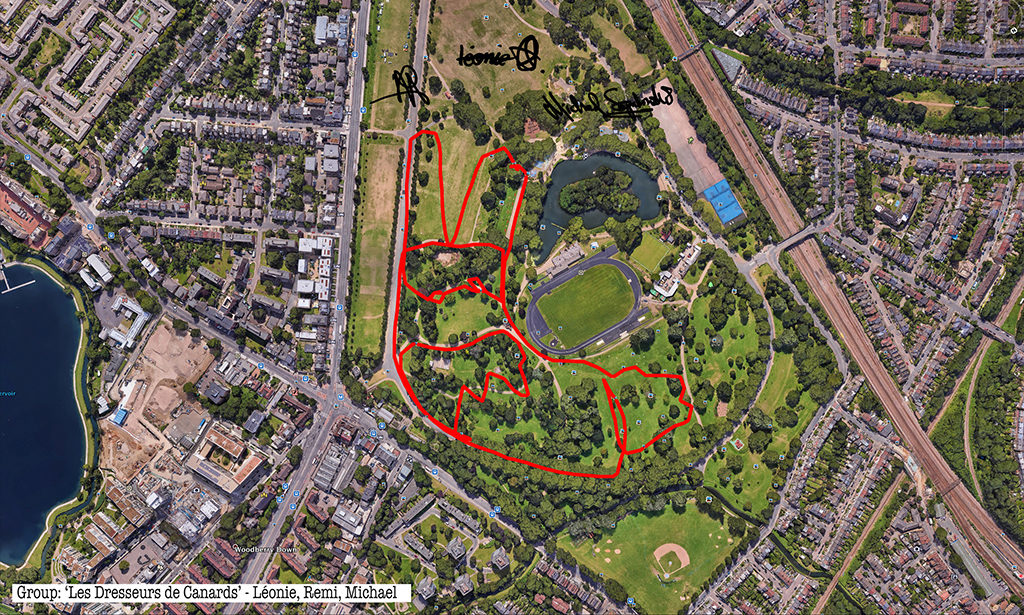
Repeatedly outlining then co-performing an activity which I learned to summarise simply and precisely, almost automatically, one might have thought boredom or a dozy, parroted, routine might threaten.
And how anxious I was each time as to whether and in what way each new team would engage with—buy into—adopt as theirs, as ours—the task.
But how striking the variation both in the simple, basic act of depicting in continuous line each new rabbit-of-the-imagination and the forty minutes lively sociability surrounding that initial sketching and subsequent walking-out.
Balancing the competing claims of making something serious, something with some kind of weight, some satisfying end product, whilst making space for others’ fun and dreams and and will and whimsy is neither easy nor is it trivial.
In the end people seemed to have a good time, they seemed at ease, went at it with a will and—it seems to me—something rich and affecting emerged.
Thanks to all at Furtherfield and thanks—no, not thanks, but credit—to my fellow artists: Alessandra, Anna, Candy, Chris, Elliot, Evgenia, Franc, George, Grace, Henry, Jade, Lenon, Léonie, Lucian, Luka, Martin, Matthew, Maya, Negev, Niyah, Pryle, Rémi, Rosalie, Sara, Shiri, Stefan, Thea and Tyler.
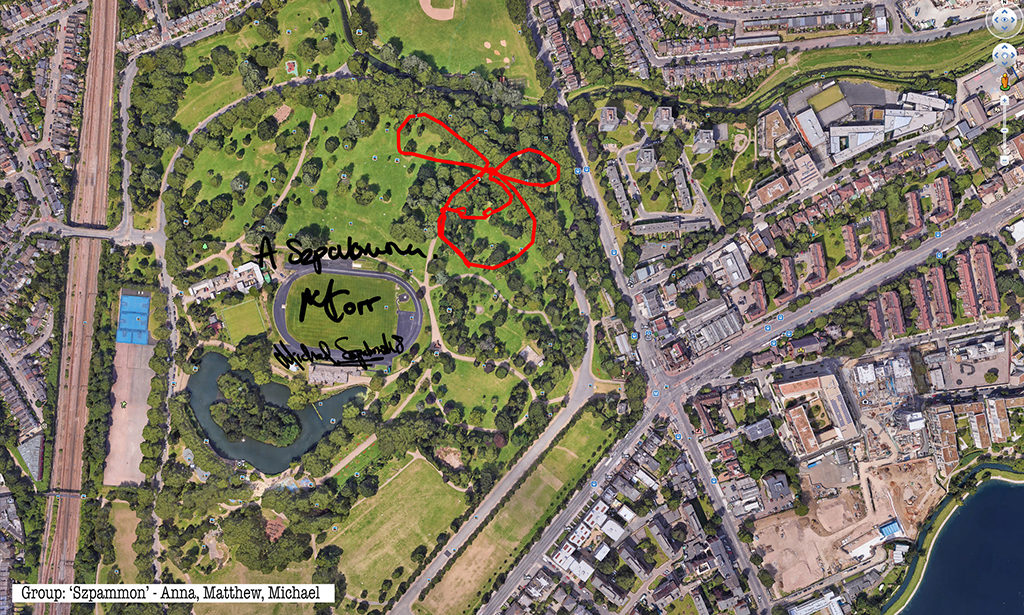
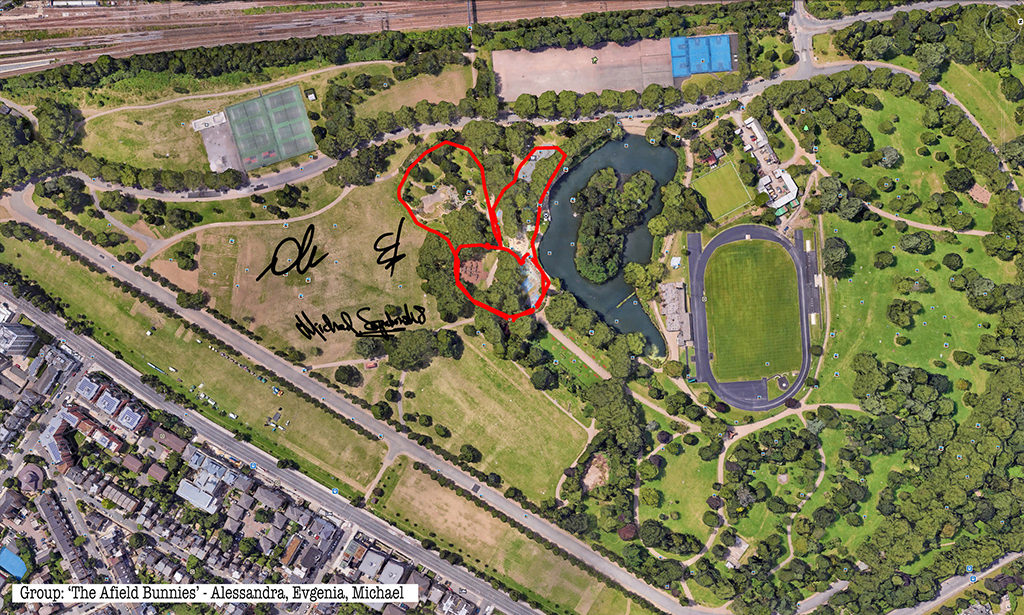
This interview was originally printed in Artists Re:Thinking the Blockchain published in partnership with Torque Editions in 2017.
Marc Garrett: One of many interesting and experimental things about the album Platform, released with Holly Herndon in 2015, is the decision to break away from the perspective of singular genius, and involve a variety of collaborators. This included artist Spencer Longo, Claire Tolan (of Tactical Tech), and Dutch design studio Metahaven. On the 4AD press release page it says that it ‘underscores the need for new fantasies and strategic collective action.’ Under the name of Holly Herndon, along with Holly, you all became a kind of cooperative, collective construction. What inspired you and Holly to explore what could be seen as a decentralized body, or assemblage of individuals as a collective? Or how would you describe your working identity and the importance of this move?
MD: To put it in pretty boring terms, it has become a core part of our mission to be pretty candid about what we do. Holly had been making albums and touring by herself, and then during the early experiments that later became Platform (Chorus and Home) we had begun working together, as we were occupying this tiny apartment in San Francisco, and I was working on this weird net concrete stuff in one room, and Holly was writing for voice in the other, and I think both of us picked up from the ambient sound that the two worked really well together! For the Chorus video we had seen the work of the Japanese artist Akihiko Taniguchi, and really enjoyed the collaborative process of putting that video together, and so then sought out Metahaven, who we’d been in touch with for some time out of aligned interests. Basically most art production at a certain high level is collaborative, and I think it’s just part of our idealistic view on the world that this be transparent and celebrated. Beyond that, when we were coming up with the vision for Platform it also felt very necessary as a political gesture to make a point of the project being aligned with certain political interests, and a politicized way of working and acknowledging others. Working this way has changed my life, and made everything more fun and exciting without diminishing the importance of any individual contributions. It makes for better results, I feel, better general feeling, and also creates these very tangible collaborative connections between fields. It’s also just an interesting experiment to run in music when it feels like so many sonic experiments have been done to death – I’m personally interested in how decentralized practices, collaboration and connectivity, can change the construction and dissemination of music, and ultimately it’s power to be a force in the world.
HH: It sometimes feels like our society is ‘every person for themselves’. We promote hyper individualism at the cost of the planet and social health, and the music industry largely parrots this mentality. We realized how problematic this is, and if we are going to be true to ourselves, then the practice should reflect that concern. It’s been a learning curve for me; learning to not control every single aspect (I tend to micromanage), to hear other opinions, to let go, and not feel threatened if someone else’s idea is better than my own. Releasing my debut album solo was an important step in building my confidence, however ultimately the work itself is the most important, and not the ego. Not to mention that we spend a lot of time on computers, which can be lonely, so working with other people helps us to unplug and see the world around us a little more.
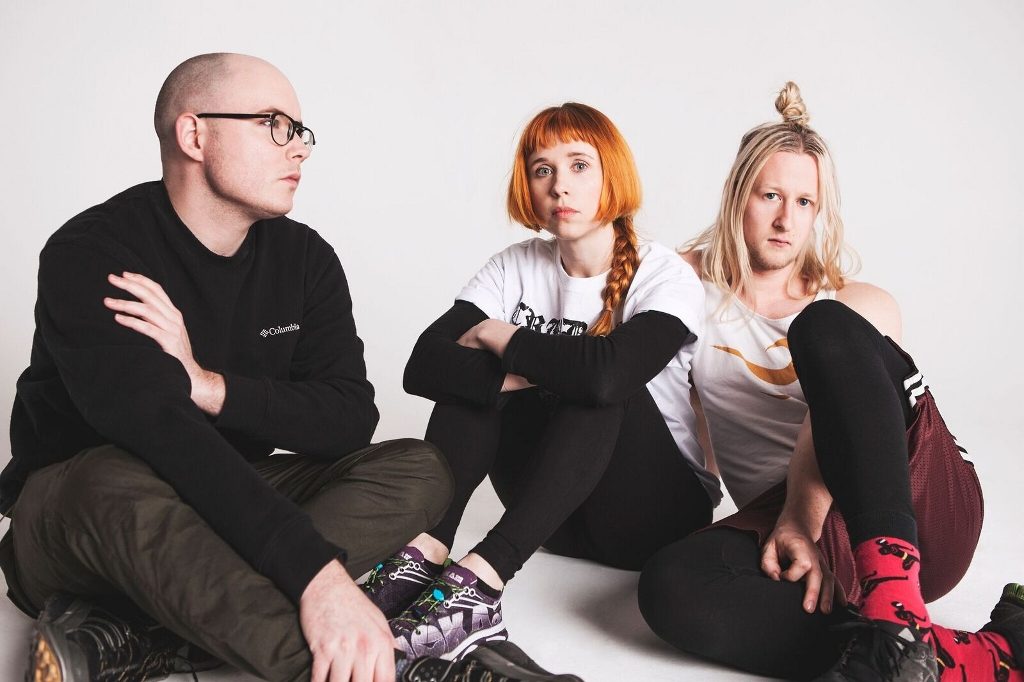
MG: In a world that traditionally, economically and politically, supports the values of individuality above community, or peer to peer collaboration. How did the audience, the music industry, and others in the world (presuming they have) come to terms with this adventurous, creative intention?
HH: It was varied, but overwhelmingly positive. When we were doing press around the record, it was difficult to get some journalists to write about the other artists and thinkers that I was collaborating with, or even just referencing. Those that understood the gesture really embraced the idea, and that successfully provided a platform to highlight everyone’s work.
There are a few industry complications; for example, the project is released under my birth name, so in some ways I am still at the centre of the orbit, which is a problematic professional necessity, but also helps somehow. We used the idea of the Trojan Horse a lot, as in a way my easily understood singular presence served as a gateway into this whole other universe of people. It’s a balancing act, as in various different scenarios you feel different expectations as to what the industry wants; on a pop level they want a simple narrative of my face, and tend to focus on often mundane characteristics such as my gender and education. On other levels you see that the experiment has opened up a different narrative potential, where people’s interest in the record and it’s cast forks off into the direction of their choosing.
It’s really noticeable live, where the audiences have been really supportive. After the shows you experience all kinds of people who come along, hanging out with different people who were on stage – Mat has his own audience somehow, and the same with Colin Self, who often tours with us. As a result of opening up the process and allowing the full breadth of interests and approaches to shine through a little more than is standard, at different shows we have people come up to talk to us about the music, or nerd out about cryptocurrencies and ICO’s, or Chelsea Manning. It feels meaningful, and gratifying for that. We always address the location of the show, whether through the visual or sound, and try to always be alert and responsive. It’s a special privilege to share that time with people, and I think that the concept comes across quite effectively in a live situation as each individual serves a very different purpose in constructing the collective experience.
MD: I think that Platform was received really well. Holly opening up her practice didn’t diminish her signature on the artworks, and I think that it has really won a lot of people over. I think you can feel at our shows that we have a greater principle to what we do, and I think it has maybe made a lot of space for people to conceive of their own experiments and maybe not be concerned at how being ambitious on a conceptual level will affect the ability for the art to travel in the world. Naturally there is also a throttling effect within aspects of the creative industry, where maybe they didn’t want to deal with the bigger ideas around the record, however I feel that the music is strong enough to kind of live in those circles without knowing the story behind it. Overall I think people were refreshed and encouraged by the idea, and transparency of the whole thing. For us now it is a way of being. In my mind, there is more room for individuality to shine when you can guarantee that someone’s work and ideas will be respected and celebrated. The canon of artistic history has omitted so many people’s ideas and contributions for the purpose of having a simpler market narrative, and yet we live in a time when people can and want to dig deeper, and perhaps have a greater capacity for complexity of information – so we want to try and harness that for something positive. Particularly given our interests in subcultural music history, software, crypto etc. there is really no other option but to put the community first. Without community literally none of this exists. Zero. All of our talents and ideas have been incubated in community environments, so channelling that legacy is important.
MG: On Platform you released the track called DAO. I am always interested in shifts between the use of technologies as metaphor and as tools that change practice. So, what was interesting to you about Decentralized Autonomous Organizations (DAOs)?
MD: I’ll let Holly talk more about where DAO came from, with the telematic performance work she was doing at Stanford. Regarding the blockchain, I’ve been developing my own decentralized publishing framework for the past few years, that shares a lot of the same principles as the Ethereum logic, and I’m looking to have it interact with the blockchain in its next iteration. A lot of the spirit behind the crypto community is so synonymous with the models of collectivity we have already been exploring in our work that it’s the logical next step. I’m particularly interested in what this architectural/infrastructural new capacity can mean for the medium of music itself. With Saga you have this whole other performative dimension added to media with the ability to version work, fork it, and have it perform in real time to it’s surroundings online, which I think is a whole other proposition for the medium very much worth exploring. It’s also fascinating regarding the question of attribution and collaboration, as we have grown to understand that the web as it stands currently is very much designed to privilege those who appropriate and curate others creative work and ideas for free – mirroring greater society, it is a winner takes all environment. I want systems of virtuous attribution that do not consolidate the DRM era of copyright takedowns, but instead build markets and new interactions around collaboration, augmentation and live interaction. There is so much more that could be done, and a lot of the blockchain tech emerging offers clues as to how we can get there quickly. There are also a lot of old ideas masquerading as something shiny and new, so you kind of have to read the small print to distinguish what is a genuinely new proposition, but it is our job as members of marginal communities to educate ourselves and anticipate the best options.
HH: DAO came out of a piece that I wrote called Crossing the Interface, with a libretto by Reza Negarestani. The piece was my first venture into telematic performance, where a soprano (Amanda DeBoer) was in another geographic location, but the audience could hear her physical body moving throughout the space using ambisonics. I wanted her to be hyper present, and physically super human, moving in ways impossible to a human body, to be able to be in multiple places in the room at once, as eventually her voice and her body separate, stalking the room. I was trying to find a way to make something so clearly highly mediated, feel extremely personal and embodied at the same time, which seems appropriate for the DAO concept as it exists in the world – this simultaneously complex and distributed network that is also hyper intimate and moves with collective intent.
The vocal work that Amanda delivered while workshopping that performance was really great, so I used some of those outtakes for the vocal work in DAO. With the instrumental I was simply just trying to capture an atmosphere, a heavy energy with lots of wide stereo movement. It’s also really fun to play live with Colin, because he sings the soprano line with live processing, which creates a nice contrast of heavy electronics with extremely expressive alien vocals, taking the entire gender spectrum and contorting it into a circle.
MG: Do you have any plans to formalize any part of your creative collaboration to work on the blockchain?
MD: Holly and I are starting a studio after we finish this next album to more formally develop work and devices that exist in this new frontier, as it has been so instrumental in our discussions for the past few years. I describe it as a frontier deliberately, as if we are to task ourselves with actually experimenting with our work then it feels almost like a duty to get our hands dirty in these areas. We have already started work on two new projects in this domain, but it’s hard to tell when they will be ready to show to people, and what shape they will eventually take.
MG: OK. Last question, in light of the current suppression of the spirit of humanity by despots, and the rich buying up democracy for their own ends, what part do you see artists playing in the world of blockchain, to disrupt the regurgitation of an already bankrupt system?
MD: IMHO, there are two dimensions to this. First, I encourage artists to become familiar with the language and potential of blockchain technology, as there are a lot of opportunities to attempt to re-engineer how we experience, transact and grow community in the arts outside of centralized traditional channels. Real money is being made, and there is a lot of good will amongst the crypto community who invest faith that better systems can and will be constructed using these logics.
I also encourage artists to develop some fluency around the blockchain ecosystem, for exactly the reason that there needs to be wary and critical voices guarding the community from the business-as-usual corporate crowd, who are increasingly flexing their muscles and influencing the course of its development and maturity. By getting involved early, and being vocal, there is an opportunity to intercept plans for how this next internet runs, and who ultimately it will benefit.
The best case scenario is that we can develop our own systems along the blockchain to change music and the arts for the better. Alternately, we need critical voices active within these conversations to avert the worst case scenario of power consolidating itself even further outside of the greater public awareness.
I should say that the third wild card possibility is that blockchain technology is inherently flawed and infeasible once it has been properly stress tested at scale. Irrespective, if your mandate is to be experimenting, and abreast of where things may be going, there are fewer areas of interest more dynamic and potentially transformative. It’s a lot of fun to think about.
Most households have an unsolved Rubix Cube but you can easily solve it learning a few algorithms.
Walking off the Akadimias district and onto the steps leading up towards the entrance of building number 23, I am greeted by a large hall with high red ceilings. The hall is covered with lavish white and black dot marble, and there is a large staircase acting as a guide to the top floors of the manor-like building. This was the home for the Diplomatic Centre of the Third Reich, designed in 1923 by Vassillis Tsagris, and used until 2011 by the Foreign Press Correspondent Union after the Second World War. Since then it has stood derelict and dusty, but for one week, in parallel to the opening of documenta 14, it played temporary host to the artist-in-residence programme of Palais de Tokyo, alongside with Foundation Fluxum/Flux Laboratory, bearing the name Prec(ar)ious Collectives. Six visual artists in residence at Pavillon Neuflize OBC and eight contemporary Greek choreographers envision and fabricate a hybrid space whereby an experimental notion of a community is executed as a situation rather than as a subject. The visual artists and performers involved congregated together in Athens and on site for a two-week workshop in March in order to produce the works. The title, Prec(ar)ious Collectives, is a linguistic amalgamation of the adjectives ‘precarious’ and ‘precious’, implying the state of the collective that performs together.

The opening façade echoes with the humming and reverberated sound of Manolis Daskalakis-Lemos‘ Dusk and Dawn Look Just The Same (Riot Tourism), guiding us towards its installation room. The video installation stands above a mountain of blue powder in a room sectioned off with construction tape. The short sequence of about a minute and a half displays a group of hooded figures, dressed identically. As the soundtrack’s volume begins to escalate, the group progresses from walking to running on the uncannily void and ghostly streets of Athens. A city always bustling with noise is now at its most quiet and pubescent state of the day – dawn. The hooded figures run together and – even though it is in a disordered manner – command your attention and pensiveness until they all reach Omonia Square. The work demonstrates a resistance to a status quo which may be aligned with the political engagement within the city. This is not, however, done in an expected reactionary manner, but instead in a way that promotes uprising through the creation of a meditative state. One cannot help but watch Lemos’ work a couple of times more before leaving it behind and only then noticing the thundering beneath their feet.
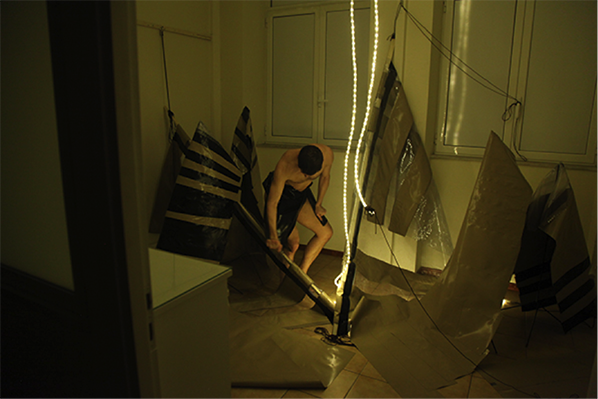
This historic building has a basement and is the temporary home of Taloi Havini‘s performative work. The large-scale installation occupying four rooms consists of PVC vinyls, seemingly discarded or hung from the low ceiling. These PVC vinyls are lit by dispersed and differently coloured strings of light, some are red, others are purple and others are cream. The performance is underway and its performers dress themselves with the PVC vinyl and the lights and jolt their bodies vigorously to the rhythm of the thundering – sometimes in sync, sometimes not. The dark basement is transformed into a cavern of rhythmic delight alluding to a ritual where its power lies in the gathering of people.
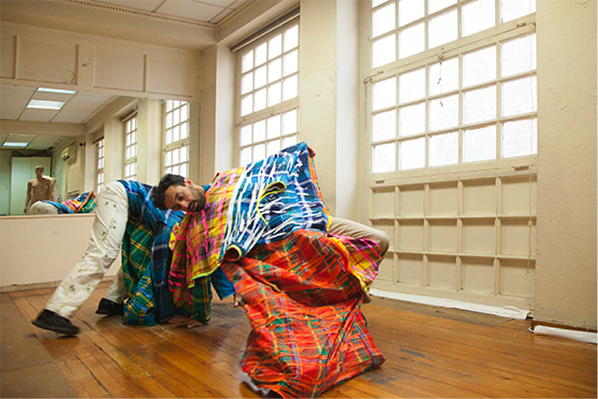
As one inspects the garments of Wataru Tominaga and those who wear them, this synthesis of the PVC, the space and the performers as a gathering appears to be a motif. Tominaga created the garments during a preliminary workshop, with great care and appreciation of how he and others were to utilise them during Prec(ar)ious Collectives. Originally presented on mannequins before being worn and performed, the garments boast vivid colours and patterns, some of them containing animalistic features such as feathers or fur. Those who wear Tominaga’s work perform in such a way as to invent a new form of communication between themselves and their observers. They move and conjoin like animals, sometimes hiding underneath the fabric and at times evoking the traditional Japanese ‘snake dance’. The performance, being in a transitional space between the ground floor and the first floor, naturally spreads itself upstairs whereby the performers not only continue to wear the garments in obscure ways, but additionally interact with Yu Ji‘s agave plants and other objects.
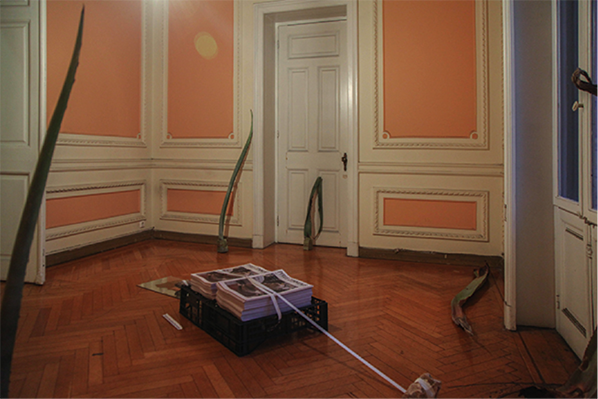
Yu Ji‘s work, Lycabettus Tongue, Oliv Oliv and This is Good For You! Are formed by the use of displaced agave plants, half-fragmented found mirrors and lights. The agave plants interlock with various architectural patterns of the building such as stair banisters, whilst the mirrors and round-ball lights are positioned in ways offering various points of view for observation and appreciation of space. The work revitalizes the architecture of the building denoting its historical vitality and the synergy of the encompassing works into a haunting existence rather than an abandoned one. Here, haunting is used not for means of negative connotations but instead as a form of aloof yet introspective sensation, exasperated further with Lola Gonzàlez‘s video installation in the next room.
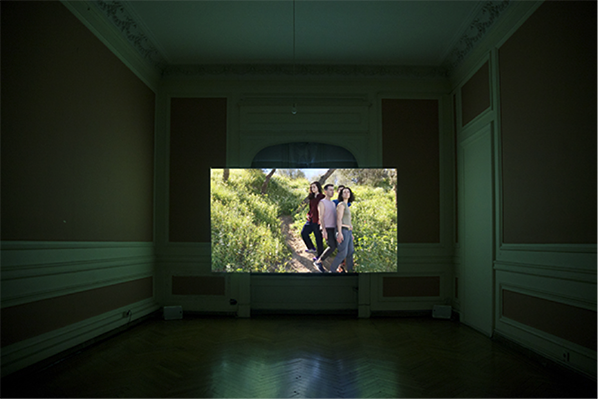
Lola Gonzàlez‘s Now my hands are bleeding and my knees are raw begins with its protagonists split into groups and observing the city of Athens from various points at the top of the hills. The groups begins to move, run and hop together towards a direction down the hill, whilst a chorus of droning voices begin to chant and harmonise. As the groups get closer and closer to the city, Gonzalez transforms the image into a complete inversion, like one you may find in negative photography. The chanting becomes louder as the three groups get closer and closer to their meeting point within the city – the exact space where the video is being showed. They are finally shown entering the building and making their way up the stairs to the room where they vocalize in unison until they fade away from our view. Now my hands are bleeding and my knees are raw alludes to an atmosphere in which the power of gathering together evokes a community whose intention is situated between an uncertain balance of peril and strength. It is the same kind of uncertainty that one finds when exploring the top floor of the building only to discover Thomas Teurlai‘s room of machines and looped functions.
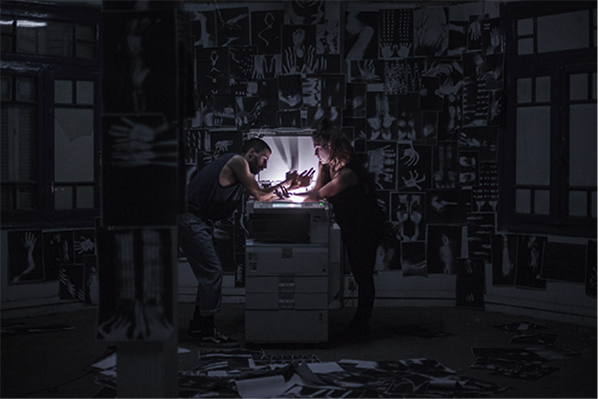
On the top floor, there are still the remnants of neglect, rooms empty of anything but the garbage that piled up over the building’s six years of desertion. Thomas Teurlai‘s Score for bodies and machines consists of a room installation of two printers used by the performers to scan different parts of their bodies. These scans are then plastered on the wall whilst the fluorescent lights constantly trickle on and off. The two performers are attempting to archive as much of the movement involved in their choreography as possible. The looped function of copying and the crackle of its repetitive working-noises do not clash with the choreography but instead drive its energy.
Indeed, it may be the encounter between the building, the communal working spirit of the performers and the result of this effort that defines this rejuvenating energy as a fruitful rebirth of the building’s utility.
To find out more, read Chloe Stavrou’s recent interview with Fabien Danesi of Prec(ar)ious Collectives.
CS: Tell us a little bit about how the collaboration between Palais de Tokyo’s residency Pavilion Neuflize OBC and Fluxum/Flux Laboratory came about. Did this directly contribute to the hybrid of visual/dance performance art or was it the artists’ call?
FD: During two years, the Pavillon Neuflize OBC has worked with the National Opera of Paris for projects at the crossroads between contemporary art and choreography. We wanted to develop this perspective which is a kind of tradition in the history of the Pavilion (created in 2001), if we remember that our institution has a long interest for transdisciplinarity. So the hybridization between visual art and performance wasn’t the artists’ call. On the contrary, we asked them to step aside for collaborating with choreographers. It was really experimental for them.
CS: Neither Palais de Tokyo or Fluxum/Flux Laboratory are situated in Greece. What was the reason for its inception to take place in Athens? Was it because of the traffic Athens would see due to documenta 14 or was it a suggestion by Andonis Foniadakis, the choreographic director?
FD: Since its creation, Fluxum/Flux Laboratory has developed many dance projects in Greece. And it’s due to its founder, Cynthia Odier, that Ange Leccia and myself met Andonis Foniadakis. We started the dialog with Andonis right at the moment of his nomination as the Ballet Director of the Greek National Opera, o Athens appeared quickly as the perfect place for our collaboration. We decided just afterwards to take advantage of the presence of documenta 14 in the city.
CS: The result is quite impressive – specifically since, and correct me if I’m wrong – the work produced was created in only two weeks in March. How did you find the process of working and creating collaboratively in addition to being in an unfamiliar city?
FD: The residents came to Athens for the first time in November 2016. During the first week, we had met the choreographers and dancers but also people who are engaged in the artistic life of the city. We tried to understand and use the pulse of this specific urban energy. We visited some sites for the exhibition and began to question the relevance of our own presence here. The conversations with the choreographers permitted us to create a strong link with Athens and not feel like tourists. We came back for a three-week workshop in March, just before the opening of our show. Between these two stays, we discussed a lot and had decided to start from our situation with the desire to move away from an artificial subject. The notion of the collective seemed a good way of taking charge of what we tried to do – especially because the Pavilion tries every year to create a specific group that gives a specific form to its structure.
CS: Prec(ar)ious Collectives feels like it could be quite nomadic as it is in an unfamiliar environment; however nomadic does not mean it feels odd or out of place – in fact it felt quite the opposite. As a curator, how did you approach Athens and stay conscious of the context(s) surrounding it?
FD: The fact that we didn’t exhibit in a white cube or an artistic space helped us. When we decided to occupy this abandoned building on Akadimias Street, I was sure that we would be related strongly to the city and its history. The context wasn’t outside of the walls – it was here, with us. Of course, we were all conscious that we needed to stay in relation to what was happening in the city. That’s why nobody arrived with their work completed and done. The materials and the main elements of the creations were an artistic answer to this particular context.
CS: I am very curious about the building. I understand it used to be the Diplomatic Centre for the Third Reich during the Second World War. How did you become aware of its existence, and did your decision to curate Prec(ar)ious Collectives have anything to do with the building’s history? If not, what was the reason for selecting this building?
FD: In January 2017, the director of the Pavilion Ange Leccia was in Athens to present some of his work. He visited the exhibition organized by Locus Athens in this space and it impressed him quite a bit. We wanted to work in an abandoned site for underlining the economical and cultural situation in Greece. And Akadimias Street 23 seemed perfect. We didn’t choose it for its history, even if these multiple layers added some density to our proposal. For sure, the different atmospheres of the rooms immediately gave us the possibility to create dialogs between the works while preserving the integrity of each. So, it was a question of ambience in the sense of the architectural conditions aiding the experience of the audience.

CS: I found that a continuous theme within the exhibition was not only the creation of a utopic community, but also an ambience that generates a state of limbo – of transition. Was this a reference to the state of Athens or to the state of artistic production or work?
FD: The notion of limbo is stimulating. And it insists on our «spectral approach». It means that we have tried to give life to this abandoned building. And some installations can be described as floating. In Manolis Daskalakis-Lemos and Lola Gonzalez’s videos, for example, there is the idea of apparition. And even with Taloi Havini’s huge ephemeral camp, we can feel a sort of «in-between» space, archaic and futurist, protective and dangerous. Maybe it was a re-transcription of our impressions about Athens, so appealing and full of energy, but at the same time, so undermined by the political situation.
CS: As a final note, what is the next step for Prec(ar)ious Collectives after its brief residency in Athens? Are there any plans to simulate the experience, albeit differently, again in another context or place?
FD: There won’t be another step for Prec(ar)ious Collectives as a group exhibition. It was really the result of a one-month workshop. But it happens for the best that some encounters initiated in the Pavilion can be developed after the time of the residency.
CS: And any future projects that you will be a part of?
FD: On my side, I will develop a curatorial project next year in Los Angeles in the frame of FLAX residency. Titled The Dialectic of the Stars, I will organize several evenings in different institutions which will permit artists? to drift in the city from one site to another for catching some contradictory parts of the L.A. atmosphere. The idea is to mix French artists and Los Angeles-based artists and to trace a political and poetical constellation.
To find out more read Chloe Stavrou’s recent review: Community Situation: Prec(ar)ious Collectives and documenta 14
Compiler is an experimental platform organised by curator Alisa Blakeney, artist-curator Tanya Boyarkina, artist Oscar Cass-Darweish and choreographer Eleanor Chownsmith, all currently students of MA Digital Cultures, Goldsmiths. The platform is being built in order to “support collaborative, process-driven projects which connect artists and local communities in networks of knowledge-exchange”.
The organisers of Compiler describe it as a kind of ongoing prototype, a structure constantly negotiating the openness to maintain links to varied practices with the coherence of framing, containing, and describing some of the complicated products of digital-analogue interactions. Their focus is looking at what ‘digital culture’ means and having a productive conversation about it.
From 6-8 April, the first Compiler, Play Safe took place downstairs at OOTB in New Cross. The exhibition examined practices of surveillance inherent in “states, corporations, technological spaces and the idioms of digital art”. It questioned whether an increasing intensity of surveillance is linked to control, extraction and politics, or can be understood as a pleasurable phenomenon. People were invited to “Dance a website, see through the eyes of a computer, and have our cryptobartender mix you a cocktail to cure your NSA woes”. The work on show, made by students from MA Computational Arts and MA Digital Cultures (both Goldsmiths), included Eleanor Chownsmith’s software and performance which turned website HTML into dance routines, Michela Carmazzi’s photographic project documenting the reactions of Julian Assange and his supporters following the United Nations’ ruling about his case, and Saskia Freeke’s machine which repeatedly and intentionally failed to create a ticker-tape parade using sensors and fans.

An exhibition on the theme of surveillance creates a strange grey area for itself when shown in a building with nine screens of CCTV footage. Oscar Cass-Darweish’s project made a fairly direct link to the CCTV cameras which emphasised this greyness. The project produced a rendering of the exhibition space by using a function usually found in motion detection processes. This function calculates the difference in pixel colour values between frames at a set interval and averages them, creating a visual output of how machines calculate difference over time.
Another work which made links with the room upstairs was Fabio Natali’s Cryptobar, where following an interview with the ‘bartender’ about your data privacy needs you were recommended a cocktail of data-encryption software. Upstairs you could buy, and drink, a cocktail with the same name (the Cryptobar was part of the V&A Friday Late on Pocket Privacy on 28 April).
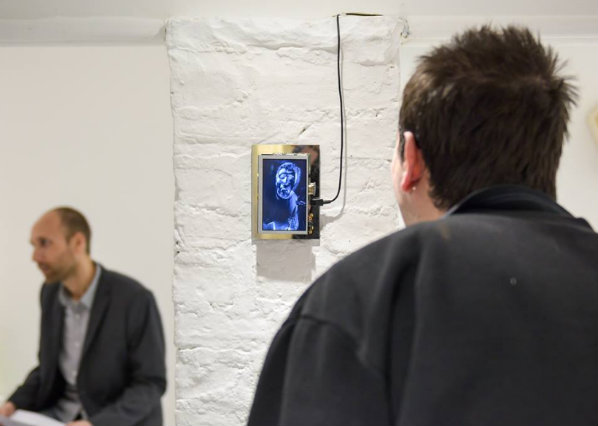
So far, Compiler has made a variety of spaces for conversation about digital culture through both its artworks and its organisation. Each artwork has a different ‘footprint’ of interactions, linking websites to rooms, success to failure, data privacy to financial transaction via consultation, and making interesting connections between CCTV and code, dance notation and HTML, activism and commerce.
An interesting way to read the Compiler platform is as a series of combinations of human-readable codes and machine-readable codes. The platform ‘compiles’ a different combination each time, and each time the output is different. Through this, the interaction of analogue and digital processes is demystified and muddled, in a distinct way. The platform is in its early days, but it seems likely that new connections and new grey areas will appear over the next few months, as Compiler has its second exhibition (again at OOTB) in May, takes part in the CCS conference at Goldsmiths in June and heads in other directions thereafter.
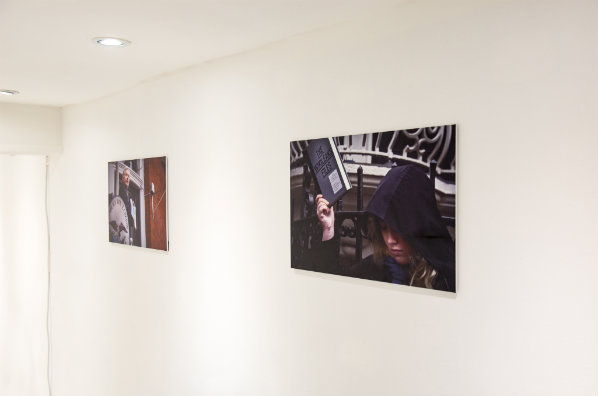
The exhibition offered plenty to play with, while posing complicated problems in relation to openness and experimentation. When I spoke to Eleanor, Tanya and Alisa about Compiler and its aim to engage local communities in networks of knowledge-exchange , we talked about how it’s an impossible and strange aspiration to have a ‘neutral’ venue. While a cocktail can be delicious and engaging, it’s also expensive. While a cafe is, arguably, a less exclusive space than a gallery, OOTB itself is a cafe which targets a specific audience. Drink prices, decor and a host of other factors mean OOTB, like all spaces, is politicised in a particular way. Their venue choices so far will influence, in subtle and overt ways, their future attempts to engage diverse local communities. The organisers of Compiler acknowledge this; their response is that rather than trying to make an artificial neutrality they are keen to move as the platform develops to new spaces and new and different contexts.
A change of context, message, communication style is not easy; nor does it fit with to an easily recognisable politics or aesthetics. Moving into and out of contexts is something to be done carefully and thoughtfully. It seems to me that the Compiler team will have their work cut out, but if they can direct that work in such a way that the platform is able to communicate in multiple ways at once, ‘networks of knowledge-exchange’ could develop between, and in response to, the markers set by the organisers. The question is, how will they develop?
As curator of the exhibition Monsters of the machine: Frankenstein in the 21st Century, I thought it necessary to interview the artists in the exhibition, while it is shown in the magnificent gallery space at Laboral, in Spain, until August 31st 2017. I wanted to get more of an idea of how they see their work in the show relates to the core themes. Mary Shelley’s book Frankenstein; or, The Modern Prometheus, has been interpreted in numerous ways since was written in 1816, and then published anonymously in London in 1818.
Eugenio Tisselli is a Mexican artist and programmer. He is a PhD candidate at Z-Node, the Zurich Node of the Planetary Collegium. Previously, he worked as an associate researcher at the Sony Computer Science Lab in Paris and was also a teacher and co-director of the Masters in Digital Arts program at the Pompeu Fabra University in Barcelona. In his role as director of the ojoVoz project, he has carried out extended workshops with small-scale farming communities in different parts of the world. The ojoVoz project may be accessed at http://ojovoz.net. His personal projects may be accessed at http://motorhueso.net
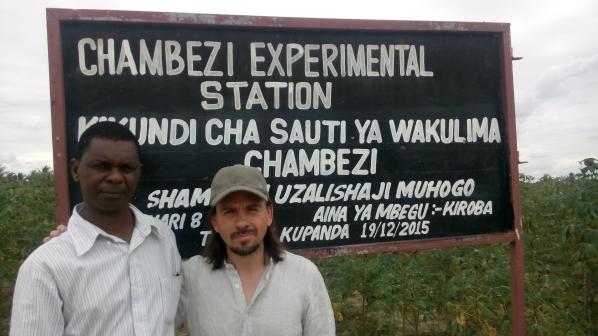
Marc Garrett: Can you explain how and why the Sauti ya wakulima, “The voice of the farmers” project came about?
Eugenio Tisselli: In 2010, I came to realize that the way we feed ourselves is actually one of the main drivers of the accelerated destruction of societies and ecosystems that is currently underway. I felt like I had been living in La-La-Land before the veil was ripped off. My life changed radically. At that time, I was collaborating in the megafone.net project which had worked since 2004 with several groups of people at risk of social exclusion in different parts of the world. By offering an unfiltered communications platform, consisting of mobile and web applications, the megafone project tried to help these groups to make their voices widely heard. But, in 2011, I left the project with the purpose of offering its tools and methodologies to farming communities who wished to seek recognition and explore different forms of communication.

The first opportunity took shape in Bagamoyo, Tanzania, where a group of farmers expressed their interest in trying out these tools. I came in contact with this group through a scientific project that studied the direct and indirect effects of climate change on agriculture. The original goal of ‘Sauti ya wakulima’ was that the farmers would use smartphones and a web application to create a collaborative, audiovisual knowledge base of weather-related events, such as droughts, floods or crop diseases. However, the farmers eventually discovered that they could reshape this goal, and started to use the phones to interview other farmers with the purpose of creating a network of mutual exchange of knowledge about agricultural practices and techniques.
Episodes of fruitful learning have happened since then: one farmer learned the proper way to grow maize thanks to a picture taken by one of his colleagues. Another one learned a clever way to build chicken sheds during a trip to an agricultural fair. He took pictures of the sheds and when he came back to his community, he formed a cooperative for chicken production together with three of his colleagues. I could go on, but the project is still active after six years and that is probably the best thing that can be said of ‘Sauti ya wakulima’. It is alive because farmers find it useful, and it’s inspiring to learn from them that the mutual exchange of knowledge can become a key to a more resilient and interesting life. To me, the agricultures depicted in the photos posted by the Tanzanian farmers are not echoes of ‘the past’, but pathways to the future.
MG: What particular themes in the exhibition do you feel relate to the “The voice of the farmers” installation?
ET: I imagine ‘The monster in the machine’ not as a horrible, threatening ghoul, but as a weird and tricky creature made of language. The ‘body’ of this creature is made up of what we would call ‘principles’, ‘values’ and even ‘ideologies’. And it silently lurks inside the technological artifacts we use every day. The smartphone, for instance, epitomizes the ideal 21st century citizen: a self-sufficient, competitive and efficient individual. And, indeed, the monster that lives inside our smartphones is made of those values: its presence is inscribed in the device’s circuits and from there it casts its spell. What I mean is that technologies are not neutral. They are not empty: they are haunted by whispering ghosts.
If you look at technologies used in agriculture, you will also find a multitude of monsters that softly dictate from the insides of things. Perhaps not by coincidence, genetically modified (GM) seeds speak the same things as mobile phones, only with different words. They tell farmers: “stop sharing seeds with your community, it’s a waste. Become an entrepreneur, there are shitloads of money to be made! Buy me! I’ll make you rich!” The sad thing is that these words are a trap: farmers ultimately become entangled in monetized loops that are beyond their control. Desperation sets in and, in absurdly horrible cases, such as GM cotton farmers in India, suicide becomes the only exit. But there are, indeed, other exits.


It is possible to rewrite the values and ideologies inscribed in technologies, in order to make them speak words that will do less harm. This is one of the key components of Sauti ya wakulima. From the very beginning of the project, the farmers agreed to redefine the smartphones as communal tools for collaborative documentation. They still share them and, when it is someone’s turn to use one, that person knows that she will not be taking pictures and recording sounds with a personal device, but with one that belongs to the group. These dynamics of sharing can create or strengthen reciprocal bonds. Renalda Msaki, a farmer who participates in Sauti ya wakulima, once said that the project had brought the group closer together. When I reflect upon her words, I can see how the monster in the machine can be transformed into a gentler creature that, nevertheless, remains weird and tricky.


MG: What role do you think the artist has when dealing with questions such as Monsters of the Machine exhibition?
ET: I think the artist can take up an incredibly vast range of roles when dealing with machines. But, whatever one does, one shouldn’t be naive about technology. Happily, the times when media artists created huge and complex pieces filled with little technological wonders just because it was exciting to celebrate their ‘magic’ is (almost) over. I used to say that (most) media art was the smiling face of techno-capitalism. Now I would add that, while technology was generally understood as a mediator between us and the world, it has now become a vector that uses humans to create its own mediations with the world. The roles have shifted, and things have taken a perverse turn. There’s a growing chorus of techno-objects that insistently asks us, humans, to drill the Arctic, build pipelines, burn coal, destroy forests and dig up more minerals. And we obey: we must feed the monster. Artists who approach technologies as materials to play with need to be aware of these power relations. We must acknowledge that technologies of all sorts have become overpowering actors that like to command.
Tisselli warns us that we need to be more aware of our responsibilties when implementing technologies into the environment. An important factor of the exhibition was to bring about a vision where the art was not just one type of art. This means different engagements in how we see and work with technology, are reflected as part of its context. Also, technology is not only a human skill, ’21st century scientific studies indicate that other primates and certain dolphin communities have developed simple tools and passed their knowledge to other generations.'[2]
As I write this conclusion, ‘Trump is poised to sign an executive order that will dramatically reduce the role that climate change has in governmental decision-making. The order could impact everything from energy policy to appliance standards.'[3] We live in a time where US policies are written via Twitter, and the rich are typically risking ours and the world’s future for their own ends. Tisselli and the farmers, remind us that, we need to be connecting with the land once more. We need to reclaim the soil before it is lost forever.
Mary Shelley’s distrust of the patriarch in the form of Dr. Victor Frankenstein, is as relevant now as it was 200 years ago. ‘Her portrayal of Dr. Frankenstein as an egocentric obsessive who will stop at nothing until he completes his mission in bringing his creature to life; represents man’s blind quest in pushing on until the precarious end, at whatever cost.'[4] Tisselli echoes this with his own critique towards artists working in technology. If we are to rethink what innovation can be now, what would that look like if we were to update it in a way that included indigenous voices, other levels of equality, and practices beyond what now seems like tired, machismo, and over obsessive, tech-enchantment?
The ‘Monsters of the machine: Frankenstein in the 21st Century’ exhibition is on at at Laboral, in Spain until August 31st 2017. http://www.laboralcentrodearte.org/en/exposiciones/monsters-of-the-machine
Those involved in the Sauti ya wakulima / The voice of the farmers project.
The farmers: Abdallah Jumanne, Mwinyimvua Mohamedi, Fatuma Ngomero, Rehema Maganga, Haeshi Shabani, Renada Msaki, Hamisi Rajabu, Ali Isha Salum, Imani Mlooka, Sina
Rafael.
Group coordinator / extension officer: Mr. Hamza S. Suleyman
Scientific advisors: Dr. Angelika Hilbeck (ETHZ), Dr. Flora Ismail (UDSM)
Programming: Eugenio Tisselli, Lluís Gómez
Translation: Cecilia Leweri
Graphic design: Joana Moll, Eugenio Tisselli
Project by: Eugenio Tisselli, Angelika Hilbeck, Juanita Schläpfer-Miller
Sponsored by The North-South Center, Swiss Federal Institute of Technology – Zürich
With the support of The Department of Botany, University of Dar es Salaam (UDSM)
Plantoid (2015) by Okhaos is a self-creating, self-propagating artwork system that uses blockchain technology to gather and manage the resources it needs to become real and to participate in the artworld. Structured as a Decentralised Autonomous Organization (DAO), once it is set in motion the code of the Plantoid system combines the functions of artwork, artist and art dealer in a single piece of software.
As its name implies, the physical Plantoid artworks are cyborg-looking welded sculptures of flowering plants. Flowers are a popular icon of naturalised aesthetics in art and culture. Their aesthetic and art historical appeal makes them an effective subject for subversion. Radicalized flowers wander through recent art like triffids through the English countryside. Helen Chadwick’s “Piss Flowers” (1991-2) are a proto-xenofeminist riposte to idealisation of nature and the body. Mary Anne Francis’s “The Blooming Commons” (2005) combines the ideas of organic and creative fecundity to help artist and audience consider how making art open source affects its aura. Plantoid can easily be cast in this tradition.
The physical form of Plantoid is determined by its blockchain presence, which represents an advance on the state of the art. The Bitcoin blockchain is a database that represents control of resources. Most simply these resources are amounts of Bitcoin but we can encode information representing other resources – and the right to control them – into the blockchain as well. Current general purpose Bitcoin blockchain-based systems such as Counterparty can easily represent tokens for games, for reward and voucher schemes, or for stocks and shares. Placing these on the blockchain does not magically improve them over existing means of issuing them but it does reduce their barrier to entry and make securing and maintaining them easier. It also defamiliarises them by placing them in a new context and makes them accessible and thereby inspirational to new audiences. Melanie Swan turns this idea up to 11 in her excellent survey of the state of the art and its future potential “Blockchain“, describing the application of the idea of blockchains ultimately to the global economy and even the human mind.
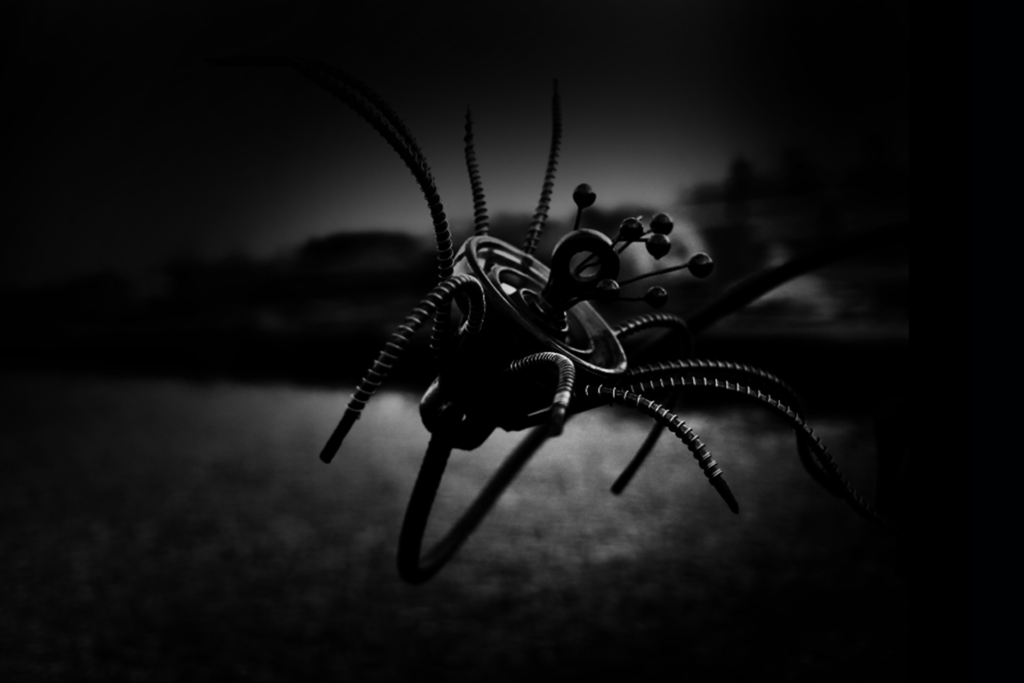
Beyond tokens, the blockchain can be a cheap and effective database of existing property and rights, including recording Free Culture licensing. It is simple to create such a system, I made the first one for artworks based on Ethereum myself. It cannot be an effective means of policing DRM (as DRM is inherently broken) and must not be treated as a means of rolling back the limits of and exceptions to the existing property and copyright regimes or of creating new entitlements ex nihilo. This would turn a technology with great (if contentious) potential for liberation into a tool of exploitation. Making a GIF of Apple’s new emoticons and selling the blockchain title to it for $250 reflects existing social pathologies rather than new technological or artistic affordances.
The technobiophilic machine-nature-form hybrid nature of Plantoid is described by Okhaos in terms that cast cryptocurrency as metabolic and reproductive resources. To quote the project page:
Perhaps the initial Plantoid will need $1000 to fully turn into a blossom. Whenever that particular threshold for the Plantoid is reached, the reproduction process starts: the Plantoid only needs to identify a new person or group of persons (ideally, a group of artists) to create a new version of itself. Given the right conditions, the Plantoid is able to manufacture herself, by executing a smart contract that lives on the blockchain, and has the ability to commission welders, companies, and other beings to build and assemble a similar being.
It’s here that we see how Plantoid represents an advance on existing systems. The parameters of each physical Plantoid are encoded on the Ethereum (rather than the Bitcoin) blockchain as smart contracts, representing the economic and manufacturing logic and the aesthetics of its production as a kind of genome. Plantoid is an active artistic production agent rather than a passive registry of existing art.
The defamiliarising effect of the blockchain allows us to unbundle the collections of rights and responsibilities that make up roles within the mainstream artworld. Paying for the creation of art, its storage and restoration, transport and exhibition. Inspiring, designing, manufacturing, promoting, experiencing, critiquing and art. The artist, the gallerist, the critic, the installer, the attendant. A new territory like the blockchain allows us to shake things up rather than to try to double down on existing relations and distribution of wealth in order to extract new rents.

Plantoid opens up the roles of artistic production in precisely this way. It uses the structure of a DAO to incentivise the funding, governance, production, exhibition and reception of Plantoids in a virtuous circle (a positive feedback loop of production). None of this confers ownership or property rights over the physical Plantoid artworks on individual human beings. Their relationships are closer to those of patronage, crowdfunding, or tipping but unbundled further. There are technological precedents for this such as the way Aaron Koblin’s “The Sheep Market” (2008) commissions drawings from clickworkers, Caleb Larsen’s “A Tool To Deceive And Slaughter” (2009) manages its own sale, the way Bitnik’s “Random Darknet Shopper” (2014) orders goods for delivery to the gallery, or Imogen Heap’s release of the single “Tiny Human” (2015) using Ethereum smart contracts
From the project page again:
Plantoids are part of an ecosystem of relationships that is powered by two driving forces: aesthetic beauty and automated governance. Plantoids subtly motivate these interactions, partly through their form and physical beauty, but also by empowering people to participate in their governance. Participants (that is, active members of the DAO) are able to decide on such things as where the Plantoids may be exhibited, whom they might visit, and exactly how they are to be reproduced.
When it receives funds by the audience, the Plantoid evolves and turns into a more beautiful flower, by e.g. moving around a means to gratify the donor and progressively opening up its petals as more and more funds are stored into its wallet. Once enough funds are secured, the Plantoid can use this money to reproduce itself, by commissioning a third party to produce a new Plantoid.
The smart contracts that instantiate these relationships contractually direct human actors to govern the DAO, to manufacture new Plantoids, and to exhibit (and return) the work. The danger of such DAOs is that of any embedded socioeconomic intent – whether corporations, charitable trusts or high frequency trading bots. We may end up with an economic Skynet that reduces us to peons in an algorithmic gig economy, any reflection of our actual needs or desires (such as to make art) perverted by the incentives encoded into an inhuman system. Plantoid exists to ensure the production of art, and its realisation by human artisans. Given the rockstar economics of the artworld and the continued collapse of socioeconomic support for artists outside it that production is badly in need of new means of continuance. The art-economic equivalent of “grey goo” – polychrome goo? – or Terminators armed with spraycans rather than phased plasma rifles seem much less likely scenarios than art DAOs becoming lifeboats or TAZes for the funding of art that is not simply decoration for the 1%. Plantoid’s explicit involvement of human producers in a comradely relationship makes it more a node in the network of collaborative and mutually supportive relationships in the peer economy than an Uberization of artistic production.
Any gap between the ambition and the technology of Plantoid can be crossed by its autopoeitic nature. Ethereum contracts cannot yet manage Bitcoin balances, for example, but using Ethereum’s existing native cryptocurrency “Ether” or one of the proposed systems for managing Bitcoin accounts from Ethereum would address this. Art’s function here, as in its development of religion at the dawn of history, is to create demand for the development of new means of production and relation that a dryly complete rational plan could not reach. Appropriately enough for such a hyperstitional work I discovered it via the blog of renegade philosopher Nick Land.
Without wishing to ventriloquise or reframe its achievements, Plantoid is an exemplary realisation of the potential of mutual interrogation and support of art and cryptocurrency. It’s an art project that uses cryptocurrency and smart contract systems to materially support itself. And that project makes the still abstract potential and operation of cryptocurrency and smart contract tractable to consideration through art. I for one welcome our new hyperstitional DAO artwork overlords.
This work is licensed under a Creative Commons Attribution-ShareAlike 4.0 International License.
Choose Your Muse is a series of interviews where Marc Garrett asks emerging and established artists, curators, techies, hacktivists, activists and theorists; practising across the fields of art, technology and social change, how and what has inspired them, personally, artistically and culturally.
Annie Abrahams was born in the Netherlands to a farming family in a rural village in the Netherlands. In 1978 she received a doctorate in biology and her observations on monkeys inspired her curiosity about human interactions. After leaving an academic post she trained as an artist and moved to France in 1987, where she became interested in using computers to construct and document her painting installations. She has been experimenting with networked performance and making art for the Internet since the mid 1990s. Her works have been exhibited and performed internationally at institutions such as the National Museum of Modern Art in Tokyo, New Langton Arts in San Francisco, Centre Pompidou in France, Academy of Fine Arts in Helsinki and many other venues.
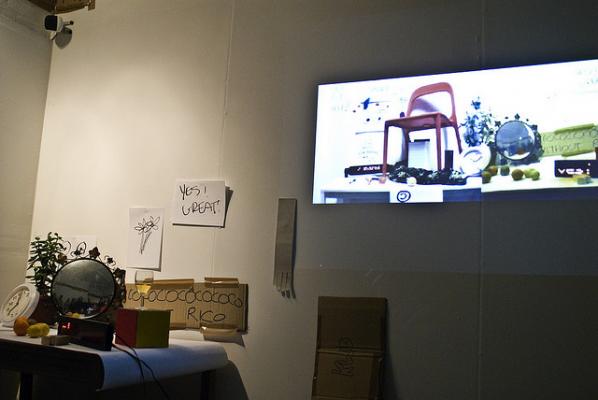
Through the years we have got to know Annie Abrahams via various online, networked artistic collaborations. In 2010, she had a her first one woman show If not you not me in the UK at Furtherfield’s earlier gallery space, the HTTP Gallery. Since then, she has shown at another mixed show at Furtherfield’s current space in Finsbury Park, London. This exhibition, Being Social included other artsists such as Karen Blissett, Ele Carpenter, Emilie Giles, moddr_ , Liz Sterry, and Thomson and Craighead.
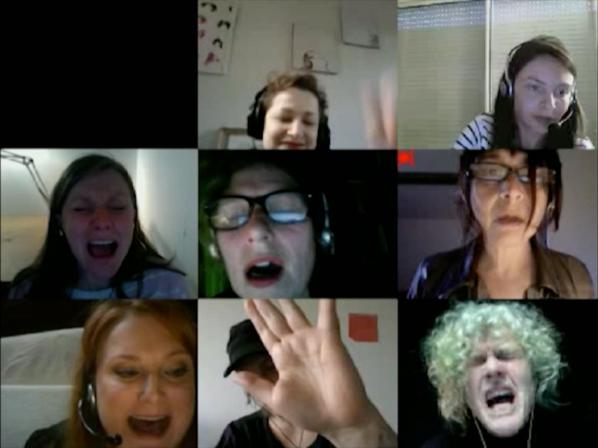
She is known worldwide for her net art and collective writing experiments and is internationally regarded as a pioneer of networked performance art. She creates situations that reveal messy and sloppy sides of human behaviour; capturing real-time moments to illucidate a reality and opening it up, making it available for thought. In an interview with Bomb Magazine in 2014 Abrahams said “My first online performance was my first HTML page. Even then I considered the Internet to be a public space, and everything that I did in that public space asked for a reaction.” [1]
Marc Garrett: Could you tell us who has inspired you the most in your work and why?
Annie Abrahams: Life itself, the people I meet. Until now my basic needs in life have hardly been threatened and so the only real problems I encountered were relational problems. Who are you? Why are you different from me? What does it mean to respect you? Is opposing you necessary? And if so, how can I do that?
MG: How have they influenced your own practice and could you share with us some examples?
AA: My practice was always based on the difficulty of having to live in a world where I don’t understand anything. Every person I meet opens up another view on this impossibility. Sometimes I write short posts about my encounters. Lately I did one on Shirley Clarke and one on Ed Atkins’ No-one is more “Work” than me. aabrahams.wordpress.com
MG: How different is your work from your influences and what are the reasons for this?
AA: My work is made from these influences. In the beginning I thought this was not ok, because I was educated with the idea that you have to be “unique” and make unique artworks. But now I am proud of my sensibility for what others say and do and the way I work with that.
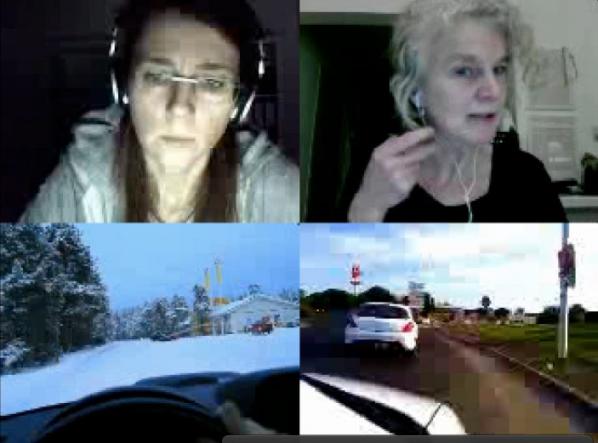
MG: Describe a real-life situation that inspired you and then describe a current idea or art work that has inspired you?
AA: Last summer I made a book called from estanger to e-stranger. Ruth Catlow described it as “all-at-once instruction manual, poetry and a series of vignettes of contemporary encounters in language-less places”. There you can find ideas and art works that inspire me, but in general I am not driven by inspiration, my acts are driven by irritation, my art by incomprehension. Art works sooth, make things bearable and sometimes incite to look beyond habits. Btw I am still continuing my research on how language shapes culture, society and me. http://e-stranger.tumblr.com/
MG: What’s the best piece of advice you can give to anyone thinking of starting up in the fields of art, technology and social change?
AA: Stay close to your own concerns, to things you can have a concrete influence on, observe the results of your actions, pay attention, adapt, and always smile to your neighbour in the morning.

MG: Could you recommend any reading materials or exhibitions past or present that you think would be great for readers to view, and if so why?
AA: For years now every now and then I’ve come back to Darren O’Donnell’s book “Social Acupuncture” and always again I say to myself, “yes, you can think and act art and politics together. Please have a look at the Mammalian Diving Reflex group’s (he is their artistic director) methods. http://mammalian.ca/method/
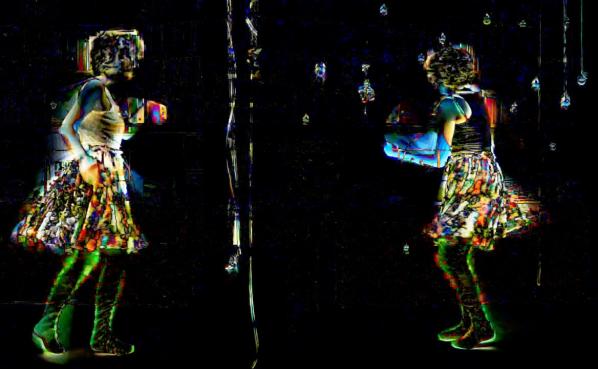
Featured image: A is for Art, B is for Bullshit: A history of conceptual art for badasses, book by Guido Segni 2015
“Outside of the Internet there’s no glory” Miltos Manetas”
Guido Segni, is an Italian artist whose activity began in the fields of hacktivism and Net Art in the 90s. As part of his practice he questions the nature of identity that resides on the Web (acting under many fake identities, like Dedalus, Clemente Pestelli, Guy McMusker, Angela Merelli, Anna Adamolo, Guy The Bore, Umberto Stanca,Silvie Inb, Fosco Loiti Celant, Guru Miri Goro, Leslie Bleus, Luther Blissett) and the value of digital activity with projects like 15 Minutes, anonymous, and The middle finger response.
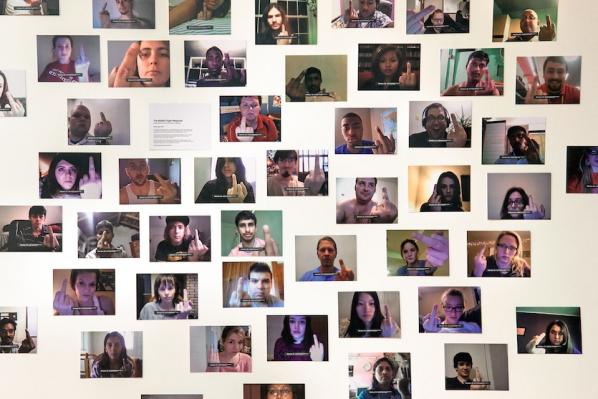
The Internet and lists are two things that have always been together, especially now many of us use social networking platorms such as Twitter and Facebook. We can’t track how and when the first “Top 25/10/5” appeared on the Web, but it’s for sure one of the most frequent ways to gain a lot of attention from Internet users, and it can make you feel as if you’re trapped in a never ending, online fast-food loop. However, when I found out that Guido Segni had created his own version of a top 25 list I was naturally intrigued, so I decided to ask him what it was all about.
Filippo Lorenzin: How and when did you start working on Top 25 Expiring Artists?
Guido Segni: It all started in 2013 after a discussion with Luca Leggero, an artist friend of mine who was working on a piece about the ephemerality of internet art pieces, and it stimulated in me many thoughts on the subject. In the beginning I just wanted to create a sort of memento mori, a list of all artists’ expiring websites. It was only a few months later I introduced the idea of it as a competition, transforming the work into an ironic top artists ranking list, based on the expiration date of their websites.
FL: Could you tell us how it works and how are artists ranked on the list?
GS: It works as many of the other ranking lists you can find on the web. The difference stands on the criteria. While many lists circulating on the web (Top 10 young artist to follow, Top 5 internet artist, etc) are often based on unintelligible criteria, in TEIA (Top Expiring Internet Artists) the criteria are as clear as useless and absurd: the whole list is in fact ordered by the expiration date of the artist website. The nearer is the website expiration date, the better ranking the artist website will obtain. It’s a democratic but very competitive race where everyone can reach the first position even if just for a day. Top 25 Expiring Artists is automagically updated every day – you can only see the top 25 but actually the project counts more than 50 artists. To be included in this list an artist just needs to make an email submission sending the URL of his/her/its website.
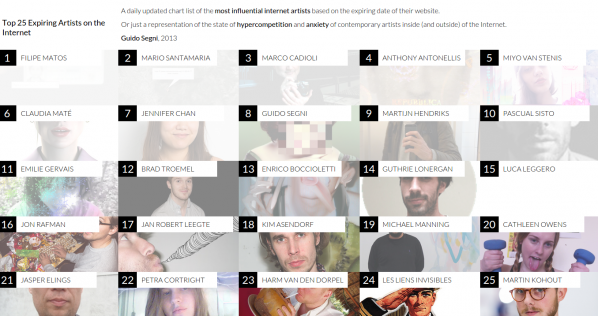
FL: This work has many interesting points to talk about, but I would start with lists-related questions. Does ranking artists on the basis of their aim to be not forgotten mean to highlight a typical behavior of all online users or does it specifically relate to web-based artists?
GS: Actually, the piece is mainly focused on web-based artists. Working with digital based technologies, I’ve always had to face the problem of ephemerality: every year I need to renew the subscription to the hosting service of the many website I own, I periodically have to upgrade the technical environment of my works and often I also need to recode them from scratch in order to keep them all working. That’s why I decided to transform this everyday battle with technology into an ironical and nonsense race for artists, aiming to survive to time.
FL: In the list there are only artists mostly interested in digital issues and I know most of them by person. I have even worked with some of them in previous years and this makes me quite comfortable, like if it was more a sort of reunion with old friends, rather than a competitive race. Is this part of the project or would you like it to be more harsh?
GS: Remember the list is a top 25 Internet artists, so it was natural for me when I started the project to choose the first group of artists mainly involved in digital issues. That said, apart from that memento mori feeling which I’ve discussed before, I was also interested in creating a believable and ironical representation “of the state of hypercompetition and anxiety of contemporary artists inside (and outside) of the Internet.” Probably it’s because I’m a nostalgic of the early days of the Internet – the period of the net utopia – but what I see today is more and more a rising feeling of egotism and selfishness. So what I tried to do is just to stress this contraposition between the brotherhood – what you call the reunion with old friends – and the competition, a perpetual struggle between peers for not being forgot.
FL: This project is ironic. You can say this just by seeing how you mimick aesthetic and text styles of online services like Klout or Google Rank. It seems to me that this is a recurring feature in your works – like in The Middle Finger Response. Is it true?
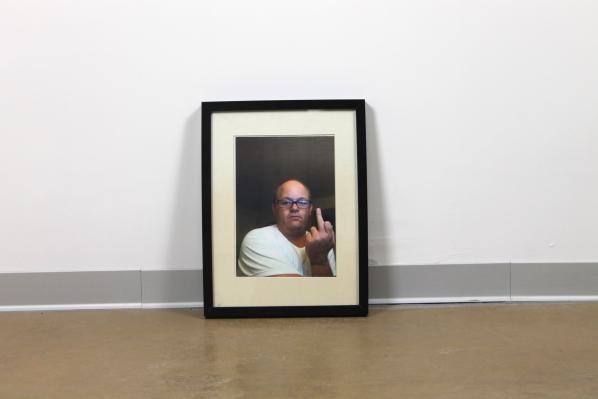
GS: It maybe depends on the fact that I’m from that particular area in Italy (Tuscany) where you can’t either take yourself too seriously. Or maybe it depends on the fact that irony itself is an important feature you can find over all the formats on the Internet. But I agree with you that willing or not the use of irony is a recurrent and strong component of my works.
FL: I’m interested in how people (me too, yes) sign to online services that promise them to rank their online lives on the base of their influence capacity. It’s like watching a mirror made on quantification premises, built by the same system that push you to post more and more about yourself and your incredibly unique existence. In which way this project is related to this phenomenon?
GS: The main intent of the project is to ridicule lists of any sort. But said that, I think the reason why lists – as a cultural form – are so popular is that they have the power to simplify the representation of complex phenomena of reality. So the various “Top artists to discover”, “Top 10 rock bands” or the “Most influential person in the world” are just examples of a fictious narration which give the apparent comprehension of the real. And this is particulary true in an over-polluted space like the Internet.
FL: In the brief conversation we had previously on Twitter, you said to me that you would like to make other versions of this project. Can you tell me something about this?
GS: I have many ideas about these new versions but unfortunately I’m a very slow man and I still don’t know how and when they will be released.
FL: You worked on the branding of people also with 15 Minutes, anonymous. Could you tell us if and how there is a connection between that work and Top 25 Expiring Artists?
GS: To be honest, at that time I hadn’t in mind these connections. From a certain point of view I think they are very different form each other, but it’s true that they both implicitly move around the concepts of fame and anonymity in opposite directions. While in Top 25 Expiring Artists the expire date is an ironic way to reach a sort of fame – even if only for a day – in the case of 15 Minutes, anonymous I focused on the algorithmic aspect of transforming a very large number of pictures of pop symbols into anonymous and abstract pictures.
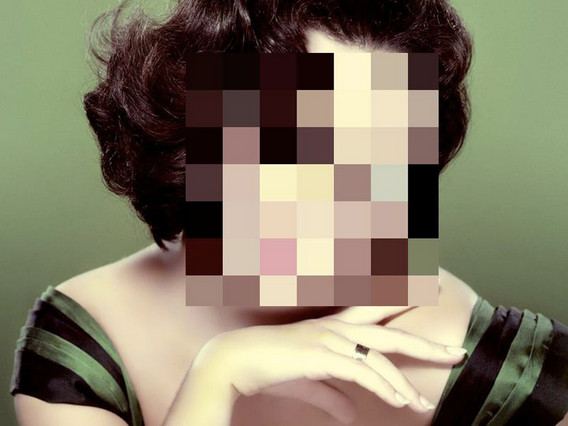



FL: Again, the anonymity and the individual are two of the main questions in your research. This happens also with Proof of existence of a cloud worker, and I recall me Middle Finger Response. What do you think?
GS: Between 2013 and 2014 I made several experiments with crowdsourcing and, yes, Proofs of existence of a cloud worker and Middle Finger Response have many points in common apart from that they are projects based on Amazon Mechanical Turk platform. Basically they both document and display what crowdsourcing is from the point of view of the workers dispersed through the new digital frontiers of leisure and labour. I think you got the point when you talked about anonymity and individual. As all the efforts of crowdsourcing platforms are to hide and anonymize the crowd, what I tried to do is to give them back a face and a voice. In The Middle Finger Response I focused on the spontaneous pose and gesture captured by the webcam, while in Proofs of existence of a cloud worker I used a more abstract and apparently nonsense approach as I asked them to re-enact a clip found on YouTube which shows a person claiming “Pics or it didn’t happen”.
FL: What will you be doing in the future?
GS: As I’ve already said I’m a very slow guy and I’ve been working on this particular project for almost 2 years. But I think we’re almost there and in a few months I’m going to release it. It’s a project about failures, datacenters, space/time travels and desertification of communications. Stay tuned 😉
Featured image: “High Street Casualties: Ellie Harrison’s Zombie Walk” event at Ort Gallery on 11 April 2015, photograph by Marcin Sz
Like all of the best horror stories, this is a story about something that refuses to die. Despite, or perhaps because of being slashed and burned, prodded and poked in a laboratory and being raised from the grave at least three times, artist Ellie Harrison’s project, High Street Casualties, lives to fight on another day, perhaps with a number of sequels to come.
Our protagonist Ellie Harrison not only stars, directs, writes and produces High Street Casualties, she is responsible for a cast of thousands and hours of dragging an idea through the ups and downs of trying to bring an artwork to some kind of fruition.
I am one of those thousands, playing a small part at the start of the story. I had been interested in Harrison’s work for a few years, especially works such as Toytown featuring a dilapidated 1980s kid’s car ride which starts up and offers people free rides when news relating to the recession makes the headlines on the BBC News RSS feed. Works like Toytown, and Transactions, where Harrison sent an SMS message to a phone installed in a gallery every time she made an economic transaction, triggering a dancing Coke can every time a message is received, seemed to make immediate political statements to a wide audience and be accessible, and, dare I say it, fun.
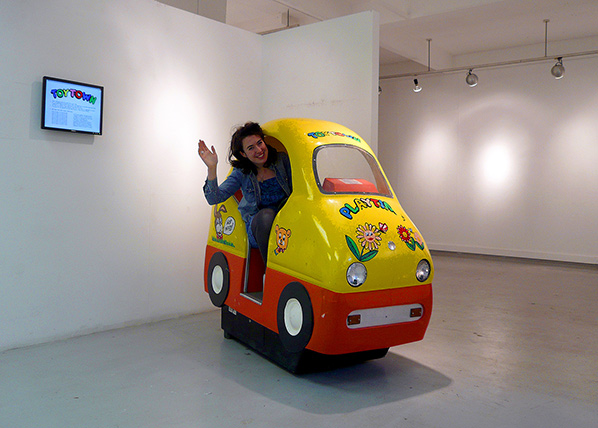
By early 2013 there was spate of high-profile shop closures and the media was full of Death of the High Street scary stories. Blockbusters, Jessops and HMV all closed within months of each other along with other High Street regulars, being replaced by poundshops and charity shops (although Jessops and HMV got injected with some strange green elixir and brought back to life, lacking what small amount of soul they once had).
I was now commissioning public art for Art Across The City, Swansea, a job that until recently saw 36 temporary commissions in three years including Jeremy Deller, Emily Speed, Ross Sinclair and Jeremy Millar. I’d put forward Harrison at interview stage so was happy to finally commission her. As a former Blockbuster’s employee, who proudly fires off her years of service ‘1997-2000’, Harrison was keen to commemorate the 5th anniversary of the start of the global recession, taking the reported death of the high street as its subject. Following a week long site visit and research period, Harrison proposed a city wide participatory event that like many of her works, are ‘data visualisation’ projects.
This included researching every shop that had closed in the city centre and how many employees had lost jobs, and, hopefully tracking them down and getting them to stage a Zombie Walk through the city, inviting the public to join in, to make the high street and place for creative activity and raising community spirit. This wasn’t a Swansea problem, it was a UK wide problem, the blunt end of day to day global recession. Harrison was aiming to raise awareness and bring people together in a positive action.

Sadly, just three months until launch day, the powers that be in a muddled chain of command, from Swansea Council, Swansea BID and ultimately Art Across The City pulled the plug. It was a small condolence that I managed to make sure Harrison received an ominous sounding ‘kill fee’ of £1000, which would barely scratch the sides of the time spent not only on this, but of not working on other projects. It’s a credit to Harrison that she managed to raise the project from the dead, although even that process has not been without its own silver bullet, crucifixes and garlic bulbs.
After dusting herself down, Harrison proposed the idea to Glasgow International as a collaboration with award winning documentary film maker, Jeanie Finlay. The proposal, probably suffering a hangover from its Swansea cancellation was not selected. Harrison was then approached by Josephine Reichert from Ort Gallery in Birmingham about doing a project which “engaged with the local community”. High Street Casualties perfectly fitted the bill. Again, this was not critical of any specific city, just documenting what was happening globally. Reichert was more than keen to make it happen and submitted an application to Arts Council England to fund the project (on a greatly reduced budget), as part of Ort’s annual programme of exhibitions and events. This first application was unsuccessful but with Reichert’s enthusiasm and passion for the project it was successfully resubmitted. High Street Casualties was to become the last project in the Ort Gallery’s programme with a date finally fixed for April 2015, slap bang in the middle of the General Election Purdah, like a stake through the heart.
While some horror film productions like to promote the hype that filming on set was cursed, High Street Casualties seemed to attract all kinds of uncalled for and ill-informed bad luck. Birmingham City Council declared that they did not want to fund or be associated with the project. They continued to fund the rest of Ort’s annual programme, but withdrew money just from High Street Casualties as they thought it was, and just let this glide through you like a ghost, it was ‘making fun of unemployed people’.
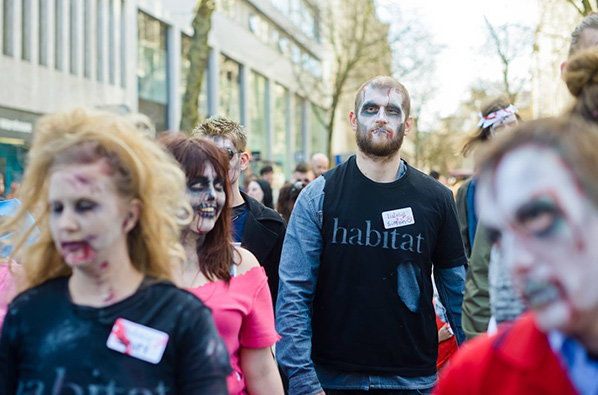
This left just £2000 for an 18 day production, not taking into account the work done over the previous year. Harrison points out that it worked out at £4.50 per hour, which is what she earned whilst at Blockbuster. A further grant application for Glasgow Visual Art Scheme was rejected leaving a limited budget for the make-up artist, photographer and designer. A huge amount of goodwill was required, not just from Reichert and Ort Gallery, who works in the café when not resubmitting ACE applications; the student who helped make the film as part of a placement and of course all of the 60 participants who were involved in a Zombie Walk across Birmingham in their old uniforms, receiving food and drink and make-up tutorials for their time.
Harrison is more than well aware of paying artists and unhappy that the project was compromised on more than one occasion. The original idea about it being a realistic “data visualisation” of redundancies had to be loosened a little as they were at the whim of the number of people who showed up on the day.
60 people is a good crowd given the circumstances but only around a fifth of the number of people who would have lost their jobs from 13 stores. Despite having to cut important corners to the project’s integrity, Harrison is relieved that after two years the initial idea is a reality. The event was not only a success, but proved an alternative form of creative protest in a major UK city. The watching audience, due to the popularity of such Zombie Walks responded well, commenting on old shops and where they used to be. Harrison believes it was popular, radical and subversive, which is a hard trick to pull off.
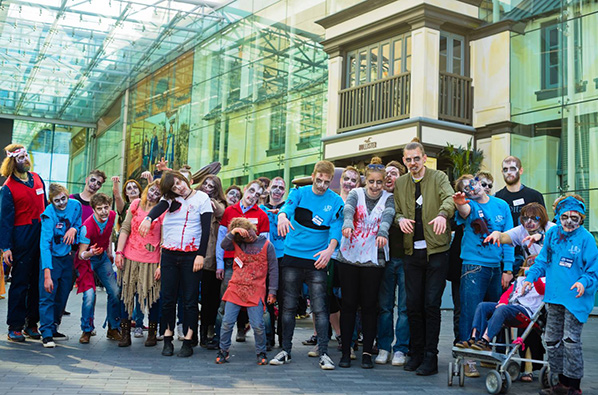
Following a blood stained finale, the end credits have rolled. I was made redundant recently following Arts Council of Wales cuts. Harrison created Dark Days, a post-apocalyptic communal living project in Glasgow Museum of Modern Art; exhibited an immigrant friendly golf course at the Venice Biennale and continues to campaign on many fronts, including Bring Back British Rail. The High Street carries on in some form or another and Conservative vampires are sucking the life out of the UK and we all limp on, like zombies in Romero’s Dawn of the Dead, visiting the shopping mall out of habit.
In these days of austerity, it is important to reach out to the widest audience and speak outside of our own bubbles of influence. High Street Casualties isn’t about criticising what has happened, although it uses that data. It is about making more people aware of why it happened and how we may be able to affect some kind of creative change, however small. High Street Casualties deserves a sequel, a big budget reboot and should tour to every town and city, bringing gore, blood, and ripped Blockbuster uniforms to outside a multiplex near you…
Gordon Dalton is an artist, curator and writer based in Cardiff. He is currently coordinating the inaugural Plymouth Art Weekender
www.gordondalton.co.uk
twitter.com/Mermaid_Monster
Featured image: Rosa Menkman, iRD patch, (2015) Black on black embroidered logo [iRD] Encryption key to the institutions RLE 010 0000 – 101 1111
In the lead-up to her solo show, institutions of Resolution Disputes [iRD], at Transfer Gallery, Brooklyn, Daniel Rourke caught up with Rosa Menkman over two gallons of home-brewed coffee. They talked about what the show might become, discussing a series of alternate resolutions and realities that exist parallel to our daily modes of perception.
iRD is open to visitors on Saturdays at Transfer Gallery until April 18th, and will also function as host to Daniel Rourke and Morehshin Allahyari’s 3D Additivist Manifesto, on Thursday April 16th.
Rosa Menkman: The upcoming exhibition at Transfer is an illustration of my practice based PhD research on resolutions. It will be called ‘institutions of Resolution Disputes’, in short iRD and will be about the liminal, alternative modes of data or information representation, that are obfuscated by technological conventions. The title is a bit wonky as I wish for it to reflect that kind of ambiguity that invokes curiosity.
In any case, I always feel that every person, at least once in their grown-up life, wants to start an institution. There are a few of those moments in life, like “Now I am tired of the school system, I want to start my own school!”; and “Now I am ready to become an architect!”, so this is my dream after wanting to become an architect.
Daniel Rourke: To establish your own institution?

RM: First of all, I am multiplexing the term institution here. ‘institutions’ and the whole setting of iRD does mimic a (white box) institute, however the iRD does not just stand for a formal organization that you can just walk into. The institutions also revisit a slightly more compound framework that hails from late 1970s, formulated by Joseph Goguen and Rod Burstall, who dealt with the growing complexities at stake when connecting different logical systems (such as databases and programming languages) within computer sciences. A main result of these non-logical institutions is that different logical systems can be ‘glued’ together at the ‘substrata levels’, the illogical frameworks through which computation also takes place.
Secondly, while the term ’resolution’ generally simply refers to a standard (measurement) embedded in the technological domain, I believe that a resolution indeed functions as a settlement (solution), but at the same time exists as a space of compromise between different actors (languages, objects, materialities) who dispute their stakes (frame rate, number of pixels and colors, etc.), following rules (protocols) within the ever growing digital territories.
So to answer your question; maybe in a way the iRD is sort of an anti-protological institute or institute for anti-utopic, obfuscated or dysfunctional resolutions.
DR: It makes me think of Donna Haraway’s Manifesto for Cyborgs, and especially a line that has been echoing around my head recently:
“No objects, spaces, or bodies are sacred in themselves; any component can be interfaced with any other if the proper standard, the proper code, can be constructed for processing signals in a common language.”
By using the terms ‘obfuscation’ and ‘dysfunction’ you are invoking a will – perhaps on your part, but also on the part of the resolutions themselves – to be recognised. I love that gesture. I can hear the objects in iRD speaking out; making themselves heard, perhaps for the first time. In The 3D Additivist Manifesto we set out to imagine what the existence of Haraway’s ‘common language’ might mean for the unrealised, “the powerless to be born.” Can I take it that your institute has a similar aim in mind? A place for the ‘otherwise’ to be empowered, or at least to be recognised?
RM: The iRD indeed kind of functions as a stage for non-protocological resolutions, or radical digital materialism.
I always feel like I should say here, that generally, I am not against function or efficiency. These are good qualities, they make the world move forward. On the other hand, I do believe that there is a covert, nepotist cartel of protocols that governs the flows and resolutions of data and information just for the sake of functionality and efficiency. The sole aim of this cartel is to uphold the dogma of modern computation, which is about making actors function together (resonate) as efficiently as possible, tweaking out resources to maximum capacity, without bottlenecks, clicks, hicks or cuts, etc.
But this dogma also obfuscates a compromise that we never question. And this is where my problem lies: efficiency and functionality are shaping our objects. Any of these actors could also operate under lower, worse or just different resolutions. Yet we have not been taught to see, think or question any of these resolutions. They are obfuscated and we are blind to them.
I want to be able to at least entertain the option of round video (strip video from its interface!), to write inside non-quadrilateral, modular text editors (no more linear reading!) or to listen to (sonify) my rainbows (gradients). Right now, the protocols in place simply do not make this possible, or even worse, they have blocked these functionalities.
There is this whole alternate universe of computational objects, ways that our data would look or be used like, if the protocols and their resolutions had been tweaked differently. The iRD reflects on this, and searches, if you will, a computation of many dimensions.
DR: Meaning that a desktop document could have its corners folded back, and odd, non standard tessellations would be possible, with overlapping and intersecting work spaces?
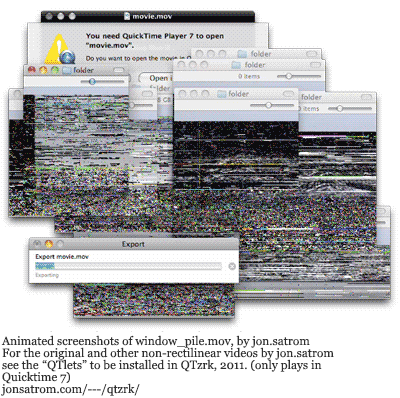
RM: Yes! Exactly!
Right now in the field of imagery, all compressions are quadrilateral, ecology dependent, standard solutions (compromises) following an equation in which data flows are plotted against actors that deal with the efficiency/functionality duality in storage, processing and transmission.
I am interested in creating circles, pentagons and other more organic manifolds! If we would do this, the whole machine would work differently. We could create a modular and syphoning relationships between files, and just as in jon Satroms’ 2011 QTzrk installation, video would have multiple timelines and soundtracks, it could even contain some form of layer-space!
DR: So the iRD is also a place for some of those alternate ‘solutions’ that are in dispute?
RM: Absolutely. However, while I am not a programmer, I also don’t believe that imagining new resolutions means to absolve of all existing resolutions and their inherent artifacts. History and ecology play a big role in the construction of a resolution, which is why I will also host some of my favorite, classic solutions and their inherent (normally obfuscated) artifacts at the iRD, such as scan lines, DCT blocks, and JPEG2000 wavelets.

The iRD could easily function as a Wunderkammer for artifacts that already exist within our current resolutions. But to me this would be a needles move towards the style of the Evil Media Distribution Center, created by YoHa (Matsuko Yokokoji and Graham Harwood) for the 2013 Transmediale. I love to visit Curiosity Cabinets, but at the same time, these places are kind of dead, celebrating objects that are often shielded behind glass (or plastic). I can imagine the man responsible for such a collection. There he sits, in the corner, smoking a pipe, looking over his conquests.
But this kind of collection does not activate anything! Its just ones own private boutique collection of evil! For a dispute to take place we need action! Objects need to have – or be given – a voice!
DR: …and the alternate possible resolutions can be played out, can be realised, without solidifying them as symbols of something dead and forgotten.
RM: Right! It would be easy and pretty to have those objects in a Wunderkammer type of display. Or as Readymades in a Boîte-en-valise but it just feels so sad. That would not be zombie like but dead-dead. A static capture of hopelessness.
DR: The Wunderkammer had a resurgence a few years ago. Lots of artists used the form as a curatorial paradigm, allowing them to enact their practice as artist and curator. A response, perhaps, to the web, the internet, and the archive. Aggregated objects, documents and other forms placed together to create essayistic exhibitions.
RM: I feel right now, this could be an easy way out. It would be a great way out, however, as I said, I feel the need to do something else, something more active. I will smoke that cigar some other day.
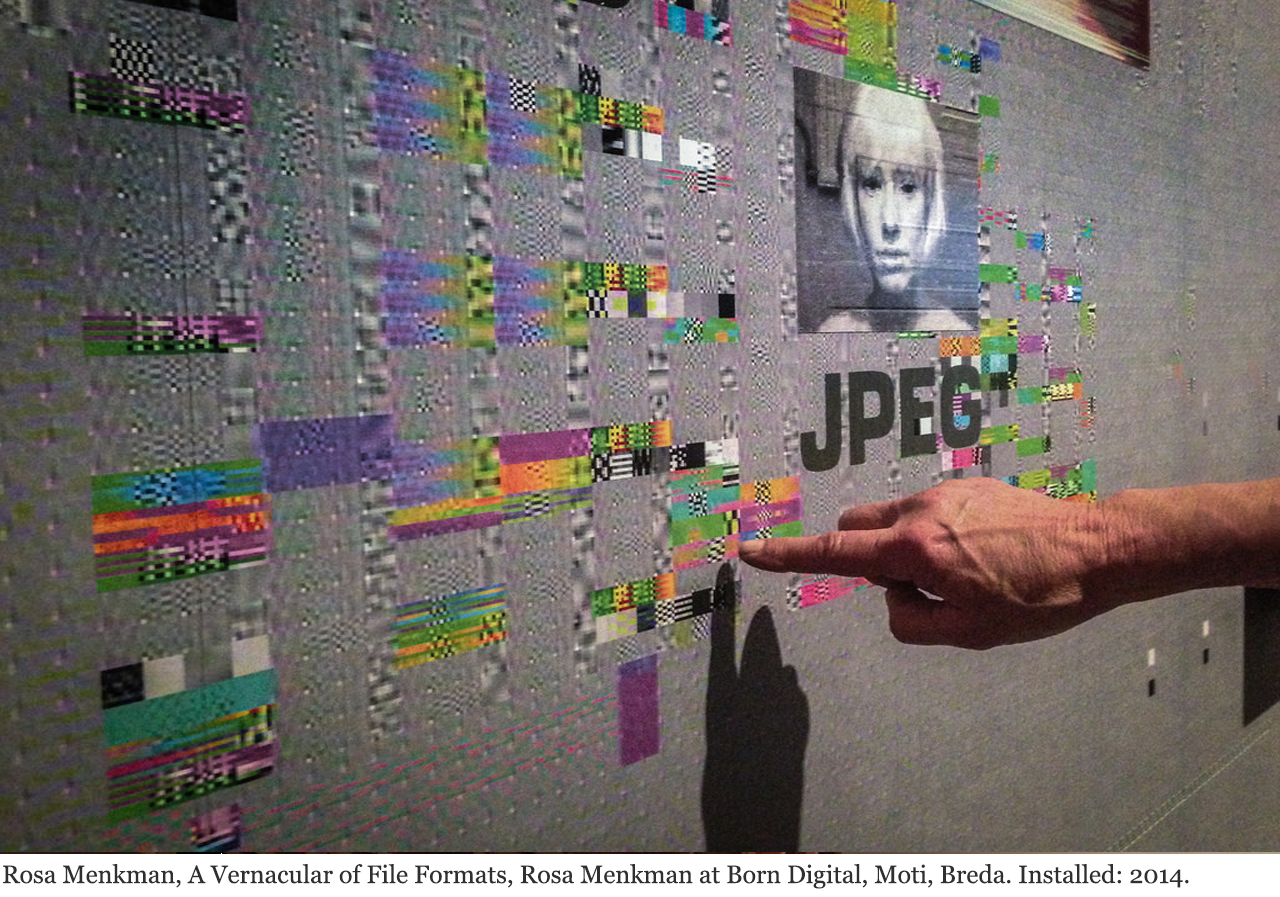
DR: So you wouldn’t want to consider the whole of Transfer Gallery as a Wunderkammer that you were working inside of?
RM: It is one possibility. But it is not my favorite. I would rather make works against the established resolutions, works that are built to break out of a pre-existing mediatic flow. Works that were built to go beyond a specific conventional use.
For example, I recently did this exhibition in The Netherlands where I got to install a really big wallpaper, which I think gained me a new, alternative perspectives on digital materiality. I glitched a JPEG and zoomed in on its DCT blocks and it was sooo beautiful, but also so scalable and pokable. It became an alternative level of real to me, somehow.
DR: Does it tesselate and repeat, like conventional wallpaper?
RM: It does repeat in places. I would do it completely differently if I did it again. Actually, for the iRD I am considering to zoom into the JPEG2000 wavelets. I thought it would be interesting to make a psychedelic installation like this. It’s like somebody vomited onto the wall.

DR: [laughs] It does look organic, like bacteria trying to organise.
RM: Yeah. It really feels like something that has its own agency somehow.
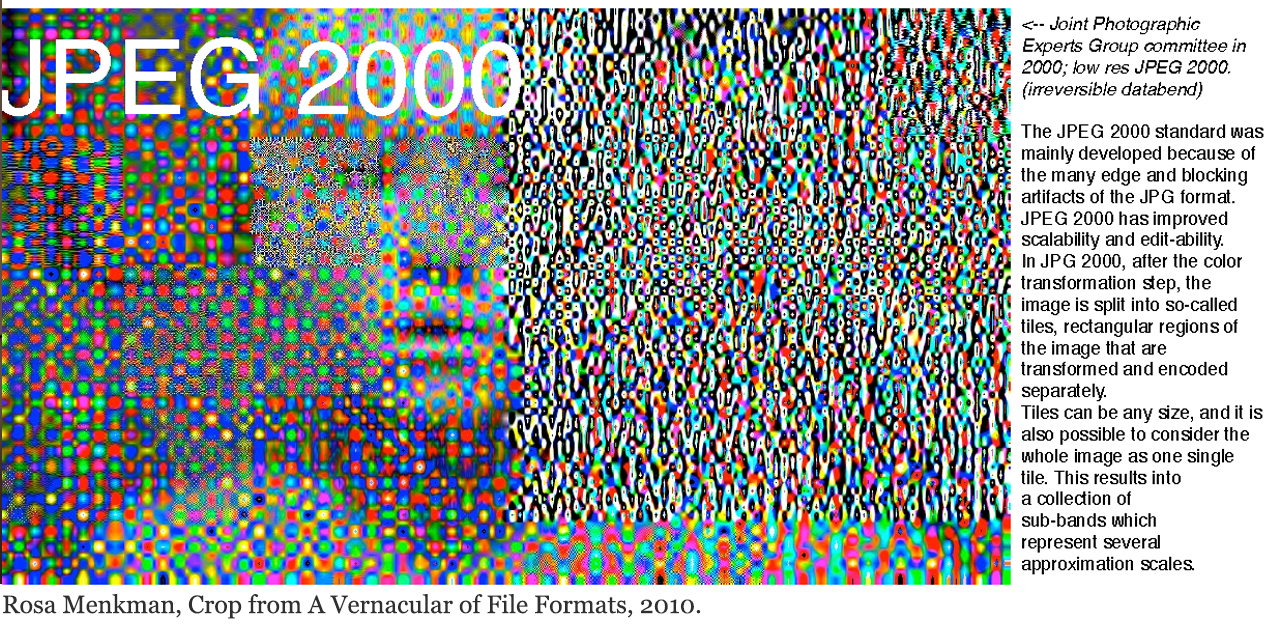

DR: That’s the thing about JPEG2000 – and the only reason I know about that format, by the way, is because of your Vernacular of File Formats – the idea that they had to come up with a non-regular block shape for the image format that didn’t contradict with the artifacts in the bones and bodies that were being imaged. It feels more organic because of that. It doesn’t look like what you expect an image format to look like, it looks like what I expect life to look like, close up.
RM: It looks like ‘Game of Life’.
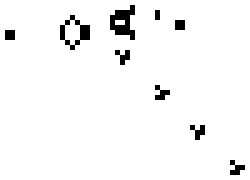
DR: Yes! Like Game of Life. And I assume that now they don’t need to use JPEG2000 because the imaging resolution is high enough on the machines to supersede bone artifacts. I love that. I love the effect caused when you’ve blown it up here. It looks wonderful. What is the original source for this?
RM: I would blow this image [the one from A Vernacular of File Formats] up to hell. Blow it up until there is no pixel anymore. It shouldn’t be too cute. These structures are built to be bigger. Have you seen the Glitch Timond (2014)? The work itself is about glitches that have gained a folkloric meaning over time, these artifact now refer to hackers, ghosts or AI. They are hung in the shape of a diamond. The images themselves are not square, and I can install them on top of the wallpaper somehow, at different depths. Maybe I could expand on that piece, by putting broken shaped photos, and shadows flying around. It could be beautiful like that.

DR: It makes me think of the spatiality of the gallery. So that the audience would feel like they were inside a broken codec or something. Inside the actual coding mechanism of the image, rather than the standardised image at the point of its visual resolution.
RM: Oh! And I want to have a smoke machine! There should be something that breaks up vision and then reveals something.
DR: I like that as a metaphor for how the gallery functions as well. There are heaps of curatorial standards, like placing works at line of sight, or asking the audience to travel through the space in a particular order and mode of viewing. The gallery space itself is already limited and constructed through a huge, long history of standardisations, by external influences of fashion and tradition, and others enforced by the standards of the printing press, or the screen etc. So how do you make it so that when an audience walks into the gallery they feel as though they are not in a normal, euclidean space anymore? Like they have gone outside normal space?
RM: That’s what I want! Disintegrate the architecture. But now I am like, “Yo guys, I want to dream, and I want it to be real in three weeks…”
DR: “Hey guys, I want to break your reality!” [laughs]
RM: One step is in place, Do you remember Ryan Maguire who is responsible for The Ghost in the MP3? His research is about MP3 compressions and basically what sounds are cut away by this compression algorithm, simply put: it puts shows what sounds the MP3 compression normally cuts out as irrelevant – in a way it inverses the compression and puts the ‘irrelevant’ or deleted data on display. I asked him to rework the soundtrack to ‘Beyond Resolution’, one of the two videowork of the iRD that is accompanied by my remix of professional grin by Knalpot and Ryan said yes! And so it was done! Super exciting.
DR: Yes. I thought that was a fantastic project. I love that as a proposition too… What would the equivalent of that form of ghosting be in terms of these alternate, disputed resolutions? What’s the remainder? I don’t understand technical formats as clearly as you do, so abstract things like ‘the ghost’, ‘the remainder’ are my way into understanding them. An abstract way in to a technical concept. So what is the metaphoric equivalent of that remainder in your work? For instance, I think it depends on what this was originally an image of. I think that is important.
RM: The previous image of JPEG2000 does not deal with the question of lost information. I think what you are after is an inversed Alvin Lucier ‘Sitting in a Room’ experiment, one that only shows the “generation loss” (instead of the generation left over, which is what we usually get to see or hear in art projects). I think that would be a reasonable equivalent to Ryan Maguires MP3 compression work.
Or maybe Supraconductivity.
I can struggle with this for… for at least two more days. In any case I want the iRD to have a soundtrack. Actually, it would like there to be a spatial soundtrack; the ghost soundtrack in the room and the original available only on a wifi access point.
DR: I’m really excited by that idea of ghostly presence and absence, you know. In terms of spatiality, scan lines, euclidean space…
RM: It’s a whole bundle of things! [laughs] “Come on scan lines, come to the institutions, swim with the ghosts!”
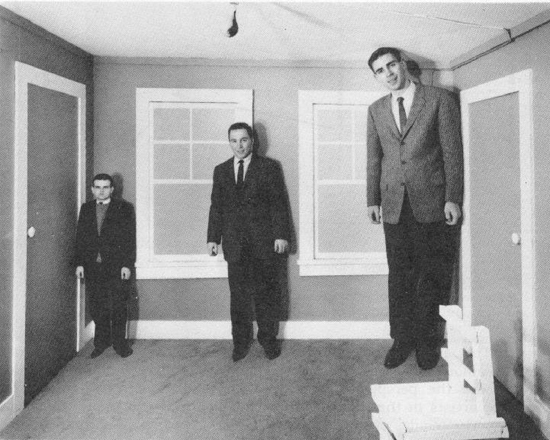
DR: It makes me think of cheesy things you get in a children’s museum. Those illusion rooms, that look normal through a little window, but when you go into them they are slanted in a certain way, so that a child can look bigger than an adult through the window frame. You know what I mean? They play with perspective in a really simple way, it’s all about the framing mechanism, the way the audience’s view has been controlled, regulated and perverted.
RM: I was almost at a point where I was calling people in New York and asked, “Can you produce a huge stained glass window, in 2 weeks?” I think it would be beautiful if the Institute had its own window.
I would take a photo of what you could see out of the real window, and then make the resolution of that photo really crappy, and create a real stained glass window, and install that in the gallery at its original place. If I have time one day I would love to do that, working with real craftspeople on that. I think that in the future the iRD might have a window through which we interface the outside.
Every group of people that share the same ideas and perspectives on obfuscation need to have a secret handshake. So that is what I am actually working on right now. Ha, You didn’t see that coming? [Laughs]
DR: [Laughs] No… that’s a different angle.
RM: I want people to have a patch! A secret patch. You remember Trevor Paglen’s book on the symbology of military patches?

DR: Oh yeah. Where he tries to decode the military patches? Yes, I love that.
RM: Yeah, I don’t think the world will ever have enough patches. They are such an icon for secret handshakes.
I have been playing around with this DCT image. I want to use it as a key to the institutions, which basically are a manifest to the reasonings behind this whole exhibition, but then encrypted in a macroblock font (I embedded an image of Institution 1 earlier). There was one of Paglen’s patches that really stood out for me; the black on black one. The iRD patch should be inspired by that.
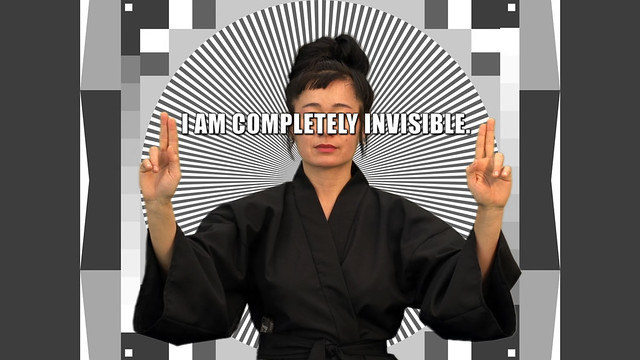
DR: Hito Steyerl’s work How Not to be Seen: A Fucking Didactic Educational .MOV File, centres on the grid used by the military to calibrate their satellites from space. The DCT structure looks a lot like that, but I know the DCT is not about calibration. It contains all the shapes necessary to compose any image?
RM: If you look up close at a badly compressed JPEG, you will notice the image consist of macroblocks. A macroblock is a block organizations, usually consisting of 8×8 pixels, that posses color (chrominance) and light (luminance) values embedded via DCT (discrete cosine transform).

Basically all JPEGs you have ever seen are build out of this finite set of 64 macroblocks. Considering that JPEGs make up the vast majority of images we encounter on a daily basis, I think it is pretty amazing how simple this part of the JPEG compression really is.
But the patch should of course not just be square. Do you know the TV series Battlestar Galactica, where they have the corners cut off all their books? All the paper in that world follows this weird, octagonal shape? Or Borges Library and its crimson hexagon, that holds all knowledge. I love those randomly cryptic geometric forms…
DR: It reminds me of a 1987 anime film, Wings of Honneamise, that had a really wonderfully designed world. Everything is different, from paper sizes and shapes, through to their cutlery. Really detailed design from the ground up, all the standards and traditions.
RM: Like this Minecraft book too. The Blockpedia.

DR: Oh that’s great. I love the Minecraft style
and the mythos that has arisen around it.
RM: So Minecraft and Borges follow a 6 corner resolution, and Battlestar paper has 8 corners… Discrepancy! I want to reference them all!
DR: So these will go into the badges?
RM: I want to have a black on black embroidered patch with corners. Don’t you think this would be so pretty? This black on black. I want to drop a reference to 1984, too, Orwell or Apple, the decoder can decide. These kind of secret, underground references, I like those.
DR: A crypto exhibition.
RM: It’s so hot right now (and with hot I do not mean cool). Since the 90s musicians encrypt or transcode things in their sounds, from Aphex Twin, to Goodiepal and now TCF, who allegedly encrypted an image from the police riots in Athens into one of his songs. However, he is a young Scandinavian musician so that makes me wonder if the crypto design in this case is confusingly non-political. Either way, I want to rebel against this apparent new found hotness of crypto-everything, which is why I made Tacit:Blue.
Tacit:Blue uses a very basic form of encryption. Its archaic, dumb and decommissioned. Every flash shows a next line of my ‘secret message’ encrypted in masonic pigpen. When it flickers it gives a little piece of the message which really is just me ranting about secrecy. So if someone is interested in my opinion, they can decode that.
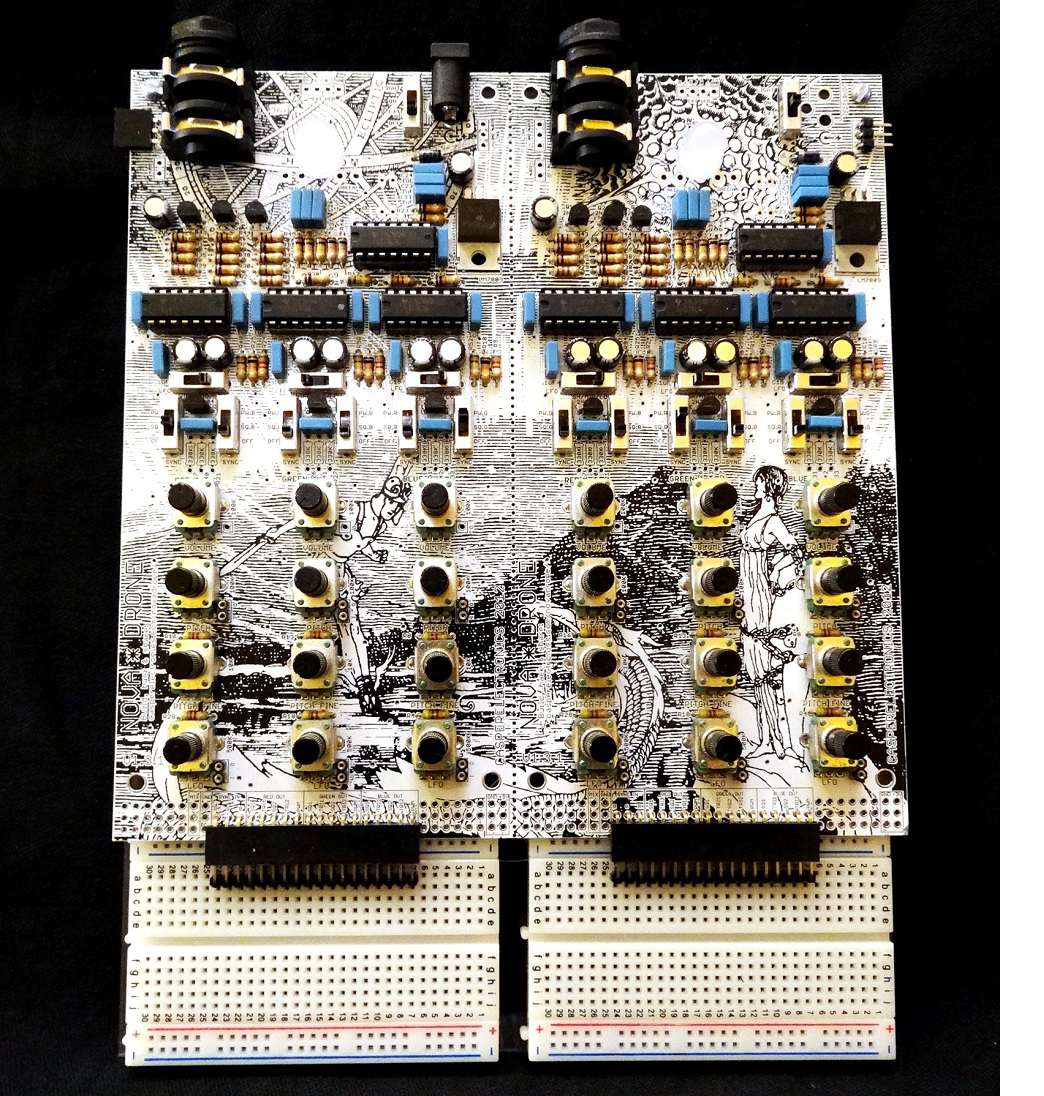
Actually, the technology behind the video is much more interesting. Do you know The Nova Drone? Its a small AV synthesizer designed by Casper Electronics. The the flickr frequency of this military RGB LED on the top of the board can be altered by turning the RGB oscillators. When I come close to the LED with the lens of my iphone, the frequencies of the LED and the iphone camera do not sync up. What happens is a rolling shutter effect. The camera has to interpret the input and something is gone, lost in translation. In fact, a Resolutional Dispute takes place right there.
DR: So the dispute happens because framerate of the camera conflicts with the flicker of the LED?
RM: And the sound is the actual sound of the electronics. In Tacit:Blue I do not use the NovaDrone in a ‘clean’ way, I am actually misusing it (if there is such a thing when it comes to a device of dispute). Some of the sounds and disruptions of flow are created in this patch bay, which is where you can patch the LFOs, etc. Anyway, when you disconnect the patch it flickers, but I never take it out fully so it creates this classic, noisy electric effect.
What do you think about the text? Do you think this works? I like this masonic pigpen, its a very simple, nostalgic old quiff.
DR: It reminds me of the title sequence for Alien. Dave Addey did a close visual, sci-fi etymological, analysis of the typography in Alien. It went viral online recently. Did you see that?
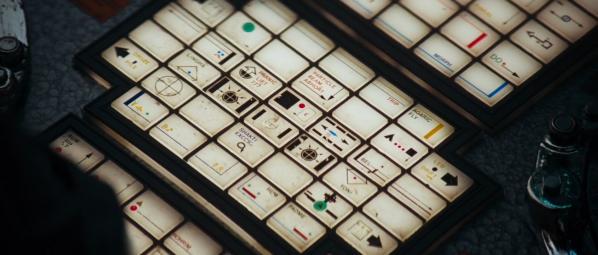
RM: No!
DR: It is fantastic. Everything from the title sequence to the buttons on the control panel in the background. Full of amazing insights.

RM: Wow, inspiring!
So with any cypher you also need a key, which is why I named the video Tacit:Blue, a reference to the old Northrop Tacit Blue stealth surveillance aircraft. The aircraft was used to develop techniques against passive radar detection, but has been decommissioned now, just like the masonic pigpen encryption.
DR: This reminds me of Eyal Weizman. He has written a lot on the Israeli / Palestinian conflict as a spatial phenomena. So we don’t think about territory merely as a series of lines drawn on a globe anymore, but as a stack, including everything from airspace, all the way down beneath the ground, where waste, gas and water are distributed. The mode by which water is delivered underground often cuts across conflicted territories on the surface. A stacked vision of territory brings into question the very notion of a ‘conflict’ and a ‘resolution’.
I recently saw him give a lecture on the Forensic Architecture project, which engages in disputes metered against US Military activities. Military drones are now so advanced that they can target a missile through the roof of a house, and have it plunge several floors before it explodes. It means that individual people can be targeted on a particular floor. The drone strike leaves a mark in the roof which is – and this is Weizman’s terminology – ‘beneath the threshold of detectability’. And that threshold also happens to be the size of a human body: about 1 metre square. Military satellites have a pixel size that effectively translates to 1 metre square at ground level. So to be invisible, or technically undetectable, a strike needs only to fall within a single pixel of a satellite imaging system. These drone strikes are designed to work beneath that threshold.
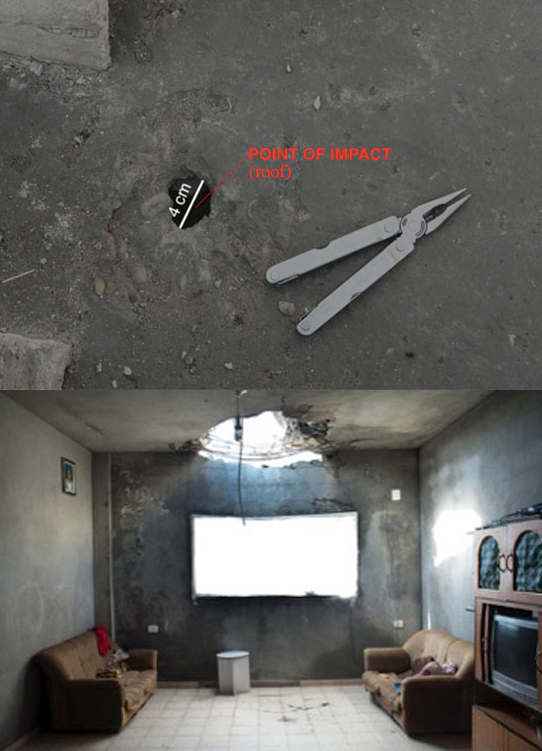
In terms of what you are talking about in Trevor Paglen’s work, and the Northrop Tacit Blue, those technologies were designed to exist beneath, or parallel to, optic thresholds, but now those thresholds are not optic as much as they are about digital standards and resolution densities. So that shares the same space as the codecs and file formats you are interested in. Your patch seems to bring that together, the analogue pixel calibration that Steyerl refers to is also part of that history. So I wonder whether there are images that cannot possibly be resolved out of DCT blocks. You know what I mean? I think your work asks that question. What images, shapes, and objects exist that are not possible to construct out of this grid? What realities are outside of the threshold of these blocks to resolve? It may even be the case that we are not capable of imagining such things, because of course these blocks have been formed in conjunction with the human visual system. The image is always already a compromise between the human perceptual limit and a separately defined technical limit.
RM: Yes, well I can imagine vector graphics, or mesh based graphics where the lines are not just a connection between two points, but also a value could be what you are after. But I am not sure.
At some point I thought that people entering the iRD could pay a couple of dollars for one of these patches, but if they don’t put the money down, then they would be obliged to go into the exhibition wearing earplugs.
DR: [Laughs] So they’d be allowed in, but they’d have one of their senses dampened?
RM: Yes, wearing earmuffs, or weird glasses or something like that. [Laughs]
DR: Glasses with really fine scan lines on them that conflict with TV images or whatever.
RM: [Laughs] And I was thinking, well, there should be a divide between people. To realise that what you see is just one threshold that has been lifted to only a few. There are always thresholds, you know.
DR: Ways to invite the audience into the spaces and thresholds that are beneath the zones of resolutional detectability?
RM: Or maybe just to show the mechanics behind objects and thresholds.
DR: Absolutely. So to go back to your Tacit:Blue video, in regards the font, I like the aesthetic, but I wonder whether you could play with that zone of detectability a little more.
You could have the video display at a frequency that is hard for people to concentrate on, for instance, and then put the cryptographic message at a different frequency. Having zones that do not match up, so that different elements of the work cut through different disputed spaces. Much harder to detect. And more subliminal, because video adheres to other sets of standards and processes beyond scan lines, the conflict between those standards opens up another space of possibilities.
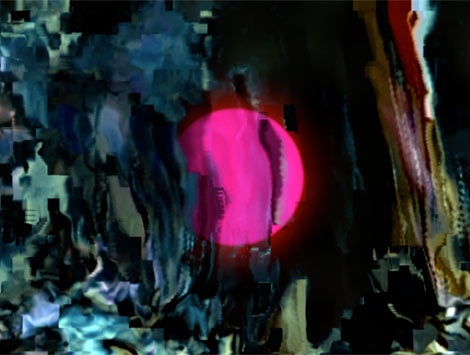
It makes me think about Takeshi Murata’s Untitled (Pink Dot). I love that work because it uses datamoshing to question more about video codecs than just I and P frames. That’s what sets this work apart, for me, from other datamoshed works. He also plays with layers, and post production in the way the pink dot is realised. As it unfolds you see the pink dot as a layer behind the Rambo footage, and then it gets datamoshed into the footage, and then it is a layer in front of it, and then the datamosh tears into it and the dot become part of the Rambo miasma, and then the dot comes back as a surface again. So all the time he is playing with the layering of the piece, and the framing is not just about one moment to the next, but it also it exposes something about Murata’s super slick production process. He must have datamoshed parts of the video, and then post-produced the dot onto the surface of that, and then exported that and datamoshed that, and then fed it back into the studio again to add more layers. So it is not one video being datamoshed, but a practice unfolding, and the pink dot remains a kind of standard that runs through the whole piece, resonating in the soundtrack, and pushing to all elements of the image. The work is spatialised and temporalised in a really interesting way, because of how Murata uses datamoshing and postproduction to question frames, and layers, by ‘glitching’ between those formal elements. And as a viewer of Pink Dot, your perception is founded by those slips between the spatial surface and the temporal layers.
RM: Yeah, wow. I never looked at that work in terms of layers of editing. The vectors of these blocks that smear over the video, the movement of those macroblocks, which is what this video technologically is about, is also about time and editing. So Murata effectively emulates that datamosh technique back into the editing of the work before and after the actual datamosh. That is genius!
DR: If it wasn’t for Pink Dot I probably wouldn’t sit here with you now. It’s such an important work for me and my thinking.

Working with Morehshin Allahyari on The 3D Additivist Manifesto has brought a lot of these processes into play for me. The compressed labour behind a work can often get lost, because a final digital video is just a surface, just a set of I and P frames. The way Murata uses datamoshing calls that into play. It brings back some of the temporal depth.
Additivism is also about calling those processes and conflicts to account, in the move between digital and material forms. Oil is a compressed form of time, and that time and matter is extruded into plastic, and that plastic has other modes of labour compressed into it, and the layers of time and space are built on top of one another constantly – like the layers of a 3D print. When we rendered our Manifesto video we did it on computers plugged into aging electricity infrastructures that run on burnt coal and oil. Burning off one form of physical compressed time to compress another set of times and labours into a ‘digital work’.
RM: But you can feel that there is more to that video than its surface!
If I remember correctly you and Morehshin wrote an open invitation to digital artists to send in their left over 3D objects. So every object in that dark gooey ocean in The 3D Additivist Manifesto actually represents a piece of artistic digital garbage. It’s like a digital emulation of the North Pacific Gyre, which you also talked about in your lecture at Goldsmiths, but then solely consisting of Ready-Made art trash.

The actual scale and form of the Gyre is hard to catch, it seems to be unimaginable even to the people devoting their research to it; it’s beyond resolution. Which is why it is still such an under acknowledged topic. We don’t really want to know what the Gyre looks or feels like; it’s just like the clutter inside my desktop folder inside my desktop folder, inside the desktop folder. It represents an amalgamation of histories that moved further away from us over time and we don’t necessarily like to revisit, or realise that we are responsible for. I think The 3D Additivist Manifesto captures that resemblance between the way we handle our digital detritus and our physical garbage in a wonderfully grimm manner.
DR: I’m glad you sense the grimness of that image. And yes, as well as sourcing objects from friends and collaborators we also scraped a lot from online 3D object repositories. So the gyre is full of Ready-Mades divorced from their conditions of creation, use, or meaning. Like any discarded plastic bottle floating out in the middle of the pacific ocean.
Eventually Additivist technologies could interface all aspects of material reality, from nanoparticles, to proprietary components, all the way through to DNA, bespoke drugs, and forms of life somewhere between the biological and the synthetic. We hope that our call to submit to The 3D Additivist Cookbook will provoke what you term ‘disputes’. Objects, software, texts and blueprints that gesture to the possibility of new political and ontological realities. It sounds far-fetched, but we need that kind of thinking.
Alternate possibilities often get lost in a particular moment of resolution. A single moment of reception. But your exhibition points to the things beyond our recognition. Or perhaps more importantly, it points to the things we have refused to recognise. So, from inside the iRD technical ‘literacy’ might be considered as a limit, not a strength.
RM: Often the densities of the works we create, in terms of concept, but also collage, technology and source materials move quite far away or even beyond a fold. I suppose that’s why we make our work pretty. To draw in the people that are not technically literate or have no back knowledge. And then perhaps later they wonder about the technical aspects and the meaning behind the composition of the work and want to learn more. To me, the process of creating, but also seeing an interesting digital art work often feels like swimming inside an abyss of increments.
DR: What is that?
RM: I made that up. An abyss is something that goes on and on and on. Modern lines used to go on, postmodern lines are broken up as they go on. Thats how I feel we work on our computers, its a metaphor for scanlines.

DR: In euclidean space two parallel lines will go on forever and not meet. But on the surface of a globe, and other, non-euclidean spaces, those lines can be made to converge or diverge. *
RM: I have been trying to read up on my euclidean geometry.
DR: And I am thinking now about Flatland again, A Romance in Many Dimensions.
RM: Yeah, it’s funny that in the end, it is all about Flatland. That’s where this all started, so thats where it has to end; Flatland seems like an eternal ouroboros inside of digital art.
DR: It makes me think too about holographic theory. You can encode on a 2D surface the information necessary to construct a 3D image. And there are theories that suggest that a black hole has holographic properties. The event horizon of a black hole can be thought of as a flat surface, and contains all the information necessary to construct the black hole. And because a black hole is a singularity, and the universe can be considered as a singularity too – in time and space – some theories suggest that the universe is a hologram encoded on its outer surface. So the future state of the universe encodes all the prior states. Or something like that.
RM: I once went to a lecture by Raphael Bousso, a professor at Department of Physics, UC Berkeley. He was talking about black holes, it was super intense. I was sitting on the end of my seat and nearly felt like I was riding a dark star right towards my own event horizon.
DR: [laughs] Absolutely. I suppose I came to understand art and theory through things I knew before, which is pop science and science fiction. I tend to read everything through those things. Those are my starting points. But yes, holograms are super interesting.
RM: I want to be careful not to go into the wunderkammer, because if there are too many things, then each one of them turns into a fetish object; a gimmick.
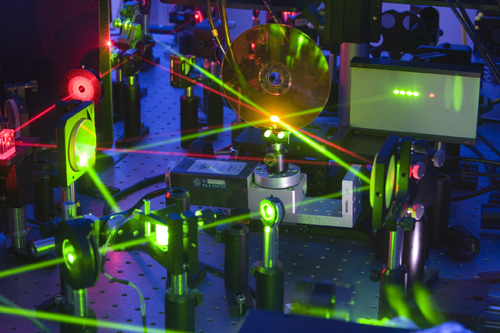
DR: There was a lot of talk a few years ago about holographic storage, because basically all our storage – CDs, DVDs, hard drive platters, SSD drives – are 2D. All the information spinning on your screen right now, all those rich polygons or whatever, it all begins from data stored on a two dimensional surface. But you could have a holographic storage medium with three dimensions. They have built these things in the laboratory. There goes my pop science knowledge again.
RM: When I was at Transmediale last year, the Internet Yami-ichi (Internet Black Market) was on. There I sold some custom videos for self cracked LCD screens.
DR: Broken on purpose?
RM: Yes, and you’d be allowed to touch it so the screen would go multidimensional. Liquid crystals are such a beautiful technology.
DR: Yes. And they are a 3D image medium. But they don’t get used much anymore, right? LEDS are the main image format.
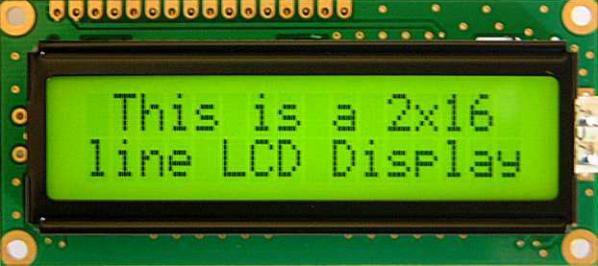
RM: People miss LCDS! I saw a beautiful recorded talk from the Torque event, Esther Leslie talking about Walter Benjamin who writes about snow flakes resembling white noise. Liquid crystals and flatness and flatland.
I want to thank you Dan, just to talk through this stuff has been really helpful. You have no idea. Thank you so much!
DR: Putting ideas in words is always helpful.
RM: I never do that, in preparation, to talk about things I am still working on, semi-completed. It’s scary to open up the book of possibilities. When you say things out loud you somehow commit to them. Like, Trevor Paglen, Jon Satrom are huge inspirations, I would like to make work inspired by them, that is a scary thing to say out loud.
DR: That’s good. We don’t work in a vacuum. Trevor Paglen’s stuff is often about photography as a mode of non-resolved vision. I think that does fit with your work here, but you have the understanding and wherewithal to transform these concerns into work about the digital media. Maybe you need to build a tiny model of the gallery and create it all in miniature.
RM: That’s what Alma Alloro said!
DR: I think it would be really helpful. You don’t have to do it in meatspace. You could render a version of the gallery space with software.
RM: Haha great idea, but that would take too much time. iRD needs to open to the public in 3 weeks!
* DR originally stated here that a globe was a euclidean space. This was corrected, with thanks to Matthew Austin.
Lately, I have noticed in myself a tendency to sign up for events which reveal little of what to expect beforehand. This leads to a heady mix of anticipation and mild terror. Dark Days, the brainchild of Ellie Harrison fitted that description, although I felt that at 16hrs long, it was a mere blip on my riskometer, compared to week-long excursions I’ve previously taken into the unknown. In short, I would be spending the night in Glasgow’s Gallery of Modern Art (GoMA), in a pop-up community of 99 strangers, contemplating how we might manage to live together (put up with each other) in a future where buildings might need to be used in ways which serve the needs of the population better…Count me in!

The camp manual gave thorough and due attention to health & safety issues like pyjamas and woollen blankets, but scant reassurance on how the experiment would avoid a rapid descent into anarchy. In the absence of concrete information, my mind ran amok. I therefore decided, that on arrival we would be immersed in an imagined scenario where all manner of crises has befallen our village, that it would be up to us to work out how we would rebuild society. This would be a tense, high adrenaline experience involving sleep deprivation, maybe starvation, and intractable social issues, to be debated until we all came to a common vision. We might never make it out of there.
As it turned out, Dark Days was none of those things; it was a whole lot more. On arrival in Glasgow, I succumbed to mild panic and bought myself a sleeping pad, twinpack of nougat caramel chocolate, and a bottle of fizzy pop (in direct contravention of the bring a bottle of water mandate), to supplement the food I already had in my rucksack. Provisions bolstered, I relaxed & enjoyed my pilgrimage to GoMA; I felt carefree, adventurous and rebellious; none of the strangers walking beside me had a clue what I was about to do. I felt dangerous and daring.

I joined the short queue outside GoMA, exchanging nervous banter with fellow participants (“Is this where the over-excited and slightly nervous should queue for the coming apocalypse?”). We eyed each other up, I began to relax. We all looked pretty ‘normal and balanced’ individuals. Who could predict what would surface once the pressure was on, though? A child walking past was overheard saying “you’re the worst Mum ever”. He was joking of course, or was he? Was society breaking down already? When the doors opened, we edged inside, one and two at a time. We were subjected to challenging initiative tests – first to register with the clipboard on the right if your surname is A-L. I was standing on the left, I dithered. My surname begins with a ‘G’. My faculties were already leaving me. Through the archway to the welcome desk, I shuffled forward and joined the queue on the right. More nervous exchanges. The queue on the left was faster, we silently wondered whether it would be impolite to skip over to the other line. No one moved. A couple of minutes later, I spotted a notice ‘A-L’ taped to the left side of the desk. A dastardly ploy! Somewhere, a hidden camera would be watching me, a witness to my ineptitude. This was before the evening had even begun. My nerves jangled. Beyond the mysterious white cube that had blocked our view of the great hall (was that where the mind games would take place?), we placed our belongings around the edges and sat in the large circle of chairs which awaited. More nervous chatter, it was clear that no one had the faintest notion what the night would hold. I was reassured. Speakers, microphones and video cameras (with red light already flashing) were dotted around the space, we did our best to ignore them. There will be screenings in March in Glasgow, and the film will be made available online #ohdear. Someone noticed that there were not enough chairs for all members of the community to have a seat. 20ish people stood, or sat on the floor. Was this a lack of resources on GoMA’s part, or was it intentional? Time would tell.
An entertaining and enlightening journey followed, into the challenges of consensus decision making, based around the formation of ‘affinity groups’. The groups were determined by allowing anyone who felt brave enough to make suggestions of how we might spend our time together, members of the community chose which group they wanted to join. The options were many and varied; building a Tower of Awesome; a general knowledge quiz; game playing; climate change discussion group; music & dance; a group with no plan; a manifesto writing group; a skills sharing group and a community focused ‘hub’ group. This was the fascinating moment for me, as my intended plan for the evening was abandoned. Along with my keen interest in community building, I was at GoMA to write poetry, to create a distillation of the night’s happenings for future posterity. Logic would dictate that I should go where the most words would be; but I was filled with an irresistible urge to play games. I had already co-dreamed an impressive list of sleeping bag related games with the person sitting to my left (slug, husky races, who can wear the most sleeping bags, sack races to name a few).
We gathered in our groups to discuss what we would do, what we would need, what format the evening should take and (as it turns out, crucially) what time we would like the lights to go out. A spokesperson was selected to represent each group on a ‘spokescouncil’, where the representatives would reach a consensus on the issues of how the evening would go, any conflicts over resources and at what time the lights should go out. The facilitators did a magnificently heroic job of keeping the discussions focused; ‘brief’ overviews spiralled out of control, the facilitator gently herded the kittens. “I’ll say again: Each spokesperson is to give a brief outline of what their group will do tonight” quickly became “Each person has 30 seconds to tell us”. Those not on the spokescouncil chortled and tried to stifle the mounting hysteria. The only spokesperson not tempted to flout the guidance was from the ‘no plan’ group, because well, they had ‘no plan’. It became clear that with the proposed ‘Tower of Awesome’ and sub-idea of sleeping bag fort, that chairs were the key resource to be negotiated. Turning out the lights also became a decision to be much wrangled over; there were lots of needs, ranging from ‘pretty much now’ to ‘what the hell, let’s stay up all night’.
Negotiations were funny, tense, agonising and did I mention funny? At one point, I was weeping with laughter; we were tantalisingly close to reaching consensus when out of leftfield came a demand for an opening ceremony. Fine we all said, have your opening ceremony, let’s just get this done. The sage advice of the facilitators was beginning to hit home – only use consensus decision making for important decisions and ask yourself ‘do I want to spend all night making decisions, or do I want to have some fun?’. By now it was heading towards 11pm, and there were games waiting to be played. We were close. We were restless. The facilitator then fulfilled the most crucial obligation of consensus decision making, and asked the spokescouncil whether there were any objections. We held our breath, pleading inwardly for no one to speak up. Come on spokescouncil, you could do it! Hands went up. Sigh. 15mins of jaw-clenching tension followed, as the universal ‘need to be heard’ surfaced in a few last desperate arm waves; “Well, this isn’t exactly an objection, but I’d just like to say…”. “Any final objections?” our facilitator said, possibly through gritted teeth. Silence. We breathed a collective sigh of relief. “I think we have a consensus”. We cheered. Let the games begin.
The opening ceremony was a resounding success, as we all ‘became the chairs’ in a self-supporting and poignant human chair circle. Next, we lined up in small groups, ran the length of the gallery, and then turned and felt the breeze on our faces. It was magical. We smiled broad smiles, laughed, and revelled in a joyful camaraderie for the rest of the night. How could anyone think of going to sleep when there was crowdsurfing to be done, wink murder to be played (epic) and thigh drumming to be learned? It was a fascinating experience. I observed an interesting phenomenon; each time an activity gained a certain number of people, others noticed and ran to join. The wink murder circle doubled in size while the detective was behind a column and the silent disco grew within minutes, without a word being spoken. We generally didn’t stay segregated in our own groups, we welcomed others in unreservedly, and joined other groups when the mood took us. We were a model society, just for one night. We self-organised, and ensured that there were enough chairs to meet the needs of towers, forts, hubs and deep discussions. It was beautiful and inspiring. It was epic and poetic. We had survived. No, we had flourished.
Extract from my #DarkDays poem:
Dissent can be difficult,
blocks disrupt.
Build a safe environment
for breaking power,
freefall into your position,
annex yourself from your ideas;
interrupt silence,
with or without permission,
be the instigator of your rebellion.
Move the chairs
Wind-down at 2am came all too soon, and we made ourselves cosy for the night. My mind was skipping and crowdsurfing, and reliving dramatic wink murder deaths; how on earth was I going to sleep?? I didn’t. Well, maybe an hour or so. I lay under my blanket (not woollen) and listened to the rise and fall of contented breathing, with the occasional soft, acoustically augmented, echo-y snoring (cautionary note; snorers should choose their sleeping spot carefully). I contemplated how different the experience might have been in the ‘real world’, where people wouldn’t be so accommodating, wouldn’t be on their best behaviour. I suspect there might have been less laughter and fewer games, certainly no Tower of Awesome or sleeping bag fort. Time will tell.

There is a distinct buzz that goes with embracing the opportunity to stay in a public building overnight, I encourage everyone reading this to add such an experience to their bucket list. You might have to go to some lengths, might have to personally orchestrate an event, in order to create your opportunity. Whatever it takes, it will be worth it. I promise. Think ‘Night in the Museum’, meets giant slumber party, with midnight feast thrown in, but with no adults to tell you what you can and can’t do. We were the adults, we made our own rules. Even when a camper was scaling internal walls in the importance of building the most spectacular sleeping bag fort ever seen, no one came to tell us to stop. We all learned something valuable from that endeavour; the fort was unbearably hot inside, so could only be tolerated for short periods of time. Next time – ventilation. One participant put our limited imaginations to shame, by bringing a hammock to sleep in. We all wanted to be that guy. We ate chocolate and muffins for breakfast.
All of your dreams for a different world, made real in one spectacular night in a museum, art gallery, library, school or conference room (the possibilities are endless). Life will never be the same again, you will be changed, and you will want to do it again and again.
Note from reviewer: Names have been omitted in order to protect the subversive, the wall-scaling, the almost-pyjama-wearing, the non-sleeping campers.
To many, technology and spirituality would seem antithetical. Contemporary technology is intertwined with modern science, whereas, spirituality is equally enmeshed within both religion and faith. The Post-Human Gospel self-consciously accepts this awkwardness, and manoeuvres these two uneasy bedfellows together. Offering up a night of performances, by artists whose entangled relation to technology seeks to posit new forms of identity and spirituality.
This is the latest in a series of events, collectively entitled Syndrome, seeking to explore the relationship between technology and affect in performance. The Post-Human Gospel marks the start of the third phase of this activity, collaboratively programmed by Mercy and The Hive Collective. If 3.0 is heading into the realm of spirituality, then earlier phases have played with both language and control – whether the constraints enforced on the body in virtual space, role-playing authority within the State Free State of a.P.A.t.T island, or a ‘room as instrument’ where you can physically manipulate sound and light. Across these events, those involved ask how we might interact or play with this technology, and in turn, how this experience might then act upon on us – our feelings and emotions?
The venue at 24 Kitchen Street has played host to several past Syndrome events, and as such feels like a hub for this activity as it meanders across the city. Arriving early there is a relaxed feeling to the space: people stand around chatting, whilst others tinker with equipment and final set-up, all bathed within the blue glow of the expectant projection screens. There is a familiarity to the space on a number of levels – not only physically, with decaying white walls and exposed structure typical of the post-industrial use of such buildings, but also in terms of its unclear typology, part-bar, part-residency-space, part-performance-venue, part-something-else-entirely. An earlier performer, Mathew Dryhurst, described a type of ‘third space music’ that requires a new type of venue. Something that Syndrome is clearly looking to create in Liverpool.
The evening’s Gospel was tripartite, starting with SHRINE by Outfit, followed by a first-time collaboration between Lawrence Lek and Siôn Parkinson, and then brought to a close with a live AV set by TCF. All performed from a improvised V-shaped altar – constructed from scaffold, screens, speakers and an array of other equipment – and oriented to the rows of the largely seated congregation.
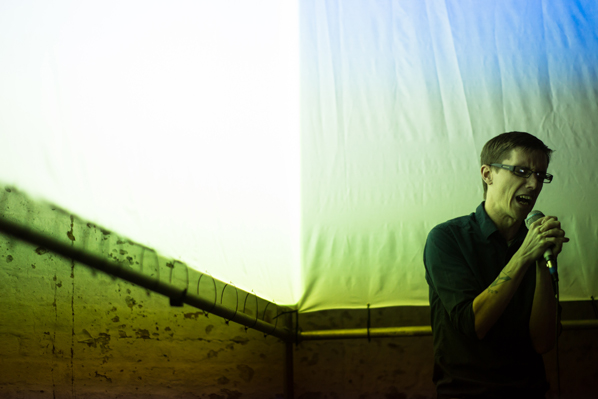
A live performance-cum-guided-meditation, SHRINE was made in collaboration with the band Outfit and performed by lead guitarist Nick Hunt. Against the backdrop of a consistent electronic hum, the light of multiple projections alternates to produce a strobe-like effect. After the instruction to close our eyes, a distant reverberant monologue begins: “What is the meaning of asteroid? What is the meaning of baptism?” The warm flicker on the interior of the eyelid creates a soft trance-like state and the potential hypnotic suggestion washes over us. The minimal rhythmic repetition of this basic structure continues, but strays further and further from these initial references. What is the meaning of blurred lines? … Chandelier? … D-Day? … FIFA? Alliteration and rhyming abound. Selfie. Sophie. Stonehenge. Peter Pan. Quran. Ramadan. There is an emptying out of meaning, and a breakdown of language. KKK … K. The voice has a haunted quality, that of an entity in a state beyond being human. Perhaps it is the voice of the network, which the monologue refers to as ‘watching over us’, of ‘being busy’. It promises a revelation that is coming, that is now, another world, one that we don’t reach. Ultimately it leaves us cleansed, or rinsed out. Then I learn that the work was written with the assistance of Google Instant predictions, hence the alphabetical concatenation of words. Not so far from the network watching over us after all.
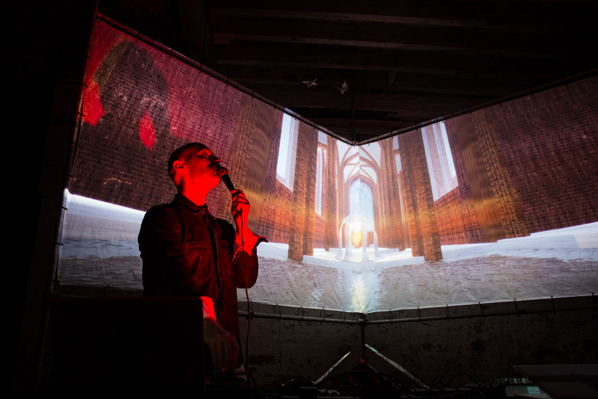
Lawrence Lek and Siôn Parkinson’s performance is the result of a short residency leading-up to the event, and therefore has a more involved relation to Syndrome. This residency structure is a recurring feature of the programme, with past residents including K回iro (Holly Herndon and Mathew Dryhurst), and before that Jamie Gledhill and Stefan Kassozoglou. Whereas these past examples involved existing partnerships, Lek and Parkinson’s collaboration was the first time that Syndrome brought together two artists, placing Parkinson’s vocal performance inside the digital landscape created by Lek.
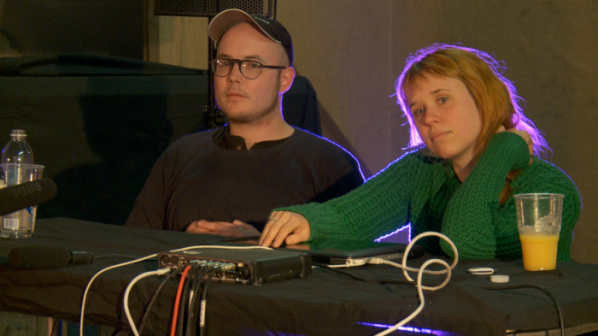
A simulation of Liverpool’s Anglican Cathedral frames the performance, and provides an imagined perspective on this familiar architecture. Starting from a removed position – with the spectral cathedral in the distance – we roam through a wood, trees blowing in the wind. This landscape glitches in a way familiar to the experience of online or virtual worlds, and is accompanied by a soundscape produced by Lek on guitar and electronics. Gradually approaching our destination, bells peal, and further sounds produced begin to resemble those of an organ, groaning and droning as we enter its interior. Parkinson’s body is silhouetted against the projected architecture, his head bathed in red light and his voice rising as Lek’s audio recedes into the background. An otherworldly sermon tells of teeth wrenched out from a mouth to form the keyboard console of the church organ. Moving from sung to spoken word, to deep guttural noises. Rumbling bass emanating from the body, amplified, and shaking the room. Lek’s guitar returns, and there is the liquid crackle of noise as water rolls down the walls, and fire inhabits the projected interior. Our point-of-view rises high above the cathedral, and we see it situated in a landscape abundant with lakes and islands, like some stretched-out fantasy where this iconic building is removed from its physical context – as though transplanted from Liverpool to another world.
These mystical images continue through to the final performance by Lars The Contemporary Future Holdus (TCF). Projecting an increasingly entangled use of technology, he plays with encryption, code and algorithms to construct a subdued visual and sonic space. Twisted and distorted beeps shudder as fragments of sound screech and scrape along the digital surface, and liquid forms slip across the projected image. This precise construction appears to breathe, the sonic utterances repeatedly sucked back inside themselves as the molten amorphous form visually expands and contracts like something from within the bodily interior. There are moments where a mouth/voice emerges, a digital blob talking to us in a language that we cannot comprehend. Behind this audio-visual surface there is something else going on, something that Lars Holdus is engrossed within as he operates the TCF system – tinkering with the algorithm to progress through a series of potential compositions. Yet despite this, I feel largely disconnected – lacking in empathy – as though missing something in what is going on. There is an evident penchant for the opaque, that creates a distance between TCF and the audience, potentially even alienates. This is acknowledged by the artist, who states: “even the presentation is an encryption in itself. And therefore the people that won’t be triggered like that won’t access it.”1 I clearly fail to trigger, and my access is denied.
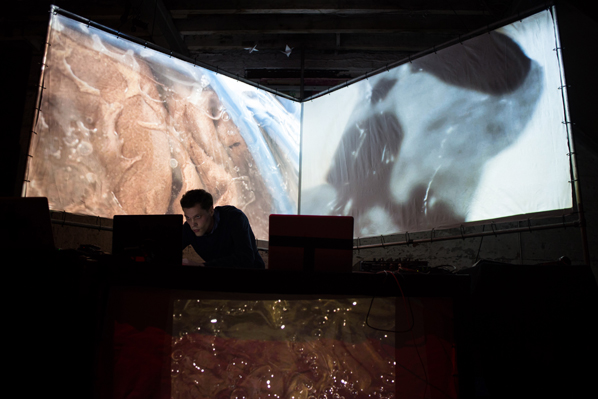
Syndrome is creating a space for artists, musicians and coders to experiment with work that merges electronic music and spoken word performance. The affordance offered by the flexibility of the venue has allowed an approach that would not have been possible within a space in daily use. These latest performative responses make clear that is it not about offering concrete proposals about what is going to happen, before they have time to come into being. Rather, what we witness is artists playing with the resources available, and figuring out what these things might do to us. There is a genuine openness and a potential intimacy to this approach, as well as the acceptance that the results will not always connect or affect audiences in the ways that they might be hope.
Different types of voice seem central to the three works presented within The Post-Human Gospel, affecting the human vocal output as well as trying to give voice to instruments, electronics and digital space. There is something in this that Holly Herndon has described as a “fleshy approach to machinery”, where these digital tools can take on a post-human quality, one that can become or embody different identities. This looks set to continue with the forthcoming event Brain/Music Experiments where artist Dave Lynch, neuroscientist Christophe de Bezenac and deaf classical musicians Ruth Montgomery and Danny Lane explore the ways a brain wave scanner can contribute to live music and visual performance.
The intention for Syndrome is to learn from all the visiting artists and the performances they create in this exploratory year. Looking for moments when performances create affective interfaces to communicate with people. Where they speculate on, or re-conceive, the relationship between human and technology. If they go on to develop a new live experience with the artistic community that surrounds Syndrome – as they suggest they will – I look forward to experiencing how the cumulative knowledge built up through these earlier events is harnessed to final affect.
Featured image: Stern, Body Language
Interactive Art and Embodiment: The Implicit Body As Performance by Nathaniel Stern. ISBN 978-1-78024-009-1 (printed publication), Gylphi Limited, Canterbury, UK, 2013. 291 pp., 41 Colour Stills.

Earlier this year, I had the good fortune to sit in on a talk given by Simon Penny on May 6th 2014 at the University of Exeter. Penny, not unlike Nathaniel Stern, is best known for his praxis, writing and teaching on interactive (and robotic) installations focusing on issues of embodiment, relationality and materiality. So as unorthodox as its inclusion is to start off a review, Penny’s reflections are pertinent here (in this case, Penny’s famous installations Fugitive (1997) and Traces (1999) [1].
The purpose of Fugitive and Traces (if you can say they had one) sought to ‘embody’ virtual reality through multi-camera infra-red sensors, visual models and real-time movements. At that time, Penny’s unique theoretical take was to distance human-computer interaction away from “a system of abstracted and conventionalised signals” to where the user would “communicate kinesthetically”: instead of investigating the non-human or “inhuman” formal qualities of its medium, or some vague VR future that leaves the body behind, the system itself would “come closer to the native sensibilities of the human.” (Penny) [2]
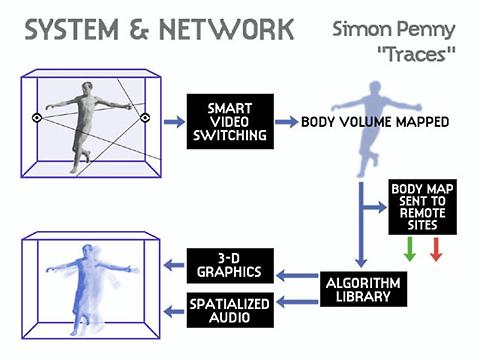

In his Exeter talk, Penny momentarily reflected on a weird and altogether disturbing seventeen year feedback loop. The loop in question relates to how, in 2014, Penny’s early avant-garde ideas and theoretical ambitions have largely been desecrated by their replication in big business. With regard to Traces, Penny cited Microsoft’s Kinect as being the most salient example of this desecration: Kinect’s technology – marketed for the Xbox console brand – carries within its insidious techniques the ability to also “communicate kine[c]thetically”, but do so within pre-packaged, patented, IP-driven, focus-grouped-out-of-existence, commercial vacuities of gamer experience.

As an early practitioner and developer of these technologies, Penny was somewhat visibly infuriated with this, and understandably so. For him, it unintentionally reduced his aesthetic experimentation, philosophical insight, technological futurity and theoretical complexity into consumer speculation for the technology market, commandeering the tech but without the value. It transposed the artistic technological avant-garde necessity of Traces into a flaccid ‘tech-demo’ demonstration of novelty limb flailing and high-end visuals devoid of anything. It was, Penny lamented, “a very weird situation” to be in. Part of that weirdness has to do with the fact that Penny hadn’t done anything especially wrong, because there wasn’t any tangible aesthetic qualities that separated his pioneering work from Microsoft’s effort. Neither had Penny’s work brought financial success with its value intact (because its value wasn’t patentable). Instead technological development had overwritten the aesthetic value of Traces, trading technological obsolescence with aesthetic obsolescence.

Penny’s retroactive predicament is not unique in the history of digital art: for all the visionary seeds of potential in Roy Ascott’s legendary networking project, Terminal Art (1980) we now recognise how those salient characteristics have somehow ended up as Skype or Google Hangouts. Still in the 80s, one might evoke Eduardo Kac’s early videotext works (1985-1986) where visual animated poems were broadcast on the online service exchange platform Minitel (“Médium interactif par numérisation d’information téléphonique” or “Interactive medium by digitalizing telephone information” in its French iteration): a proprietary precursor to the World Wide Web [3]. The retroactive weirdness accompanying these developments is something I’ll come back to: suffice to say that what counts is the direction (and sometimes hostile return) of infrastructure, not just as the background collection of assemblages artists rely on to experiment with at any historical moment, but the shifting ecological foundations to which technology emerges, affords, and now overwrites such practices. No-one likes to play devil’s advocate and yet one must ask the question specific to Stern’s text: what, or maybe where, is the tangible point at which ‘art’ becomes historically valued in these works, if that latent aesthetic potential becomes just another market for a series of Silicon Valley, or startup conglomerates?
——–
Nathaniel Stern’s Interactive Art and Embodiment establishes two first events: not only Stern’s debut publication but also the first of a new series from Gylphi entitled “Arts Future Book” edited by Charlotte Frost, which began in 2013. All quotations are from this text unless otherwise stated.
Stern’s vision in brief: in order to rescue what is philosophically significant about interactive art, he justifies its worth through the primary acknowledgement of embodiment, relational situation, performance and sensation. In return, the usual dominant definitions of interactive art which focus on technological objects, or immaterial cultural representations thereof are secondary to the materiality of bodily movement. Comprehending digital interactive art purely as ‘art + technology’ is a secondary move and a “flawed priority” (6), which is instead underscored by a much deeper engagement, or framing, for how one becomes embodied in the work, as work. “I pose that we forget technology and remember the body” (6) Stern retorts, which is a “situational framework for the experience and practice of being and becoming.” (7). The concepts that are needed to disclose these insights are also identified as emergent.
“Sensible concepts are not only emerging, but emerging emergences: continuously constructed and constituted, re-constructed and re-constituted, through relationships with each other, the body, materiality, and more.” (205)
Interactive Art and Embodiment then, is the critical framework that engages, enriches and captivates the viewer with Stern’s vision, delineating the importance of digital interactive art together with its constitutive philosophy.
One might summarise Stern’s effort with his repeated demand to reclaim the definition of “interactive”. The term itself was a blatantly over-used badge designed to vaguely discern what made ‘new media’ that much newer, or freer than previous modes of consumption. This was quickly hunted out of discursive chatter when everyone realised the novel qualities it offered meant very little and were politically moribund. For Stern however, interactivity is central to the entire position put forward, but only insofar as it engages how a body acts within such a work. This reinvigorated definition of “interactive” reinforces deeper, differing qualities of sensual embodiment that take place in one’s relational engagement. This is to say, how one literally “inter-acts” through moving-feeling-thinking as a material bodily process, and not a technological informational entity which defines, determines or formalises its actions. A digital work might only be insipidly interactive, offering narrow computational potentials, but this importance is found wanting so long as the technology is foregrounded over ones experience of it. Instead ones relationship with technological construction should melt away through the implicit duration of a body that literally “inter-acts” with it. In Stern’s words:
“…most visually-, technically-, and linguistically-based writing on interactive art explains that a given piece is interactive, and how it is interactive, but not how we inter-act” (91)
Chapter 1 details how aesthetic ‘vision’ is understood through this framework, heavily criticising the pervasive disembodiment Stern laments in technical discussions of digital art and the VR playgrounds from the yesteryear of the 90s. Digital Interactive Art has continually suppressed a latent embodied performance that widens the disembodied aesthetic experience towards – following Ridgway and Thrift – a “non-representational experience.” Such experiences take the body as an open corporal process within a situation, which includes, whilst also encompassing, the corporal materiality of non-human computational processes. This is, clearly, designed to oppose any discourse that treats computation and digital culture as some sort of liberating, inane, immaterial phenomenon: to which Stern is absolutely right. Moreover, all of these material processes move in motion with embodied possibilities, to “create spaces in which we experience and practice this body, its agency, and how they might become.” (40) To add some political heft, Stern contrasts how the abuse of interactivity is often peddled towards consumerist choice, determining possibilities, put against artistic navigation that relinquishes control, allowing limitless possibilities. Quoting Erin Manning, Stern values interactive art’s success when it doesn’t just move in relation to human experience, but when humans move *the* relation in experience (Manning, 2009: 64; Stern, 46).
Stern’s second chapter moves straight into a philosophical discussion denoting what he means by an anti-Cartesian, non-representational, or implicit body. Heavily contexualised by a host of process, emergent materialist thinkers (Massumi, Hayles, Barad), Stern concentrates on the trait of performance as the site of body which encapsulates its relationally, emergence and potential. The body is not merely formed in stasis, (what Stern dubs “pre-formed” (62) but is regularly and always gushingly “per-formed” (61) in its movement. Following Kelli Fuery, the kind of interactivity Stern wants to foreground is always there, not a stop-start prop literate to computer interaction, but an effervescent ensemble of “becoming interactive” (Fuery, 2009: 44; Stern, 65). Interactive art is not born from an effect bestowed by a particular medium of art making, but of “making literal the kinds of assemblages we are always a part of.” (65)

Chapter three sets out Stern’s account for the implicit body framework: detailing out four areas: “artistic inquiry and process; artwork description; inter-activity and relationally.” (91) Chapters four, five and six flesh out this framework with actual practices. Four considers close readings of the aforementioned work of Penny together with Camille Utterback merging the insights gained from the previous chapters. What both artists encapsulate for Stern is that their interventions focus on the embodied activities of material signification: or “the activities of writing with the body” (114) Utterback’s 1999 installation “Textrain” is exemplary to Stern’s argument: notably the act of collecting falling text characters on a screen merges dynamic body movements with poetic disclosure. The productions of these images are always emergent and inscribed within our embodied practices and becomings: that we think with our environment. Five re-contextualises this with insights into works by Scott Scribbes and Mathieu Briand’s interventions in societal norms and environments. Six takes on the role of the body as a dynamic, topological space: most notably as practiced in Rafael Lozano-Hemmer. Chapter seven I’ll discuss near the conclusion: the last chapter shortly.
Firstly, the good stuff. Interactive Art and Embodiment is probably one of the most sincerest reads I’ve encountered in the field for some time. Partly this is because the book cultivates Stern’s sincerity for his own artistic practice, together with his own philosophical accounts that supplement that vision. His deep understanding of process philosophy is clearly matched by his enthusiastic reassessment of what interactive art purports to achieve and how other artists might have achieved it too. And it’s hard to disagree with Stern’s own position when he cites examples (of his work and others) that clearly delegate the philosophical insights to which he is committed. One highlight is Stern’s take on Scribbes’ Boundary Foundations (1998) and the Screen Series (2002-03) which intervenes and questions the physical and metaphorical boundaries surrounding ourselves and others, by performing its questioning as work. This is a refreshingly earnest text, proving that theory works best not when praxis matches the esoteric fashions of philosophical thinking, but when art provides its own stakes and its own types of thinking-experience which theory sets out to faithfully account and describe. Stern’s theoretical legitimacy is never earned from just digesting, synthesising and applying copious amounts of philosophy, but from the centrality of describing in detail what he thinks the bodily outcomes of interactive art are and what such accounts have to say: even if they significantly question existing philosophical accounts.
Stern leaves the most earnest part of his book towards the end in his final semi-auto-biographical companion chapter called “In Production (A Narrative Inquiry on Interactive Art)”. This is a snippet of a much larger story, available online and subject to collaboration [4]. Here, Stern recounts or modifies the anxiety inducing experience of being a PhD student and artist, rubbing up alongside the trials of academic rigour, dissertation writing and expected standards. Quite simply, Stern is applying his insights of performative processual experience into the everyday, ordinary experiences faced by most PhD students in this field, and using it to justify a certain writing style and a sense of practice. It’s an enjoyable affair – in large part because it outclasses the dry scholarly tone usually associated with writing ‘academically’, elevating imaginative, illuminating redescriptions for how the experiences of interactive art broadly hang together rather than relying on relentless cynical critique. And most of that is down to Stern’s strong literary metaphorical technique for grounding his vision, perhaps even more effectively than the previous chapters.
Yet earnest experiences aside, there are two problems with Stern’s vision which, in my eyes, leave it flawed. That isn’t a bad thing: all visions are flawed of course. That’s why the similarities between art and philosophy feed our heuristic, academic compulsion to come up with them and debate: well, that and sometimes the most flawed can end up being the most influential. Such flaws only arise in relation to what Stern thinks is valuable in interactive art, and to the extent that the intervention posed may require readdressing. The flaws in question are composed from two different angles, but stem from one objection. The first is philosophical, or at least a problem pre-packaged with relying almost entirely on relational ideas of embodied emergence. The second is more tied to infrastructure and technical expropriation as outlined in Penny’s predicament given from the outset.
In his introduction, Stern makes clear that this is an “art philosophical book” (4), not a philosophy of art as such: only one that “understands art and philosophy as potential practices of one another” (4). Following Brian Massumi, philosophy “tells us the stakes”, whilst “art brings those states to the table” (5), such that the type of art he values and constructs, (digital interactive art) is precisely that which melts away in its interactive encounter when constructed as work. Later on we discover that interactive art “interrupts relationality” (66), making present an “intervention that brings a situated moving-thinking-feeling to a higher power.” (66) Further on, interactive art does something else, when it “intensifies features of […] the ongoing transformation of the ‘living’ body”, and “gifts us with a state to practice being and becoming.” (73) Reflecting on the infamous Bourriaud/Bishop relational aesthetic ruckus a decade ago, Stern outlines how they focus on the explicit body (82) (how we understand ourselves or challenge explicit social/economic positions in the world), whereas artworks which privilege the implicit body have us “encounter how we move, transform, and are (continuous)” (82) in the world. The former takes on the materiality of social relations, the latter (endorsed by Stern) takes on the whole materiality of “embodied relations” (83). And again to reiterate, art operates as “the practice of contemporary philosophies, where we investigate, and further research on, embodiment and relationally together.” (83).
Now, one should admire how Stern blends philosophy and art praxis together precisely by not shoehorning authoritative philosophical accounts into art praxis where they aren’t needed. This works, precisely as the ontology expressed here actively resists such authoritative accounts as well as being cemented with the sort of sincerity with which Stern has such a keen literary grasp. More importantly, Stern cites works which seem to fit the stakes of his ontological conviction perfectly.
However the reliance of process-based philosophy dampens exactly how these works intervene to bring about the values he so desires. The simplest objection comes from asking how Stern might value anything at all, if our entire relational embodiment with the world is constantly in process – or that “[b]odies and matter are change” (220) – and must be always affirmed as such: why should every process and every bodily interaction be affirmed? Moreover why is it art’s place to give primacy to the ontological events of bodily material change?
This is one of the key infrastructural problems that surface, once a theory of art totally subscribes to a process-based ontology, let alone one focusing on embodiment: why should an artist like Stern feel compelled to present an intervention in the first place? If the dominant ontological movement of interactions is a becoming-event, by what standard or eruption should interactive art be said to work on? If, as Stern believes, “the interactive process in interactive work is the ‘work’” (159), it becomes unclear what value interactive artworks are purported to convey, if that process is all there is. To say that embodied processual events make the work “work”, because they underscore our situational intelligibility (or make it effective – so to speak) speaks nothing of what differential criteria should apply to make that aesthetic intervention intelligible. To hazard a guess, the problem is one of articulating how convention exists in a process ontology: because if everything is always emerging as an interactive event of change, the act of rupturing or intervening in convention becomes a real problem. The criteria for valuing these important works is only affirmed it seems, because every process is already affirmed: and if that’s the case you don’t need artists to make an intervention – there is no intervention required, other than the events that already exist, as change in themselves. To put it another way: why should (and how can) a work effectively gift us heightened states of being and becoming, if our entire situational relationship with the world is already situationally related in being and becoming?
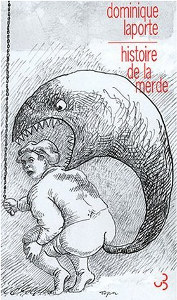
I am reminded of Adrian Johnston’s 2001 review of the newly republished English translation of Dominique Laporte’s History of Shit (first published in 1978). Whereas most Foucaultians and Althusserians were disconcertingly vague in pointing out the concrete material conditions for subjectivity and economical production, Laporte boldly contended that the genealogical hypothesis to all modern civilisations was tied to one concrete material condition: the infrastructure of bodily waste management, or, the desire to control and sublimate our need to defecate. In his usual Žižekian repartee, Johnston suggested that Laporte’s bizarre history of modernity implicitly accepted the anti-Cartesian embodiment thesis (that cognition cannot be separated from the actions of the body), but pushed its logic to the end. That for all the affirmative, encompassing, sensual, emergent, potential images embodiment philosophy prefers to agree and discuss, it completely ignores one of our central and basic bodily requirements: to excrete our bodily waste or fecal matter, and remove it from sight and smell (and we don’t need to remind the reader of art’s fascination with this area).
Whilst Johnston’s tongue was firmly planted in his cheek, he did happen to put a psychoanalytical finger on the central problem with process based embodiment. That often enough, sincere accounts of embodiment designed to affirmatively depict and encompass implicit environment material engagements leave behind an unacknowledged stain: one which says more about these accounts than their proponents actually do. And it is precisely because Stern focuses on the most aesthetically agreeable areas of bodily engagement in interactive art, that something as habitual and ritualistic as the excretion of digested matter, or the infrastructure of sewage networks exposes that image.
In terms of materiality this is doubly important. Laporte’s intervention brings into conflict two competing performative materialisms which disclose our own bodily relationships with non-human processes (in this case, computational and networked material): the first is Stern’s own account of the material body as some sort of ‘nebulous material’ which is always emergent, lived, relational and thinking with its own engagement in the world of humans and non-humans. The second is Laporte’s material body seen as ‘brutal material’ – an explicit input-output, complex, evolutionary processing machine, strictly determinate and bounded in its biological function. Despite Stern arguing earnestly for the nebulous form, it doesn’t appear to me that he can hold off the brutal form, or at least prevent the latter from antagonising the former. And often enough, this happens because Stern’s accounts of embodiment, and the philosopher’s accounts he relies on, are already meant to be nebulous in themselves.
This logic unravels by chapter seven, when Stern expands the implicit body framework to analyse other examples of new media art which aren’t preoccupied with bodily participation to work, as work. He terms this “potentialized art” (206) where “audience members do not *make* the work directly through their interactions (207) but are subject to visual performances of potential movement and relation mediated by generative computation and networks. In citing Gordan Savičić and Jessica Meuninck-Ganger – amongst others – Stern argues that these ongoing performances harness generative information participating in embodiment relations, and invite metaphorical sensory change and bodily movement (in the case of Savičić’s performances, quite literally inflicting pain and suffering onto his own body using network data and social media).
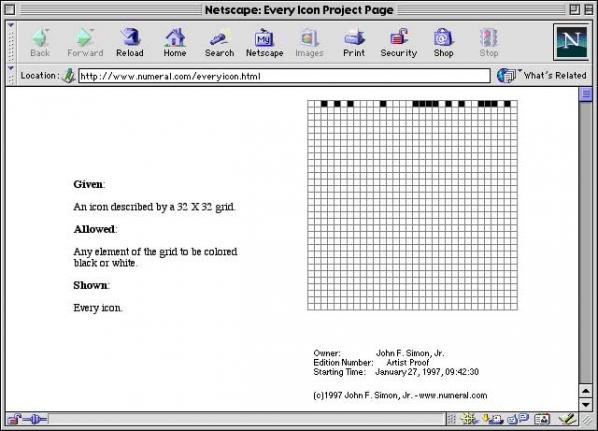
However when Stern cites John F. Simon. Jr’s infamous work Every Icon (1997), (227 – 230) (a cellular automation piece which takes approximately several hundred trillion years to complete) it becomes clear to me that the aesthetically agreeable areas of embodiment start to break down. It might be that my own reading of the piece is fairly unorthodox [5] (I don’t consider the work to be primarily conceptual for a start), but Every Icon eschews what Stern writes as giving “both the corporeal and incorporeal a present and future presence as time and sign” (230) or something that generates attention to our “sensual and conceptual experience of temporality” (230).
Yet, isn’t it the case that Every Icon is probably one of the least potentialised artworks ever made? It doesn’t actually generate anything, (in the strict sense of unpredictable outcomes from simple rules) it simply enumerates configurations of pixels one by one. Neither can we be said to “feel the potency of several hundred trillion years” (230) than we feel the cold, indifferent execution of a real java applet function to which we are forever limited in experiencing directly. If anything, Every Icon is deliberately constructed to forgo a relation with us.

To conclude: this is perhaps why Penny’s predicament with the Kinect is so stark. To demand, as Stern does, that we treat digital interactive art as setting a stage for examining how we “per-form” with our bodies within media, material, conceptual frames and selves, is no longer enough of a stage to give voice to the technological ecologies we find ourselves in: nor of the art that satisfies intervening in it. Credit must be given to Stern for writing over interactive art’s emancipatory myth of disembodied immateriality, but his endorsement of embodiment only serves to realise that the problem isn’t forgetting to focus on material engagement, but forgetting the cold, hard and brutal materiality of procedural performance of infrastructure, that often moves faster than we do. When Microsoft’s Kinect co-opts all the same values of Traces, it does so not because embodiment is totally flawed, but that bodily movement has now become ecologically implicated in deceptive infrastructure.

Just as Penny’s Traces may once have evoked a renewed attention to moving-thinking-feeling, such engagements are now suitably tracked and are in service of non-transparent infrastructures of geo-social activity, which propagate themselves beyond our sensory engagement, yet paradoxically they also indirectly sustain that ordinary engagement. For example, this is now a world where Google funds a 60tbps undersea cable connecting the West Coast to Japan, in order to propagate the reach of their services. The technological engagement of our bodies cannot be restricted to how we move-think-feel, but now weaves itself within layers upon layers of platforms and pervasive surveillance structures. And I don’t disagree with Stern that the implicit body is, perhaps, deeper than the account I give here. But maybe that’s because the body is also another type of performative infrastructure, tightly bound into other formations that are just as deep, complex and engaged. We now live in a time where digital interactive art has to intervene in the performances of geo-social infrastructure: where our bodies have curiously taken on their self-directing performances, rather than our own.
[Notes:
1. These are the minimally reformatted and slightly expanded notes for what would have been a 15-minute presentation.
2. The presentation was meant to be followed by questions and form part of the introduction to a panel discussion. Any questions in the comments here or on netbehaviour gratefully received.]
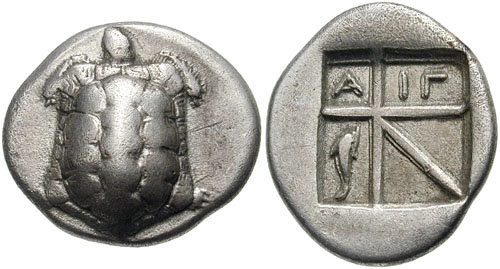
Art and money have always been involved in each other’s production. This is a Greek Drachma from 600BC with a relief depiction of a sea turtle on one side. For many people this would be the artwork, or at least the image, that they saw most frequently in their everyday lives.
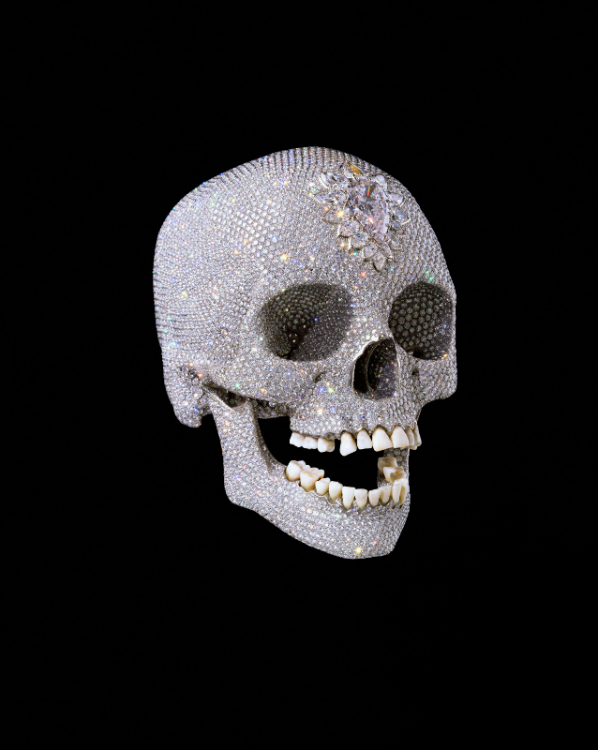
In the present day, high art and high finance (or big art and big finance) go hand in hand. Blue chip artworks produced by brand name artists like Jeff Koons are collected by hedge fund managers and oil oligarchs as investments and as signifiers of socioeconomic position (while stolen Old Master paintings are used as signifiers of value in transactions between criminal gangs…). This tendency reaches its logical conclusion for now with Damien Hirst’s “For The Love of God” (2007), a diamond-encrusted platinum cast of an actual human skull complete with the original teeth. It was sold for fifty million pounds sterling.

Looking inside the sale of “For The Love Of God” makes its narrative less straightforward. It was sold to a group including the artist and their dealer, making the actual figure and its ownership less straightforward than a simple sale would suggest. Nanex’s High Frequency Trading visualizations from 2010 look inside transcations in electronic stocks & shares markets, finding aesthetic forms in the activity of share trading bots. What the sawtooth waves of this bot’s activity represent is unknown: a glitch, a strategy, a side-effect. But without making these forms visible, we would not be able to ask these questions or reflect on this economic activity.

It is part of the value of art, particularly Conceptual Art, that it can afford us these opportunities for reflection and critique. Cildo Meireles’ “Insertions Into Ideological Circuits 2” (1970) overwrites the contemporary equivalent of the Drachma’s turtle with a rubber stamped message on a banknote, intruding into everyday use and circulation of currency in order to give its audience a pause for critical reflection.
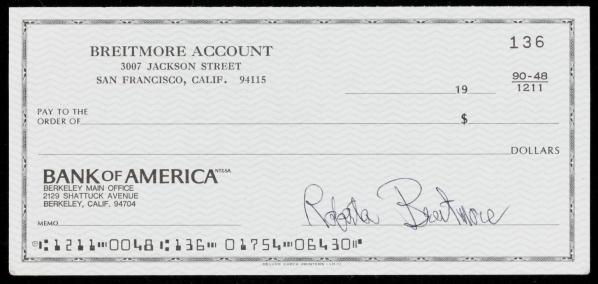
Lynn Hershman’s “Check” (1974) is signed by their artistic alter ego Roberta Breitmore, using financial transactions and their attendant contracts as a producer and guarantor of identity, literally underwriting it.
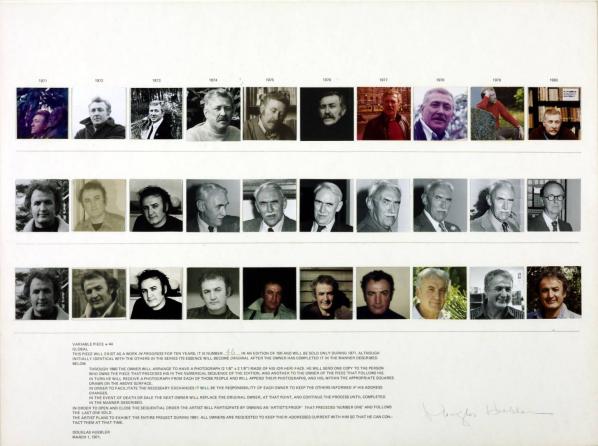
Douglas Huebler’s “Variable Piece no.44” (1971) incorporates an image of its current owner into itself each year for its first decade, in an analogue precedent for Bruce Sterling’s idea of “spimes”. When the artwork is sold a new owner appears, making the artwork’s contingent economics its aesthetic subject.
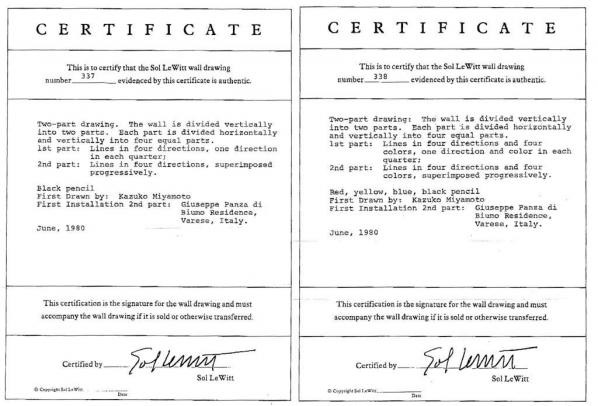
The initial critique of the ontology and economics of art that Conceptual Art represented in its “dematerialisation” phase represented as much of a challenge for the livelihoods of artists as it did to its chosen targets. One solution found early on was to produce certificates of authenticity or ownership for otherwise un-ownable art. This re-appropriates conceptual art for scarcity economics and as property, returning it to the market. Sol LeWitt’s certificates for two wall drawings (1980) demonstrate how this works. If you own such a certificate and I do not, and we both follow the instructions on the certificate, you produce an authentic LeWitt and I at best produce a forgery.
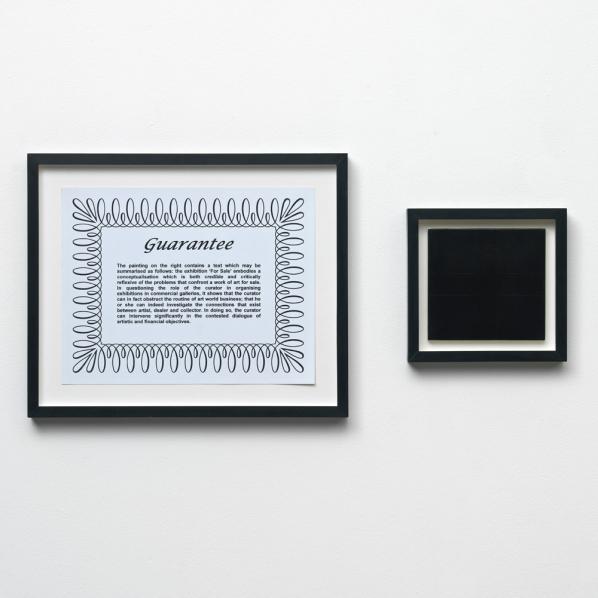
This stretegy was criticised (and parodied) within the Conceptual Art movement itself. An early Art & Language artwork, “Guaranteed Painting” (1967), contains a printed certificate guaranteeing that the painting accompanying it contains particular content and addressing the curator of the show it appears in as someone who can possibly intervene in artworld economic relationships.
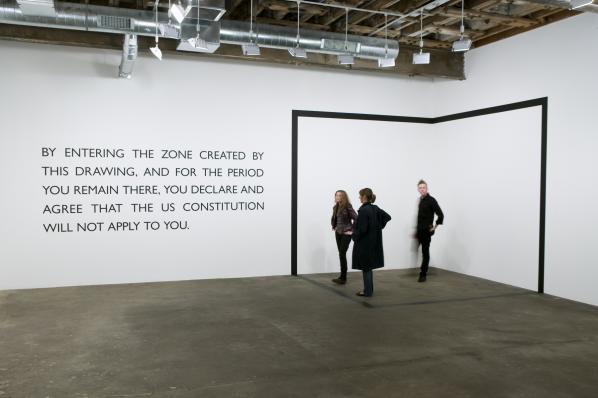
Carey Young’s “Declared Void” (2005) is a wall drawing that creates a space in which its audience enters into a contract agreeing that the constitution of the United States. Legal form as sculptural form, this is no longer about the relationship between art and money but rather between the individual, contract law, and the state. This is the kind of relationship that produces money, or at least fiat currency, and is a broader context for considering the more specific relationship between art and money.

I love this flower currency from 2005, produced by a group of Viennese artists. It’s both a LETS-style complementary currency and a use of the aesthetics of pressing flowers to allegorize and aestheticize the relationship between nature, production, and value in economies.
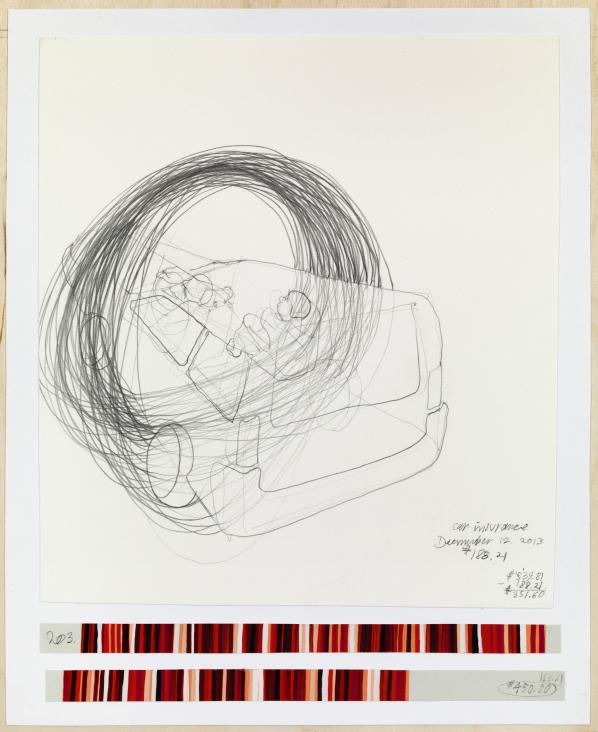
This Danica Phelps stripe drawing (2013) shows the artist’s expenditure on reparing their car. If it depicted income rather than outcome the stripes would be green rather than red. Phelps’ work combines the ledger of their economic existence with the artistic record of their social presence.
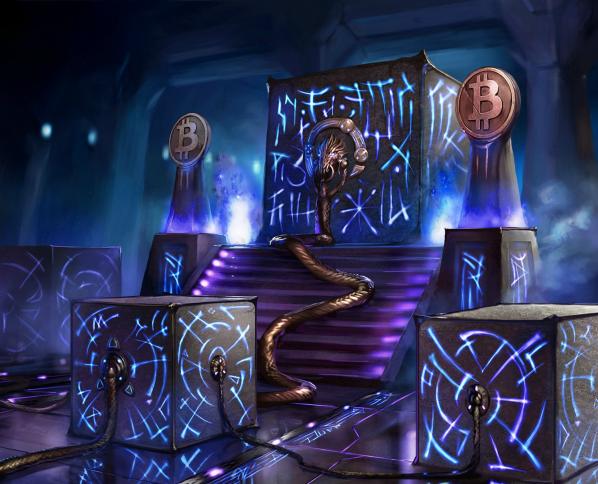
Bitcoin emerged as a critique of state-issued “fiat” currency following the financial crisis of 2008. Bitcoin is a cryptocurrency, a piece of software that runs on computers (“nodes”) spread across the network that communicate with each other to reach a shared consensus on the current state of a cryptographically-secured ledger. Every ten minutes or so these computers bundle up transactions into “blocks”, each of which refers to the previous block. This is the “blockchain”. This is yodark’s fanciful depiction of the blockchain proceeding from the first block of transactions, the “genesis block”.
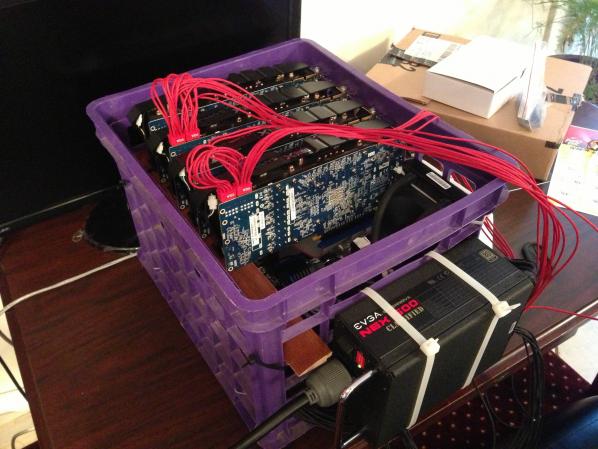
In reality news blocks in the chain are validated (or “mined”) by nodes in the network using increasingly specialised hardware, such as this milk crate mining rig from a couple of years ago. They perform difficult to solve but easy to validate sums on each block, the “proof of work”, and the first node to succeed gets a reward (paid in Bitcoins) for doing so.
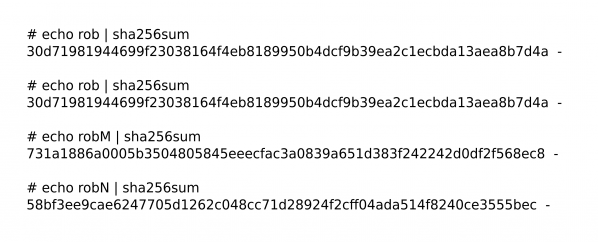
Bitcoin account addresses, Bitcoin transactions, and the proof of work system all use cryptographic algorithms. These are mathematical ways of taking data and creating an almost un-fakeable, almost un-reversable, almost unique (where “almost” means “as likely to fail as the Earth is likely to be hit by a civilization-ending asteroid in the next 20 minutes”) identity for it. The examples here show how feeding a cryptographic hash function the same data twice results in the same incredibly unlikely number, but feeding it even slightly different data results in very different and unrelated numbers.
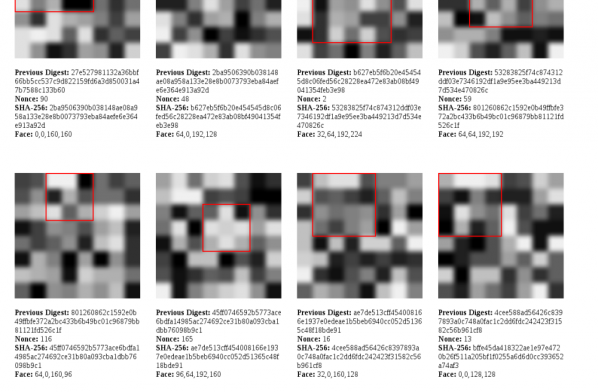
Bitcoin uses these functions to secure its network in the “proof of work” system by searching for auspicious numbers in their output (strings of zeroes in the current scheme). My Facecoin (2014) implements an alternative proof of work system in which the useless work performed is that of portraiture, (mis-)using machine vision algorithms to find imaginary faces in cryptographic hashes represented as bitmaps rather than numbers.
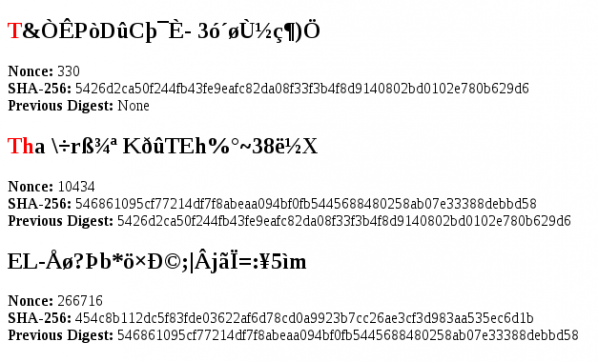
My Monkeycoin (2014) takes a different approach, searching for the complete works of shakespeare in textual representations of those numbers.
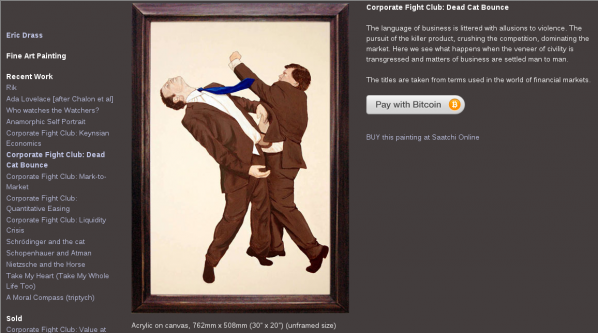
Cryptocurrencies can be used in lieu of fiat currency for all kinds of transactions, including artistic ones. Here the artist Eric Drass is offering a painting for sale via Bitcoin. Different means of exhange create different kinds of social relationships, buying the painting via Bitcoin is a different kind of social and economic transaction than paying with fiat currency for it via Saatchi Online.

Cryptocurrencies can be created as complimentary currencies with specific intent or for specific constituencies. This is the logo of Banksycoin (2014), an attempt to create a currency to pay for art and create a parallel economy for artistic production.
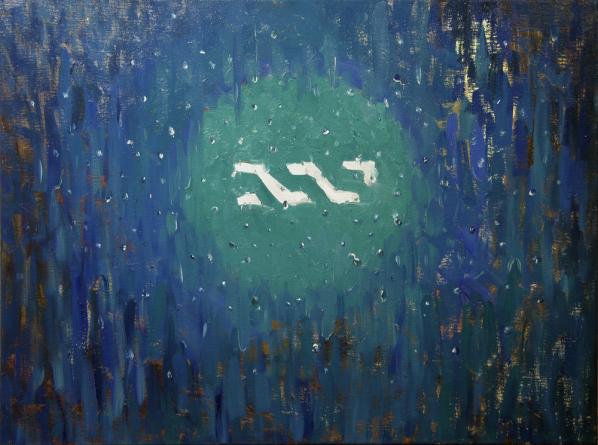
Cryptocurrency-based technology can change how individual artworks are owned as well as paid for. This is theironman’s “nxtdrop” (2014), the ownership of which is represented by shares on the “nxt” blockchain. Ownership of the painting can be changed fractionally by dealing in those shares.
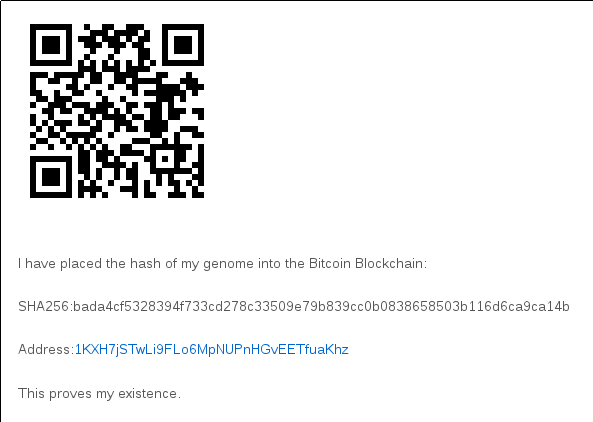
There are poems, images, and other cultural artefacts embedded in the Bitcoin blockchain, disguised as transaction information. I embedded the cryptographic hash of my genome in the Bitcoin blockchain to establish my identity with “Proof Of Existence I” (2014).
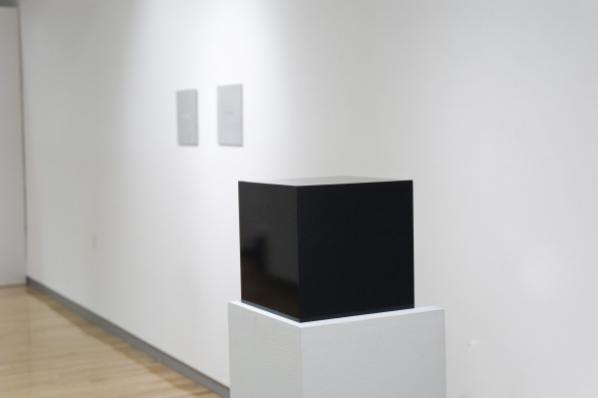
This is Caleb Larsen’s “A Tool To Deceive and Slaughter” (2009). It contains a computer that must be connected to the Internet as part of the conditions of ownership, which then immediately offers itself for sale on the eBay auction site. This kind of “smart property” is a good example of smart contracts, in which arrangements such as ownership are managed by software rather or more immediately than by law.
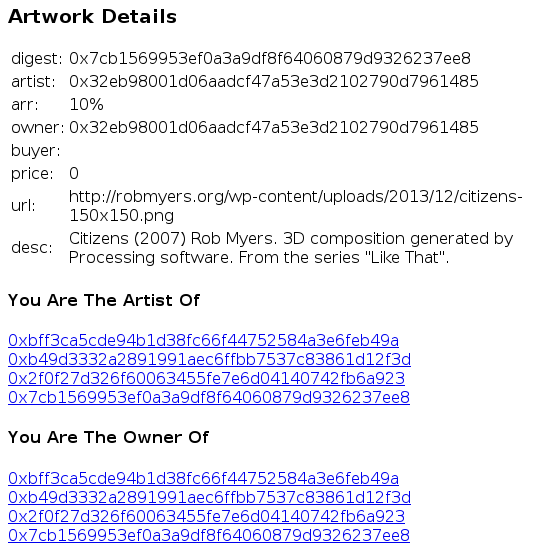
My “Art Market” (2014), uses the Ethereum smart contract system (a generalization of Bitcoin to contracts other than for the exchange of money) to record “owenrship” of infinitely reproducible digital files and allow them to be “sold” for cryptocurrency. Other systems exist to do this, such as the Monegraph and Rarebit systems.
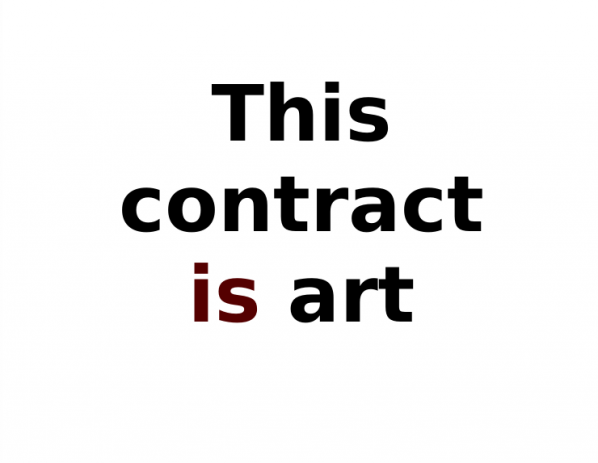
My “Is Art” (2014) uses a simple smart contract to democratize the nominational strategy of conceptual art. The contract can be set to nominate itself as art or not with a click of a mouse and the paying of a small fee to execue the change on the blockchain.
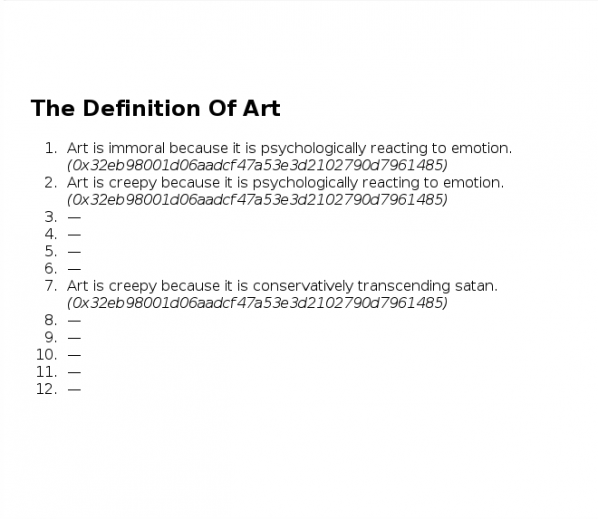
My “Art Is” (2014) applies behavioural economics to the philosophy of art, allowing individuals to pay as much as they feel their definition of art it worth. This disincentivises malicious or unserious definitions and indicates an individuals’s confidence in their definition, using market mechanisms to price and allocate knowledge and even truth efficiently. fnord
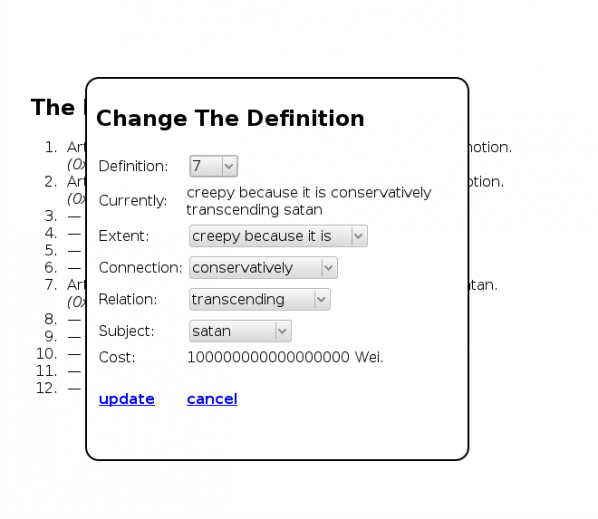
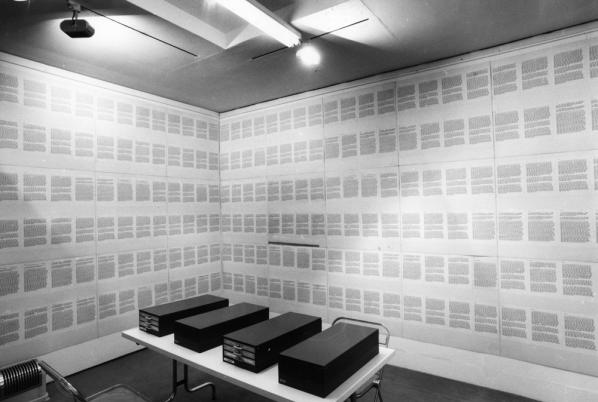
This is Art & Language’s “Index 002” (1972), a collection of the group’s writings assembled and indexed for presention in a traditional gallery setting to assert their identity and productivity at a time when their largely conversational practice might not have looked much like “art” to outside observers. Filing cabinets and photocopied sheets were contemporary information technology, later “Indexes” would use microfilm and (allegedly random) computer-generated tabulations. Their use and the production of the “Indexes” was both a solution to and a subject of the problems of Art & Language’s work. A contemporary group could use the blockchain to similarly focus and problematize their work.
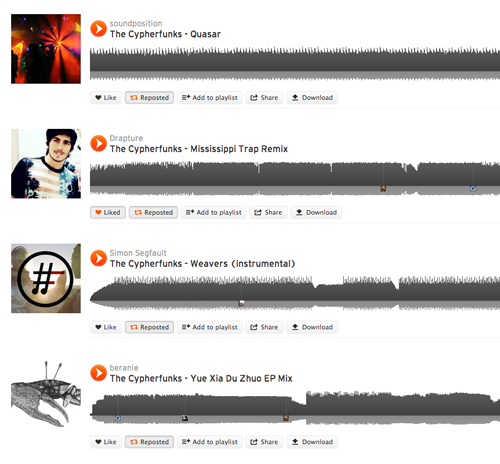
The Cypherfunks are a distributed music group. Anyone who uploads a song to the SoundCloud music sharing web site tagged #thecypherfunks receives the groups cryptocurrency FUNK in return, becoming part of the group.
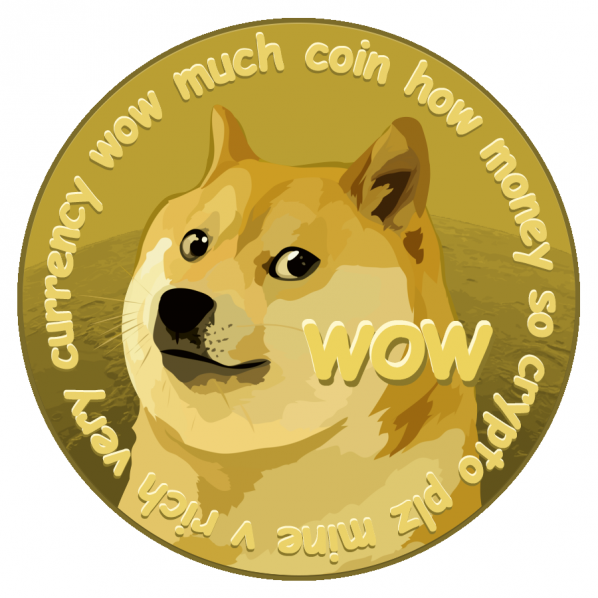
Dogecoin is one of the most popular “altcoins”, Bitcoin-derived cryptocurrencies that are not interoperable with the original Bitcoin network. It is the coin of an intentionally constructed culture of virtue and play, with its own argot and social norms based on Internet memes (particularly the titular “Doge” and the idea of a potlatch-like norm of tipping).
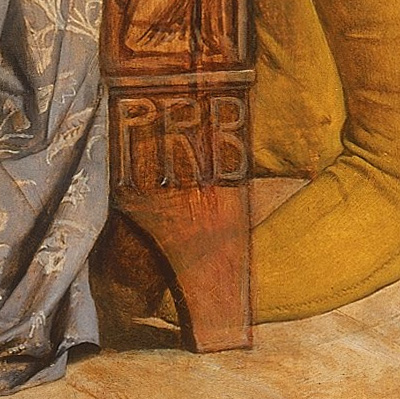
These are all more contemporary, and more complex, ways of demonstrating affiliation to a group than simply painting currency code-like letters on a canvas (this is a detail from Millais’ “Isabella” (1849). Possibly the ultimate in creating a group affiliation, or even a society, using smart contract technology is the idea of “Decentralized Autonomous Organizations” (DAOs), economic agents that exists on the blockchain and manage the resources of an organization via code rather than bylaws or legislation.

This is “The People’s Republic of DOUG”(2014), a DAO implemented as smart contracts on the Ethereum smart contract system’s blockchain. You can become a citizen, own property, vote, use its own currency in transactions, all functions traditionally provided by the state as conceived of in terms of contract law. Bitcoin’s dream of a stateless (but not property-less, making it anarcho-capitalist rather than anarchist) future realised in a few thousand lines of code. Imagine using (and/or critiquing) such a system for artistic organization and/or production.
“Now make art with it.”
Featured image: Curt Cloninger’s ‘Twixt The Cup And The Lip #3
“A glitch is more than an error: It is a rupture in our collective techno-hypnosis, a herald of underlying realities.” – Paul Hertz
If you haven’t heard about Chicago glitch, you haven’t been paying attention to all the “noise” emanating from the Windy City. The self-proclaimed “dirty new media” crowd in Chicago has captured the imagination of artists around the world with their funky (as in Chicago blues), punk-inspired disruptions and hacked creations. As of this writing, glitChicago: An Exhibition of Chicago Glitch Art at the Ukranian Institute of Modern Art is about to close after an impressive two-month run, with works, performances, and discussions involving 22 artists heralding from Chicago and beyond.
While glitch may have a raw, subversive, outlier sensibility, it has also catalyzed a cohesive and collaborative group of artists that has organized an impressive array of community-based conferences, DIY workshops, exhibitions, and spontaneous happenings within the local media culture over the past five years. Ironically, the Chicago high-art academy is also a co-conspirator, as many of the glitch artists are based at the School of the Art Institute of Chicago, which has become the de facto experimental laboratory for the study and practice of glitch.
I spoke via web-conference with the show’s main organizer, artist and historian Paul Hertz, along with two of the artists and co-organizers, Nick Briz and Jon Satrom, in a collective effort to unpack the glitch phenomenon.

Randall Packer: Nice to meet everyone in the third space. I am going to begin with Paul because you were primarily responsible for organizing glitChicago. There are many artists in the show who do not reside in Chicago. Is the work intended to demonstrate Chicago glitch tendencies and influences, or perhaps to situate Chicago as a spiritual home of glitch, like say Chicago blues?
Paul Hertz: I think the latter to some extent, but it’s also a joke about location in a networked society.
RP: From the perspective of being outside of Chicago, I can’t think of another place in the world right now that has a more cohesive community of artists working together, building things together, breaking things together, it’s quite an extraordinary moment in time in Chicago. So my question is: how much diversity, difference of opinion, even polemical positioning is there between the artists who are part of the glitch community.
PH: He wants us to wash our underwear!
Nick Briz: I’m glad it looks so cohesive on the outside, there is disagreement, but it’s a respectful community kind of disagreement.
RP: Nick, as the author of the Glitch Codec Tutorial, in which you describe a method of making glitch, is the idea of a “glitch tutorial” perhaps contradictory to glitch as accident, mistake or rupture?

NB: No, I think it’s the most appropriate format, because it’s not a glitch tutorial, it’s a glitch art tutorial and that’s an important distinction for me. Glitch is this unexpected occurrence within a system that we come to with a certain set of expectations, and a glitch is when those expectations are broken. Glitch art is when that happens intentionally. For me, this is a personal thing. What’s really special about glitch art as a practice are the realizations you come to when you instigate those moments, the political potential for drawing certain connections, for exposing certain invisible politics within a system. That happens in process. So to produce a tutorial is not only, technically, how you produce glitches for your work, but also for people to have those realizations themselves, really experiencing glitches.
RP: So, how does that relate to the idea of intentionality, accident, and indeterminacy in glitch. Is there a right or a wrong way of doing glitch?
Jon Satrom: No, I don’t think there is a right way to do the wrong thing. I think Nick said it in his performance: “do it wrong the right way.”
NB: Do it wrong, but also doing it wrong. As in doing it wrong is the way that you do it. And then I quoted you, Jon: “there are no right ways to provoke the glitch, only the wrong ways prevail.”
JS: I think the right way to do it wrong is to always cycle back or “level up” or go “meta” to a point where you are able to view what you are doing as a structure so that you can then glitch it again.
PH: Once you have a formula though, in a sense, you’ve captured something, but it is no longer glitching when you start saying that there is a right way and a wrong way.
RP: I am curious about this problem of glitch as style, glitch as genre, glitch as a pre-determined method. It seems there is a need to avoid stylization, avoid the predictable, to avoid the preset. So it does seem as though there are boundaries to glitch, there is an area where you don’t want to go.
JS: I feel like everything is fair game.
PH: There were places we had already gone where we weren’t likely to go again and so you could say farewell to jpeg glitching, farewell to png glitching, jpeg2 glitching, to datamoshing. I have argued that those are more like tools that we have and it’s about the new technologies. Going into the show I was quite prepared actually to say that glitch is now art historical, that’s why I was doing the show. But I was surprised at how lively the subculture is, how lively the artists are who have gone on to do new things. I think glitch belongs in many ways to an earlier tradition of noise, and in that sense, it has a history, it has a future in all kinds of directions.

RP: The idea of history seems like a dark cloud that hangs over the practice of glitch, to avoid becoming rigid or formed. In regard to the roundtable discussion you just had, Paul asked the question: “once we induct glitch art into art history, is glitch art dead?” What was the outcome of this discussion? Is glitch as we know it history, has it already become part of the art-historical discourse?
PH: We did shift the conversation a little and started by talking about glitch as having a memory and glitch as having a potential future. And I think we sidestepped the history question by and large. But it was stated by a number of people, including Curt Cloninger in his essay for the show that as long as there are new technologies, there are going to be new glitches.
RP: So is there a reason why the historical question was avoided?
PH: I think it became uninteresting as time went on. We’re having so much fun just doing it, it doesn’t seem like such a serious question. It seems like a question an art historian would ask.
RP: But Paul, you’re an art historian!
PH: We all got around to being artists again.
JS: I think that when you look at history as a rigid structure and if you take a glitch perspective towards a rigid structure you’re looking at it as something that isn’t as static as may come across. Histories are presented in different ways, different agendas, different people, and I think it’s more interesting to consider our job as glitch artists to create structures that are radically inclusive, and experimental, and have enough space for agency, and individuality moving forward, rather than considering whether or not it is dead.
RP: Returning to the glitChicago show, which aspired to the inclusive, open source, community-based, DIY nature of glitch: Nick, you’re project is called 0p3nr3p0…
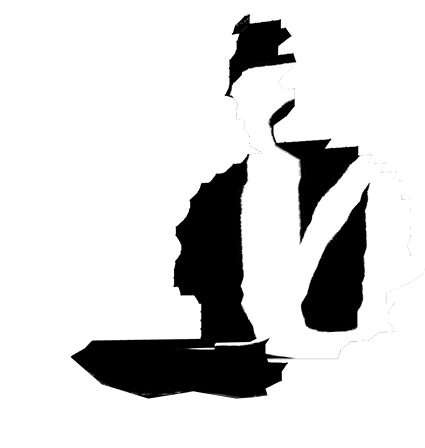
NB: It’s pronounced “open repo,” short for open repository.
RP: How does this project involve the local community as well as expand itself through the network to engage a more globally social reach?
NB: 0p3nr3p0 is at the moment a project that myself and Joseph Yolk Chiocchi maintain, an unfiltered, open port for uploading glitch art. It was an offspring of the GLI.TC/H conferences in 2010, 2011, and 2012 in Chicago. It was a result of our paranoia to be radically inclusive as a conference. So we didn’t do a call for works that last time, instead what we did was a call for threads, which is we tried to carve out spaces for other people to bring in certain conversations. And while we showed and exhibited work in the evening, all that work as best as we could was actually the result of those communities coming together. There is only so much space, there are only so many people who could show, but there are a lot of people online who we could recognize and include and so 0p3nr3p0 would become that back door entrance to the physical exhibition via the network.
RP: It seems to me that there is something about the nature of glitch that encourages democratization and inclusivity in terms of the accessibility of its practice and the techniques involved.
JS: It comes back to social structure. One way to get around the hierarchies of a social structure is to try and present things in a more populist, more open, more democratized way.
PH: There is also this transgressive aspect to glitch. Glitch itself represents a rupture, instability, of images and media. And that instability has an ideological function, as Nick is very careful to point out in the Glitch Codec Tutorial. If we are transgressing both the technology and exposing the ideology, there are reasons for us to want to expand that kind of rupture to online communities.
RP: I spoke with jonCates in an earlier interview for Hyperallergic about dirty new media. I would like to get your perspectives. Jon (Satrom), it seems like your work particularly reflects this idea as a reaction against the clean, glossy, polish of technology, a reaction against the fetish of the technological object.

JS: Yes, it is a reaction to the sleek, brushed metal of new technology. When I think of dirty new media in terms of Chicago, there is an organic quality to it, literally you can think about dirt. This dirty style: it’s the grit, it’s the rust, it’s the realization of a false promise of technology that many of us just accept and are fine with. We’re purchasing things that are broken and need updates, and yet our agency of not being part of these updates has been stripped from us. Things are changing under our feet all the time. With dirty new media, you don’t bother hiding the cords, you don’t bother sweeping up, there’s a sense of realism to it, there’s the grit, and there is also a kind of a comfort in that. It’s not trying to hide behind these mirrored surfaces.
RP: Perhaps it’s a critique of our relationship with technology in terms of humanizing that relationship.
NB: Maybe trying to take agency back in that relationship. In the computer industry, a very specific relationship has been imposed, we’re told how we’re supposed to use these things, both as consumers and as producers. As consumers we’re told this is what you are supposed to do with your technology, to have a kind of reverence for technology. Dirty new media is an irreverent response to that. And then as producers they’ve imposed a certain relationship. There are “right” ways to do things as programmers, and “right” ways to do things as media artists and dirty new media tends to be kind of punk: how can you finagle the technology. It’s through experimentation that you learn how to do things with these systems. And just like the punk ethic, once you learn those first three chords you can start a band and you’ll learn the rest of them along the way. Once the reverence is defused, and it’s OK to break things and experiment, all these things become possible.
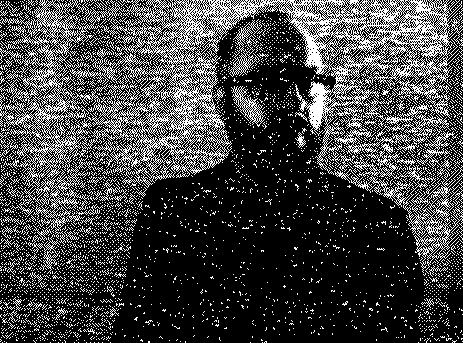
PH: I would also say there is a differentiation in dirty new media between an aesthetic and a capture of instability. There are the pleasures of the glitchy image but at the same time it’s very much about the underlying systems. It seems to me that they play off of one another and there is a certain tension there, and a healthy one.
RP: I believe there is also a tension in glitch in terms of constantly needing to move forward. This leads me to a question about Rosa Menkman, a significant artist and writer in the international glitch community. She’s written some very influential pieces such as The Glitch Moment(um) and the Glitch Studies Manifesto. Her writing critiques this tension while theorizing glitch, putting it into an art-historical perspective, perhaps encouraging its formalization. Is glitch now an actual genre, to be taught in art schools? What’s going on in Chicago seems very healthy because that’s where the locus of glitch is, but what happens when glitch is taught in all the other art schools around the world and everybody is imitating it?
JS: I think it becomes a powerful moment and I think it can be utilized very well in education, just in terms of giving students agency to break something and learn about its guts.
NB: But are you asking, what if glitch becomes a kind of Adobe Photoshop class? Here’s how you reproduce that exact artifact? Because that would be cool in its own sort of way if it happens, but I wouldn’t necessarily call that glitch art. You can perhaps draw a line between glitch artifacts and certain aesthetics and then glitch as a process, or as an ethic, as a practice, as an impetus for triggering these unexpected moments within systems for the plethora of reasons that artists like to do that. But glitch is not necessarily wedded to any particular aesthetic. Sure, if you search glitch art on Google, you get certain things that look the same, but that’s just because that’s what glitch art happens to look like now. But as technology and as systems change, and as the methods for exploiting those systems change, it will look, sound, taste, feel, and augment in totally different ways.
RP: So how do you feel about datamoshing, for example, which is working its way out into popular culture, where mainstream musicians, media artists are using glitch techniques straight out of the book.

PH: Kanye West’s Welcome to Heartbreak is the example most people think of. Datamoshing is used as a preset of a certain kind, which is OK, but it also means those problems were already solved. We know if we “hit” the header of a jpeg there are all kinds of things we can do. Once you go through the process, then it’s another effects module in a certain sense. But there is a point in which it’s all a surprise. Datamoshing is no longer a surprise for us, but it’s probably a surprise for nationwide television audiences. And even for them it’s going to eventually cease to be a surprise.
RP: Then what do you do in Chicago to stay on the edge, when everybody is practicing glitch?
NB: You can only stay on the edge if everybody is practicing glitch. The Kanye West example is a beautiful moment as initially I was upset because I felt co-opted, the pop culture aesthetic is going to destroy it. A lot of folks had that sort of sentiment and rhetoric. But the reality is that people are introduced to the aesthetic and look of glitch through that video and then are curious to know how to do that and then they fall down that rabbit hole. So more people join the conversation and like any conversation it gets better when more people join and there is more to talk about. And when everybody knows how to bend a jpeg, it means the general literacy level is up, the glitch literacy level is up. You can’t get into more complicated concepts, the next chapter, until everybody can have that conversation.
PH: And on the aesthetic side, it broadens the lexicons that people have to think about images, to think about media. It means that the aesthetics of punk, the aesthetics of noise creep in as something we should get used to. The popularization of glitch makes it possible to say, yes, we’re going to learn to live with the instability of technology, because we have to.

glitChicago: An Exhibition of Chicago Glitch Art, Ukranian Institute of Modern Art, with works by: Melissa Barron, Benjamin Berg aka Stallio, Nick Briz, jonCates, ChannelTWo, Joseph Yolk Chiocchi, Curt Cloninger, James Connolly, Kyle Evans, Paul Hertz, shawné michaelain Holloway, Nick Kegeyan, Jeff Kolar, A. Bill Miller, Pox Party, Rob Ray, Antonio Roberts, Alfredo Salazar-Caro, Jon Satrom, Lisa Slodki, Jason Soliday, Ben Syverson, I “heart” Presets, and OP3NR3PO.
Randall Packer is an artist, educator, and writer who critiques the unfolding media culture from his underground studio bunker in Washington, DC. Follow him at Reportage from the Aesthetic Edge.
2 March: 1812 Crossing of the Berezina scenario for Richard Borg, Commands & Colors Napoleonics.
6 April: Mac Gerdts, Imperial 2030
4 May: Bruce Quarrie and Russell King, Apokalypse 1945
1 June: Ty Bomba and Joseph Miranda, Russian Civil War 1918-1922
13 July: Greg Costikyan, Pax Britannica. CANCELLED
3 August: H.G. Wells, Little Wars.
“Political theories are only made to die in the war of time. Like military units, they must be sent into battle at the right moment; and whatever their merits or insufficiencies, they can only be used if they’re at hand when they’re needed.” – Guy Debord.
Clausewitz v. Jomini at the Ludic Science Club. 1812 Crossing of the Berezina scenario for Richard Borg, Commands & Colors Napoleonics.
The first of 5 monthly board game ‘Ludic Science Club Sunday Sessions’ organised by Class Wargames at the Furtherfield Commons. This Sunday join writer and academic Dr Richard Barbrook with Class Wargame collaborators for the 1812 Crossing of the Berezina scenario for Richard Borg, Commands & Colors Napoleonics. All Welcome.

Dr Richard Barbrook is the author of Imaginary Futures: From Thinking Machines to the Global Village. In 2008 it won the Marshall McLuhan Award for Outstanding Book of the Year in the Field of Media Ecology. He is a founding member of Class Wargames and co-wrote the script to the group’s film: Ilze Black (director), Class Wargames Presents Guy Debord’s The Game of War.
6th April: Mac Gerdts, Imperial 2030.
4th May: Bruce Quarrie and Russell King, Apokalypse 1945.
6th July: Greg Costikyan, Pax Britannica.
3rd August: H.G. Wells, Little Wars.
All sessions begin at 2.00pm.
To book sessions please contact: ale AT furtherfield DOT org
Furtherfield Commons,
Finsbury Park,
London N4 2PF
To Visit view link – http://www.furtherfield.org/gallery/visit
First of 6 articles as part of the Piratbyrån and Friends exhibition at Furtherfield. Mariana Delgado, Coordinator of El Proyecto Sonidero (Mexico), writes about the Polymarchs posters (1980-1990) by Jaime Ruelas. Translation by Tess Wheelwright.
Panther / Jaime Ruelas / Polymarchs. On How We Came To a World of Legend By Mariana Delgado, Coordinator of El Proyecto Sonidero, I met José Luis Lugo in 2009 in the office above the Publicidades Panther print shop in Mexico City. Lupita La Cigarrita introduced us: sonidera, collaborator and number one follower of Sonido La Changa, el Rey de Reyes – the King of Kings. Later we learned from Lupita that José Luis had an important collection of sonidero event posters and flyers. Marco Ramírez, the co-founder of El Proyecto Sonidero, grew enthusiastic.
As soon as we released the book Sonideros en las aceras, véngase la gozadera (roughly Sonideros on the Sidewalks: Bring on the Revelry) in 2012, we began to see what should come next. In 2013 we launched the Proyecto de Gráfica Sonidera, in association with Panther, and in collaboration with draftspeople, poster artists, graphic designers, graffiti writers, sign painters, printers, promoters, collectors and researchers.
We are taken back to the origins of the tropical sonidero movement, which began in the 60s with turntables and LPs – loudspeakers and tweeters set up in the streets, dances thrown in the barrio. Over time various sound systems are added, each with its own crew; soon the multicolored Aztec or robotic lights are streaming. The biggest parties feature close to 50 systems at once, working simultaneously for hundreds of thousands of people. Music is introduced and mixed the Mexican way. Equipment is fiddled with; beats are slowed. Bass rumbles out from walls of speakers. Followers take their places and multiply along with vernacular genres. Transsexual dance clubs form circles on the dance floor; here a family, there a group of insiders – la banda – make their way through the crowd. The mic starts up, amplifying the shout-outs that will circulate the continent on CD and DVD, through streaming, links, posts. From Peñon de los Baños aka Colombia Chiquita to Neza York; from the barrio Tepito aka Puerto Rico to Chimalwaukee, out to all the brothers in Illinois.
In this world, all hatched from La Sonora Matancera. Cumbia and salsa are the queens of a grand court of rhythms. The Virgin of Guadalupe reigns supreme; it’s her congregation. Changó, San Judas Tadeo, and the Santa Muerte share the power thereafter. Epic is important, and family, too. What begins as a passion for Cuba soon builds: music from Colombia, Puerto Rico, Venezuela, Ecuador, Panama, Peru, the Dominican Republic, Buenos Aires, New York… The sonideros leave behind the established Mexican labels and their standardizing limitations, heading out on their own to comb the continent. They become vinyl diggers, import records, discover bands and musicians; they turn into promoters, create record companies and pirate labels, compile mixtapes to disseminate in the street markets and plazas, at parties and on commercial stands, through the internet.
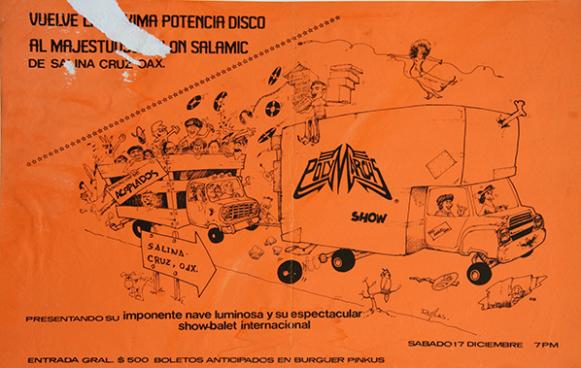
In the margin within – those more notorious neighborhoods of the Distrito Federal – embroidered logo jackets circulate, lending publicity to the sonidos along with their cards, posters, flyers, banners. Nonetheless, fewer and fewer dance parties are thrown. The city government has issued a discretionary ban of sonidero events in public spaces, canceling even traditional dances like the anniversary celebrations of Tepito’s markets. In the outer margins, ringing the DF and beyond, painted walls announce upcoming events and sonido trailers take over the streets. The dances go on.
We aren’t as familiar with the electronic scene, headed by Polymarchs. Our inroad is through the graphic materials comprising the collection Panther has amassed since 1979, which he rightly considers his primary asset. It all began in the Zona Rosa, where he used to go to trade posters, leaflets, stickers. At thirteen he formed part of the Polymarchs crew, coiling cables. Later he became a publicist, promoter, producer. He never stopped his gathering; stacks of paper tower in the office. Hundreds of posters and dozens of original drawings from the golden age of Hi-NRG pass in front of the camera, as José Luis remembers key scenes and events from this world: when they brought Gloria Gaynor to Mexico for the first time, when Sylvester came, when they packed the World Trade Center.
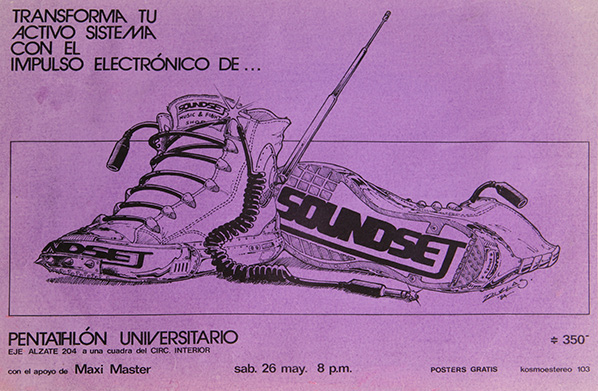
We are introduced to the world of artists and designers who created an imaginary to suit the precursors of the genre: pharaonic, galactic, utopian, spectacular, and futuristic. Always epic. Tailored to the moment, to the experience of the fans. The posters of the electronic sonidero movement are unique in format, employing unexpected techniques and materials; they are distinct, painstaking, sensational, new. In contrast, the works of tropical sonidos follow in the typographic vein of Mexico’s Gráfica Popular – reminiscent of the wrestling, taking the freedoms of the tropics, whether with box cutter or in full pixel. In the world of disco, Hi-NRG, and techno, the graphics are like the sound system: cult objects, concepts, myth.
“Do you want to meet Jaime Ruelas?” asks José Luis. The master of ink drawing, creator of logos and illustrations as iconic as La Changa or Polymarchs themselves. Of course we do. We are his fans, and we are an army. We arrive nearly punctually to the interview, with photography, audio and video gear in tow. Nearly punctually, because Jaime is already waiting; the son of a watchmaker, he knows machines, design and sound from the inside. He also knows the history of Polymarchs well, and from the beginning. Polymarchs’s first gig took place in his apartment in Tlatelolco. Later, Jaime became the sonido’s first DJ, before switching his focus to images.
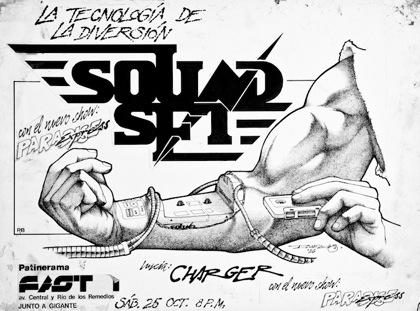
Like the sonidos thriving now in the capital, Polymarchs began in Puerto Ángel, on the Oaxaca coast, with a modest set-up – just a single Telefunken console and two baffles. The collective was formed by three siblings in 1975: Apolinar, Elisa and María de los Ángeles Silva Barrera. In 1978 they moved to Mexico City. Apolinar took charge of the sonido, and with Jaime Ruelas he discovered disco and Hi-NRG. The tenacity of Polymarches transcends mere selection of musical genres; the approach here is different. With tropical sonidos, the music, the equipment, the role of DJ and MC are the purview of one person, a single all-powerful figure operating from behind the console. Polymarchs is coming from somewhere else, assembling great towers of scaffolding, creating a spectacle, an experience, an environment. Neither DJ or MC, this is an entire machine. Polymarchs designs, produces and operates structures of light and sound as have never been seen before, radiant vessels that travel, carrying immense tech crews and companies of retro-futuristic dancers, from Tenochtitlan to outer space. There are explosions in the cosmos. On the floor all hands are up, cellphones by the thousands.
When Apolinar Silva and the Polymarchs team arrive at the Centro Cultural de España to give a conference in the context of the Proyecto de Gráfica Sonidera, the auditorium is brimming. Followers sport the distinctive t-shirts and jackets, hold up posters they’ve collected, wave cellphones. Apolinar is glowing; he is the supreme authority and, more than mythic, he is mystic. The audience takes the microphone to share their experiences. Like the time a Polymarchs event was organized in Mexico City’s Zócalo and what people thought was an earthquake turned out to be the earth shuddering under such dance. Below, in one of the exhibition spaces, Polymarchs set up a kind of black-light temple, aglow with, among many others, the visions we now share now with you.
The Proyecto de Gráfica Sonidera was an intensive program that resulted in records and research, specialized workshops and others for children, the painting of walls, the exhibition of graphic, photographic, and video material, and a series of talks along with book and documentary releases. We had the honor of including a drawing by Jaime Ruelas, and we kicked off with a dance party dedicated to Polymarchs… which was epic. There was a little boy who stole the dance floor, winning it against the odds from the more seasoned dancers.
All this was made possible thanks to many people and institutions. Shout-outs to the following generous collaborators: Marco Ramírez, José Luis Lugo, Javier Echavarría, Jaime Ruelas, Livia Radwanski, Mark Powell, Mirjam Wirz, Rocío Montoya, Tonatiuh Cabello, Diego Delgado, Alan Lazalde, Sonido Fajardo, Luis Sánchez, Héctor Rubí, Julio Díaz Corona, Sonido Leo, Christian Cañibe, Eduardo “Aníbal” Dueñas, Eleazar “Canuto” Escobar and the shop personnel of Publicidades Panther, Publicidades Lupano, Aisel Wicab, Citlali López Maldonado, Pedro Sánchez, Marisol Mendoza, Lupita La Cigarrita, Sonido Pío, Víctor Hernández, Edgar Ramírez, Laura Zárate, Griska Ramos, Mirna Roldán. Official respects to FONCA, to CONACULTA, to the Fundación Alumnos 47 and to the Centro Cultural de España.
Exhibition Tour and Artists Talk (Magnus Eriksson and Geraldine Juárez)
Saturday 03 May 2014, 2pm
Exhibition tour led by Magnus Eriksson and Geraldine Juárez followed by a live walk-through of the Piratbyrån archive and talk about some overlooked gems from their history at Furtherfield Commons. Expect to learn some Swedish while we are at it!
SEE IMAGES FROM THE PRIVATE VIEW
Contact: info@furtherfield.org
Curated by Rachel Falconer & Furtherfield
EXHIBITION TRAILER – Piracy as Friendship
@Furtherfield “Don’t contact future. Future will contact you!”
“For the last sixty years, capitalism has been running a pretty tight ship in the West. But in increasing numbers, pirates are hacking into the hull and the holes are starting to appear. Privately owned property, ideas, and privileges are leaking into the public domain beyond anyone’s control.” – Matt Mason, The Pirate’s Dilemma
Piratbyrån and Friends traces the stories of cultural sharing and affinity-building among the activities and values of the members of Piratbyrån (The Bureau of Piracy). This Swedish artist/activist group was established in 2003 to promote the free sharing of information, culture and intellectual property. The exhibition presents screenings, installations and artworks by founding and more recent members, keen to tell the story of the group on their own terms. It features newly commissioned work by artists Geraldine Juarez and Evan Roth, and a new networked audio collaboration which mediates their rich archive and foregrounds the role of piracy as an agent of innovative disruption and cultural transmission.

“The specific character of friendship as a form of social relationship is that it does not presume a permanent interaction. Friendships are a type of serial solidarity. The story of friendship is a story of meetings.” Viktor Misiano – The Institutionalization of Friendship.
Piratbyrån have always resisted clear definition. Created on the Internet as a loose friendship group with a shared commitment to media and piracy in the shifting ecologies of digital copyright law, Piratbyrån operated through a number of different identities. From the #discobeddienti IRC chatroom, to the infamous Pirate Bay, to the determinedly analogue SX23 bus trip to Manifesta 7, and their subsequent disbandment in 2010, Piratbyrån consciously cultivated an air of mystery and intrigue around their many activities.
Piratbyrån have always had a particular commitment to the value of friendship as a shelter for culture and a space to understand, imagine and experiment as a community from the edges of the Internet.

The exhibition features newly commissioned sculptures and installations by artists James Cauty, Geraldine Juárez and Evan Roth and a screening programme that includes Steal This Film by Jamie King and Piratbyrån and Friends by Geraldine Juarez.
Tapecasts (2013-2014) – Piratbyrån and Friends
SK23 Suit (2008) – Lina Persdotter Carlsson / Piratbyrån
S23m Manifesta Bus Trip (2008) – Piratbyrån & Simon Klose
S23x Belgrade Bus trip (2008) – Piratbyrån
Polymarchs posters (1980-1990) – Jaime Ruelas
Sharing is Caring Map (2008) – Sara Wolfert / Mathias Tervo / Piratbyrån
Kopimi Totem (2014) – Evan Roth
Torrent Tent (2014) – Geraldine Juárez
Riot Chat (2014) – Palle Thorsson
Smiley Riot Shield 2 (Second Edition) and PB2 (2014) – James Cauty
Piratbyrån (The Bureau for Piracy) was started by a bunch of hacking, coding, reading, listening, philosophising, clubbing, rioting, carding, chatting, loving, slacking people in 2003 as an antidote to Hollywood’s representatives in Sweden – Antipiratbyrån.
In 2007 – after having kickstarted the Swedish debate over file-sharing, which by the time had become a major issue in the previous years national election and after having created The Pirate Bay as a side-project that became the world largest file-sharing system – the people from Piratbyrån had grown tired of the file-sharing debate and its endless repetitions of for-or-against, legal-or-illegal, payment-or-gratis. At the last day of April in a Walpurgis fire on the top of the highest mountain in Stockholm the masked members burned the remaining copies of a book on file-sharing they had published some years earlier and declared the debate dead. The video documentation of this ritual, set to the soundtrack of KLF’s “What Time is Love”, found its way to the Indian Raqs Media Collective group who was just about to curate the next Manifesta biennial in Bolzano, Italy.
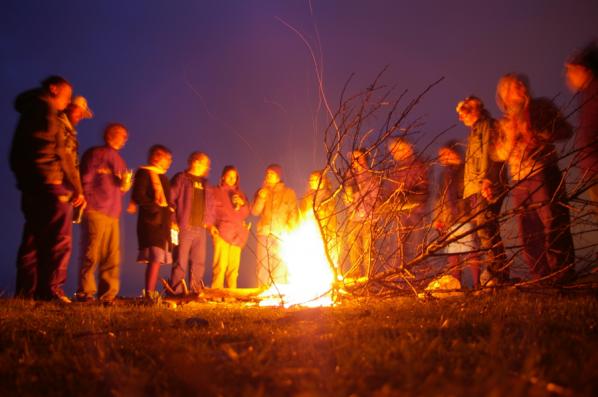
The loose network of Piratbyrån, now loaded with 7000 Euros of art budget and a sizable amount of cash from selling Pirate Bay t-shirts, decided to purchase, renovate and decorate a 1970s city bus, stack it with 23 people, and head down south.

The ongoing relation with the bus – named S23m/x/k respectively for each trip – would later make an exodus from the exhibition in Italy to head across Eastern Europe and end up at the trial against Pirate Bay. It became one of the most significant undertakings of Piratbyrån and shaped their thoughts on the tensions between digital abundance and crowded space, collective decisions and freedom of choice, and that which can be copied and that which can’t. The bus became a line of flight from the collective subject that had been built, a subject which was very associated with The Pirate Bay and also with Swedish politics, including the Pirate Party.
While nothing was really the same after the bus had returned, Piratbyrån formally lasted until 2009, when the tragic death of one of the founding members – Ibi Kopimi Botani – defined the end of an era. The Internet had already transitioned to another phase and it is not until now, and enough time has passed, that we as a culture are ready to reflect on what exactly happened during those years.
Piratbyrån always had an implicit friendship with the KLF. They share the same historical web of connections and share a similar trajectory, but their activities are shifted in time by roughly a decade. The only contact between the two is a response from Bill Drummond when Piratbyrån sent a link to the documentation of the Walpurgis ritual. It read:
> Thank you for your email.
> I have just read the text at the link.
> I enjoyed it and understood it.
It is probably good that they didn’t exist at the same time because the gap in time gives the relation an infinite unresolvable tension of unfulfilled connectivity and unlimited possibilities.
James Cauty
For Piratbyrån, James Cauty’s personal work resonates with the themes of abundance and rarity, presence and absence, functionality and waste, control and chaos, and draws on the same symbolic language that mixes clarity with suggestion. There is also a similar urge to *stir things up* and *stick ones nose where it doesn’t belong*.
Evan Roth
Speaking of stirring things up, FATLAB was for Piratbyrån another one of those instantly recognisable friends that had never met; the art group that Piratbyrån never became, the “the unsolicited viral marketing wing of the open-source movement”, the graffiti crew of the World Wide Web. FATLAB was born when the file-sharing debate was buried and the new web 2.0 era transformed the web.
Evan Roth, co-founder of FATLAB, has made a piece for the exhibition that in a subtle but direct way captures the concept of KOPIMI; how meetings and connections leave traces and makes you a carrier of ideas and information, sometimes without you even recognising it.
Jaime Ruelas & Polymarchs
The soundsystem collective Polymarchs and their illustrator Jaime Ruelas, probably happily unaware of the existence of Piratbyrån, embodies a scene in Mexico where piracy has always been a way of life and a mode of existence. They have materialised, expressed and lived what was only hinted at in glowing screens up in Sweden. Having outlasted all of the above mentioned collectives and managed to stick together for decades, they also highlight both the potential strength and – as a contrast – the fragility of so called “confidential projects”; those moments when friendships turn into expressive units and the borders between the intimate and the public are blurred.
Geraldine Juárez
Last but not least, Geraldine Juárez is the reason this exhibition came together at all. She began to read the Swedish-language blogs of Piratbyrån members through Google translate – whose mistranslations made them sound like they came from the near future instead of the near past, until she finally came into contact with Piratbyrån by translating updates from the trial – or Spectrial, as it was known – into Spanish. Now she returns the favor of time-travelling by re-awakening Piratbyrån one last time, to allow their archive to again live up, their ideas to be carried over to others and perhaps even some sense made from what happened, although these things can only be interpreted, misunderstood and re-appropriated – never explained.
Inside the tent that she has crafted for the exhibition – a torrent for piracy as the last shelter of culture – there will be a collection of tapes prepared and circulated by Piratbyrån and friends, perhaps giving some seed for thoughts and guidance in the process of excavating the archive of Piratbyrån.
About co-curator Rachel Falconer
Rachel Falconer is a curator, writer and producer working at the intersections of technology, the media and contemporary art. She currently holds the position of Head of Art and Technology at SPACE and runs the art and technology programme at The White Building and SPACE MediaLab. She is Co-Editor at Furtherfield and a founding member of the collective Hardcore Software.
Her curatorial practice is hybrid and interdisciplinary in approach and her current activity and research focuses on the pathologies surrounding social spaces and human behaviours engaged with networks and new technologies.
Furtherfield Gallery
McKenzie Pavilion, Finsbury Park
London N4 2NQ
T: +44 (0)20 8802 2827
E: info@furtherfield.org
Furtherfield Gallery is supported by Haringey Council and Arts Council England
The end of boom and bust ended with the credit crunch. Following the global financial crisis of 2008, the Eurozone crisis has produced technocracy and poverty rather than democracy and wealth. Reactions to these failures of monetary policy are informed by technology as never before, from austerity being imposed thanks to an Excel spreadsheet bug to the rise of the anti-statist cryptographic currency of Bitcoin.
Against this backdrop of monetary failure and technological critique, _MON3Y AS AN 3RRROR | MON3Y.US is an ambitious online survey of net art depictions and critiques of money and its institutions curated by the pseudonymous curator “Vasily Zaitsev”. As well as the work from 70 or so artists invited to participate an open call for work increased the number of pieces in the show in total to around 200. I only consider the invited artists here, but the work in the open call section is well worth looking at as well.
The show web site has a simple HTML interface, starting with a single image and a pull-down menu of other works. Disable your pop-up blocker and you’re ready to start.
Miron Tee’s “Shame” is the image that fronts the show, an image of a dollar modified to show George Washington peering out nervously from behind the oval frame in the center.
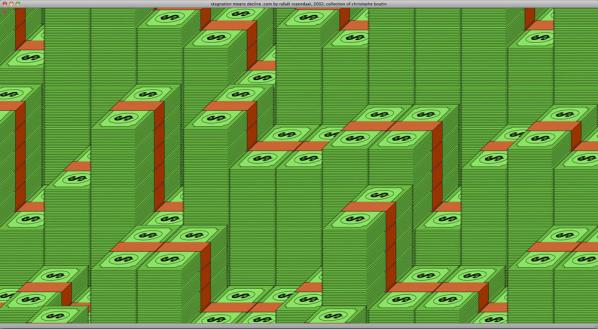
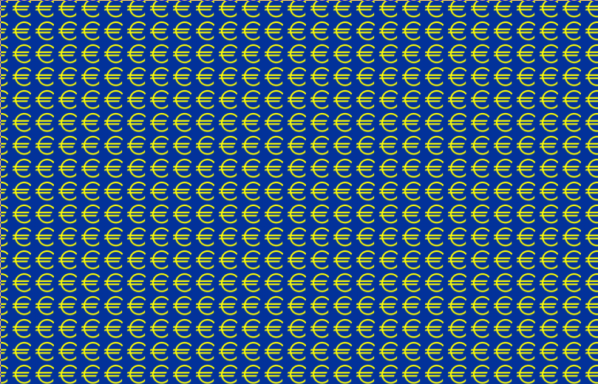
Dominik Podsiadly’s “Joy to ide” starts the pull-down menu with a flowing grid of Euro signs on a blue background to the sound of “Ode To Joy” playing backwards. It’s an all-over, closed temporal loop of the kind that animated GIFs exemplify and encourage, the Euro falling forever.
Nuria Güell’s “How to expropriate money from the banks” is a more direct action based work of culture jamming explaining presented in a well laid out document in the style of HSBC’s First Direct brand.
Paolo Cirio’s “Loophole for All” makes offshore tax havens, those loopholes in taxation regimes that allow corporations and the super-rich to avoid repaying society, available to everyone through a web site interface.
Rafaël Rozendaal’s “Stagnation Means Decline” is a screenful of geometric pixel-art dollar bill stacks that fill the screen with their edges only to be obscured by new columns like an economic game of Life.
Filipe Matos’s “Crash” is an undulating animated monochrome concrete poetry American flag with the stars made from the letters of “me” and the stripes as “you”.
Adam Ferriss’s “paper$hredder” is a Vimeo video clip of American dollar bills speeding by faster and faster until they dissolve into a blur.
Aaron Koblin + Takashi Kawashima’s “Ten Thousand Cents” is a composite image of a hundred dollar bill crowdsourced by paying people a cent to paint each piece through Amazon’s Mechanical Turk service.
Maximilian Roganov’s “When the Mao was small, he worked for CIA” is a looped animated GIF colour 3D scan of a dollar bill, polygonally glitched or possibly crumpled over time.
Dave Greber’s “Self Portrait With Dog” video is aptly titled, apparently taking place as the custom graphic on a Visa Mastercard.
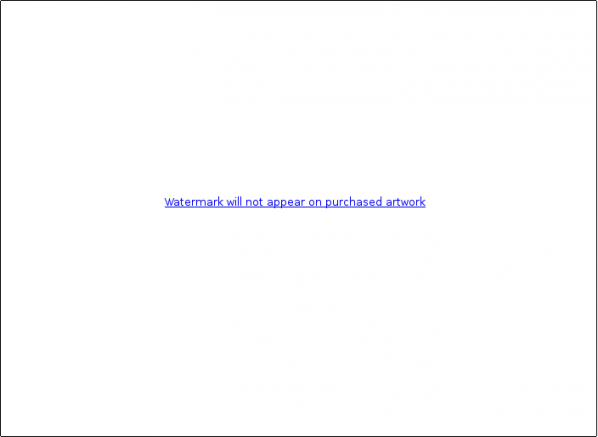
Agente Doble | UAFC’s “Watermark will not appear on purchased artwork” is a million dollar blank artwork if you email them and purchase it, otherwise it’s just a url on a blank web page.
JUST DO IT’s “Fifty Euros Inside/Fifty Euros Outside” are animated GIF loops of fifty Euro notes pulsating as if to sound waves on an oscilloscope.
Mitch Posada’s “$$$” is a Flash video of Silicon Graphics-era-style VR models of skeletons exploding and morphing into their constituent polygons while texture mapped with Deutschmarks.
Emilio Vavarella’s “Money Complex” is a tube map-style world map with banknote-collage continents and a key for numeric labels that can be zoomed in on by moving the mouse to reveal their often incongruous labels. It’s one of the more complex works in the show art historically and conceptually.
Lorna Mills & Yoshi Sodeoka’s “Money2” is a Vimeo video loop collage of roughly extracted elements from videos of commodity fetishism, fire and death.
Fabien Zocco’s “Cloud” is a generative composition of black dollar signs scattered up over a yellow background over time like a plume of smoke.
Jasper Elings’s “Territory” is an animated GIF loop of a dollar bill flag blowing in the roughly simulated wind on a white background. It’s not the only such piece in the show.
Robert B. Lisek’s “FuckinGooglExperiment” is online statistical analysis code that tries to correlate the change in Google’s stock price with changes in their PR strategy. It also uses the excellent Fluxus livecoding environment.
Alfredo Salazar Caro | TMVRTX’s “How to make money on internet remix” is a tightly tiled video loop of a rotating stack of dollar bills in a lava-lite-like flow of colour psychedelia.
Anthony Antonellis’s “How to make money on the internet” is simply that rendered block of spinning virtual hundred dollar bills, plucked from the era of RenderWare and VRML.
Gustavo Romano’s “Pieza Privada #1” is another piece of net art for sale at a specific price, with a carefully described contract and application form.
Tom Galle’s “One Million Dollars For iPhone” is an app available on the iTunes Store that allows you to count a virtual million dollar wad on your iPhone.
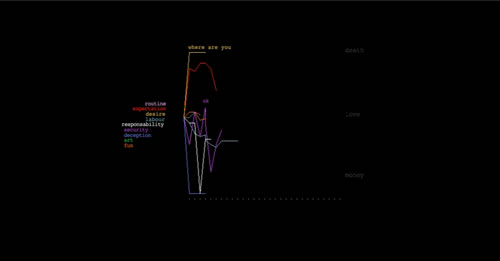
Geraldine Juarez’s “Love Not Money” tracks the associations of various words with “death”, “love” and “money”. I had to Google this one: it’s a Processing visualisation of a personal stock market tracking the artist’s conceptual assets over six weeks. I love it.
Nick Kegeyan’s “C.R.E.A.M. (Cash Romney Eat A Lot of Money)” is simple, direct and effective video burst of an American news interview subject morphing into a cloud of falling texture mapped dollar bills.
Dafna Ganani’s “Apple Dollar Explosion” is another descriptively titled piece, a Maya-looking apple texture mapped with a dollar bill spinning against a grey background then exploding into its constituent polygons.
Haydi Roket’s “$” takes a dollar bill portrait and literally deconstructs it by pixelating it in increasingly primitive ways, first as 4-bit grey patterns, then in monochrome ANSI characters, alternating to inverse video and changing the contrast to give a flickering effect.
Jennifer Chan’s “Infinite Debt” is a video of a twenty Euro not being dipped in batter and fried mixed in with a collage of clipart images and video on the cynical economics of contemporary art and consumerism.
Frère Reinert’s “Money as a waste of time” is a deliberate excercise in futility; a blurred, zoomed in silent video of the MacOS X SBOD on a white backdrop.
Cesar Escudero’s “Captura de pantalla 2013-03-08 a las 21.46.23” is a Mac OS X desktop image of a gas masked protester who appears to be reaching for a folder named “$$$$$$$”.
Jefta Hoekendijk’s “Money Is Data” is an animated GIF loop of a glitchily texture mapped virtual fifty Euro note in artificial colours.
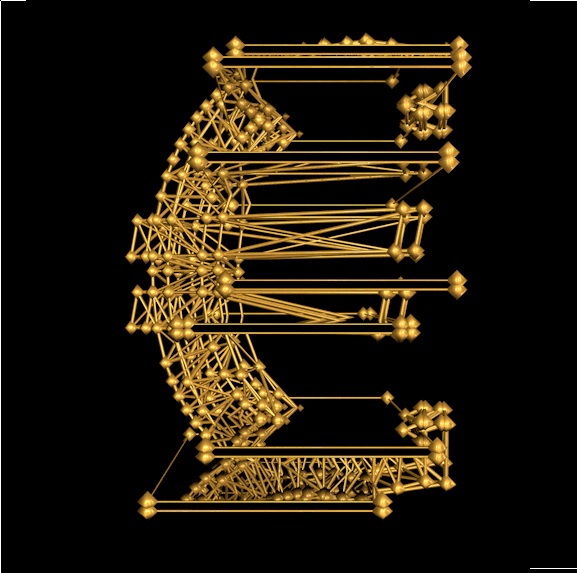
V5MT’s “¥€$ or N0T” is a rap video or Designers republic album cover-style animation of monumental metal morphing currency symbols made from struts and spheres like newton’s cradles or molecular diagrams.
Addie Wagenknecht’s “How To Make $$$$$” is a grid of money counterfeiting video tutorials, which are apparently a genre. Playing all at the same time they become an all-over aesthetic rather than incitement to a crime.
Gusti Fink’s “infinite loop of money drowning in water oil” is a slow, monumental simulation of a platinum visa card sliding into dark liquid that the camera pans over as if it were a sinking ship.
Marco Cadioli’s “You are here” shows globe and landscape maps constructed of dollar bills, with a pin or map icon to show your place in the economy.
Keigo Hara’s “Making Of Fake Bills” is more halftoned (or possibly shape grammared) dollar bills.
Jan Robert Leegte’s “Currency Graph” shows European flag yellow bars over a European flag blue gradient background. It’s a mutated and abstracted evocation of news information graphics aesthetics in CSS and JavaScript.
Ellectra Radikal’s “Disolved €uro” is a flickering autotraced, find edged and glitched animated zoom into a hundred Euro note that renders it spatial and architectural.
Paul Hertz’s “5,000,000$” it the purest glitch art piece in the show, rows of corrupted and miscoloured banknote imagery that looks like nothing so much as classic street art.
Aoto Oouchi’s “It’s all good” is an uncanny New Aesthetic 3d rendering of liquid or possibly mirrored texture mapped banknotes pouring from a wall.
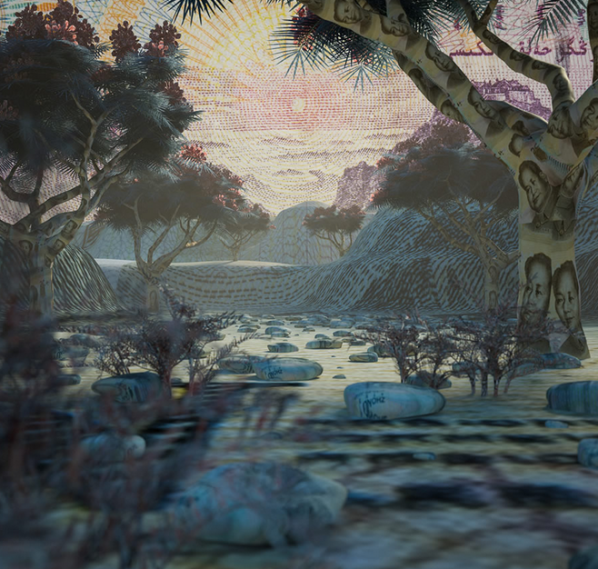
Kim Laughton’s “Landscape” is a rendered and collaged landscape of banknotes, resembling nineteenth century engravings of dramatic landscapes thanks to the inconography and texture of its source material.
Andrey Keske’s “Tell Me What You Want” is a search engine-style text box prompt that shows the economic coercion inherent in neoliberal use of technology by only allowing you to finish one word beginning with “M”.
A Bill Miller’s “3xpl0d3m0n3y” combines a grainy analogue glitch aesthetic explosion of a dollar bill into waveform stripes into a black space of drifting Matrix-green dollar signs.
Martin Kohout’s “Watching $100 Note Unveiling Video” has a ChatRoulette look, with the unseen unveiling causing a small smile to break out on the depicted viewer’s otherwise affectless face.
Marc Stumpel’s “pH0r 7|-|3 L0\/3 0Ph /\/\0|\|3’/” is a glitched and colourised monochrome television popular music performance from the age of mass media. Again I had to Google it but the song is ‘For the love of money’ by The O’Jays.
Benjamin Berg’s “$(0x24)” (the hexadecimal number that represents the dollar sign in ASCII) is a colourful and stripy glitch animation that resembles test cards, 8 and 16 bit graphics, and even woodcut as it breaks down.
LaTurbo Avedon’s “$$$$$$$$$$$$$$$$$$$$$” is an ambient modern html5 animtion of the avatar-artist reclining on money texture-mapped couches floating up and down a Google image search page for the word “millions”.
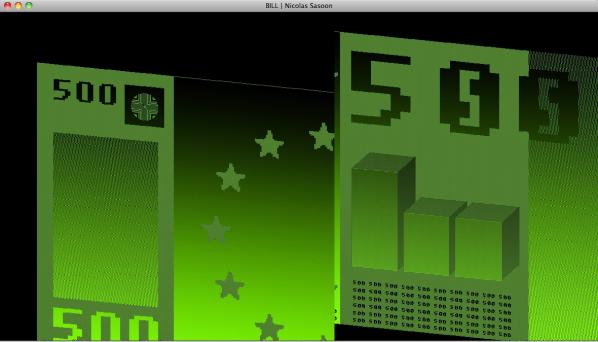
Nicolas Sassoon’s “BILL” is a flickering green screen terminal or slow scan TV-style rendering of a 500 Euro note that plays with the visual language of digital images: the letters and stars are highly pixellated but the backdrop to them is a smooth gradient.
Curt Cloninger’s “i want KANDY” loops images of a dancing sniper camouflaged figure montaged with dollar bills and fruit over a more slowly changing background collage of the american flag, a dollar bill, and fruit making a post MTV-styleguide image of the military-economic-entertainment complex.
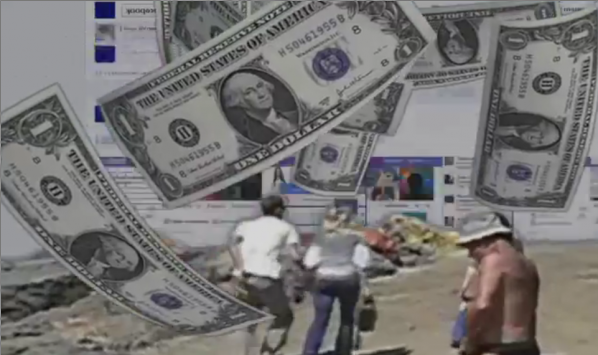
Systaime’s “ʞooqǝɔɐɟ Dollars” video portrays a world where curvily rendered dollar bills rain over an amateur video of tourists at a beach with a sky of quickly cycling Facebook pages.
Erica Lapadat-Janzen’s “Money Troubles” is a PhotoShop Pop Dada montage of exploitatively normative female beauty and monetary and drug excess that subverts the imagery of the fashion pages.
Milos Rajkovic’s “Mind Wheel” is a wonderfully Gilliamesque collaged animation depicting a mental wage labourer.
Émilie Brout & Maxime Marion’s “Cutting Grass” depicts the pointless and trivial labour that video games such as “The Legend Of Zelda force players to engage in for unrealistic rewards such as gold coins and rubies so they can get on with their quest.
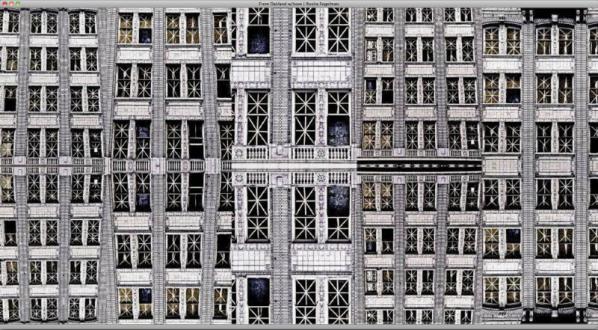
Rozita Fogelman’s “From Oakland w/Love” is a point-and-click kaleidoscopic archtitectural portrait of gentrified Bay Area architecture.
Georges Jacotey’s “am I enough political now” is a Chatroulettish video selfie of an augmented reality Euro flag and symbol drawing and dancing session.
Δεριζαματζορ Προμπλεμ Ιναυστραλια’s “Major Problem” is a rendering of a stack of dollar bills as seen through heat haze or under water, rippling and undulating against a white background.
Lars Hulst’s “0 €uro” is a rendering of a zero Euro note.
Nick Briz’s “a return to secularism” is a video documentary of twenty dollar bills being printed with the words “a return to secularism” flashing over it, framed by a repeated loop of the words “in God we trust” being crossed out on a dollar bill where they were added in the 1950s.
Jon Cates’s “MØN3¥-Δ$-3ɌɌɌØɌ” is a Classic Mac monochrome bitmap or fax aesthetic PDF essay for the show and an exposure of the print on demand economics of that essay in the same style.
León David Cobo’s “Conversation With Machine” has a 1990s broadcast graphic feel, showing the soundwaves of the feedback of a conversation with Siri asking it for money in Euro blue and yellow.
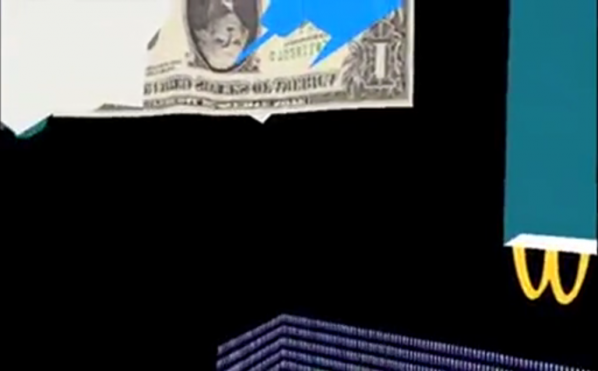
Guayayo Coco’s “Money | GLıɫcʜ ᴬᴺᴰ GLıɫɫɛʀ” is a video of a journey through a VRML-style virtual environment of discrete polygonal objects texture mapped with dollar bills, corporate logos and more abstract patterns with a radio channel-surfing soundtrack.
Vince Mckelvie’s “MONEY” is a reactive interactive deconstruction of a hundred dollar bill into a grid that reacts to the viewers’ mouse movement, revealing pulsating colours behind. It’s a good example of how suitable html5 is for this kind of thing.
Ciro Múseres’s “YOU HAVE WON” is a classic net.art style HTML bomb of overlaid text and links with content from financial web sites such as Barclays, Halifax and Santander that continuously adds and removes layers in different shades red, black, blue and green text to make new compositions.
Adam Braffman’s “Money Loading” is an animated GIF of the frame of a 100 dollar bill with a “Loading…” speech bubble in the centre. It makes the show’s themes of absent and delayed wealth more obviously explicit.
Rollin Leonard’s “Portrait of a NetArtist” is an two-frame animated GIF of the artist naked in the bath with bundles of fake hundred dollar bills with which they are lighting their cigar.
Thomas Cheneseau’s “100€ sequence” is a grid of glitched sections of a hundred Euro note that moires with colour as you scroll it. There’s a link to the facebook album that constitutes the actual work, and it works much better as a clickable album than as a static single image.
Yemima Fink’s “This is not money” is an abstract postmodernist collage of graphical quotations from the counterfeit-resisting elements of banknotes that is both witty and a very effective defamiliarisation of the iconography of banknotes and the power that they represent.
Mathieu St-Pierre’s “Untitiled” is a glitched jpeg of a dollar bill that in its straightforward application of glitch aesthetics makes the most direct link between them and the economic “glitch” of 2008.

Kamilia Kard’s “Amazon VIP girls” is the lone tumblr in the show, with an aesthetic that is either post-internet or pre-Google depending on how old you are applied to the supposedly perfect clothing models used by web sites.
José Irion Neto’s “Untitled” is a glitched banknote that turns JPEG artefacts into Klimt patterns.
There are definite historical trends and formal themes within the included work. Polygonal, texture-mapped, 90s-style VR-style objects that spin or explode. Net art and functional web sites that track or create financial and legal entities and transactions. Looped animations of textures, rendered flags, or video detournements. The imagery of accumulation, consumption, and destruction, always ironically. Imagery and symbols presented in simple loops fast or slow for contemplation. Graphs and maps of real and imagined economic signifiers.
In terms of genre, _MON3Y AS AN 3RRROR | MON3Y.US includes classic VR and video art, more modern GIF loops, textual and institutional net.art, glitch art, even some New Aesthetic. The language of computer graphics, texture mapping and polygons, allows the imagery of banknotes to be defamiliarised and deconstructed. Less often, personal experience and iconography displace the cultural imagery of wealth, consumption and debt.
This historical, formal and genre coverage of the variety of artworks included in the show comprehensively illustrates the chosen theme of “money and error”. This creates its own genre and lineage for the included artworks, which gain by comparison to their newly identified peers. They also contribute to the social and economic critique of the show. It’s a very successful balancing act, which the simple interface and presentational strategy of the show’s curation are key to achieving.
_MON3Y AS AN 3RRROR | MON3Y.US is an almost overwhelmingly successful in its comprehensive review of net art’s critical depiction of and engagement with money. By taking a technologically simple but historically, conceptually and logistically ambitious approach to net.curation for net.art it demonstrates the effectiveness and lasting value of net art’s contributions in this area and the power of online thematic curation to draw together and contextualise this value without giving in to the often perceived need for offline institutional underwriting.
For over 17 years, Furtherfield has been working in practices that bridge arts, technology, and social change. Over these years, we have been involved in many great projects and collaborated with and supported various talented people. Our artistic endeavours include net art, media art, hacking, art activism, hacktivism and co-curating. We have always believed it is essential that the individuals at the heart of Furtherfield practice in arts and technology and are engaged in critical enquiry. For us, art is not just about running a gallery or critiquing art for art’s sake. The meaning of art is in perpetual flux, and we examine its changing relationship with the human condition. Furtherfield’s role and direction as an arts collective is shaped by the affinities we identify among diverse independent thinkers, individuals and groups who have questions to ask in their work about the culture.
Here I present a selection of Furtherfield projects and exhibitions featured in the public gallery space we have run in Finsbury Park in North London for the last two years. I set out some landmarks on the journey we have experienced with others and end my presentation with news of another recently opened space (also in the park) called the Furtherfield Commons.
Running themes in this presentation include how Furtherfield has lived through and actively challenged the disruptions of neoliberalism. The original title for this presentation was ‘Artistic Survival in the 21st Century in the Age of Neoliberalism’. The intention was to stress the importance of active and open discussion about the contemporary context with others. The spectre of neoliberalism has paralleled Furtherfield’s existence, affecting the social conditions, ideas and intentions that shape the context of our work: collaborators, community and audience. Its effects act directly upon ourselves as individuals and around us: economically, culturally, politically, locally, nationally and globally. Neoliberalism’s panoptic encroachment on everyday life has informed Furtherfield’s motives and strategies.
In contrast with most galleries and institutions that engage with art, we have stayed alert to its influence as part of a shared dialogue. The patriarch, neoliberalism, de-regulated market systems, corporate corruption and bad government; each implement the circumstances where we, everyday people, are only useful as material to be colonized. This makes us all indigenous peoples struggle under the might of the wealthy few. Hacking around and through this impasse is essential if we maintain human integrity and control over our social contexts and ultimately survive as a species.
“The insights of American anarchist ecologist Murray Bookchin into environmental crisis hinge on a social conception of ecology that problematises the role of domination in culture. His ideas become increasingly relevant to those working with digital technologies in the post-industrial information age, as big business develops new tools and techniques to exploit our sociality across high-speed networks (digital and physical). According to Bookchin, our fragile ecological state is bound up with a social pathology. Hierarchical systems and class relationships so thoroughly permeate contemporary human society that the idea of dominating the environment (to extract natural resources or to minimise disruption to our daily schedules of work and leisure) seems perfectly natural despite the catastrophic consequences for future life on earth (Bookchin 1991). Strategies for economic, technical and social innovation that focus on establishing ever more efficient and productive systems of control and growth, deployed by fewer, more centralised agents, have been shown to be both unjust and environmentally unsustainable (Jackson 2009). Humanity needs new social and material renewal strategies to develop more diverse and lively ecologies of ideas, occupations and values.” [1] (Catlow 2012)
It is no longer critical, innovative, experimental, avant-garde, visionary, evolutionary, or imaginative to ignore these large issues of the day. Suppose we, as an arts organization, shy away from what other people are experiencing in their daily lives and do not examine, represent and respect their stories. In that case, we rightly should be considered part of an irrelevant elite and seen as saying nothing to most people. Thankfully, many artists and thinkers take on these human themes in their work in various ways, on the Internet and in physical spaces. So much so, this has introduced a dilemma for the mainstream art world regarding its relevance and whether it is contemporary.
Furtherfield has experienced, in recent years, a large-scale shift of direction in art across the board. And this shift has been ignored (until recently) by mainstream art culture within its official frameworks. However, we need not only to thank the artists, critical thinkers, hackers and independent groups like ours for making these cultural changes, although all have played a big role. It is also due to an audience hungry for art that reflects and incorporates their social contexts, questions, dialogues, thoughts and experiences. This presentation provides evidence of this change in art culture, and its insights flow from the fact that we have been part of its materialization. This is grounded knowledge based on real experience. Whether it is a singular movement or multifarious is not necessarily important. But, what is important is that these artistic and cultural shifts are bigger than mainstream art culture’s controlling power systems. This is only the beginning, and it will not go away. It is an extraordinary swing of consciousness in art practice forging other ways of seeing, being, thinking, making and becoming.
Furtherfield is proud to have stuck with this experimental and visionary culture of diversity and multiplicity. We have learned much by tuning into this wild, independent and continuously transformative world. On top of this, new tendencies are coming to the fore, such as re-evaluations and ideas examining a critical subjectivity that echo what Donna Haraway proposed as ‘Situated Knowledge’ and what the Vienna-based art’s collective Monochrom call ‘Context Hacking’. Like the DADA and the Situationist artists did in their time, many artists today are re-examining current states of agency beyond the usually well-promoted, proprietorial art brands, controlling hegemonies and dominating mainstream art systems.
Most Art Says Nothing To Most People.
“The more our physical and online experiences and spaces are occupied by the state and corporations rather than people’s own rooted needs, the more we become tied up in situations that reflect officially prescribed contexts, and not our own.” [2]
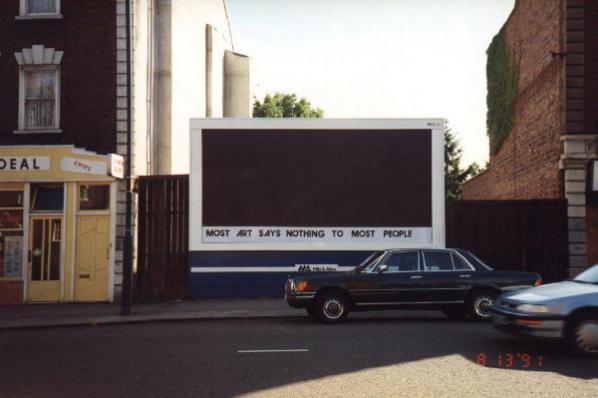
To start things off, I want to refer to a past work that Heath Bunting (co-founder of irational.org) and I were involved with in 1991. The above image is a large paste-up displayed on billboards around Bristol in the UK. At the time, as well as being part of other street art projects, pirate radio and BBS boards, Heath and I and others were members of the art activist collective Advertising Art. The street art we made critiqued presumed ownership of art culture by the dominating elites. The words “Most Art Says Nothing To Most People” have remained an inner mantra ever since.
Furtherfield is inspired by ideas that reach for a grassroots form of enlightenment and nurture progressive ideas and practices of social and cultural emancipation. The Oxford English Dictionary describes Emancipation as “the fact or process of being set free from legal, social, or political restrictions; liberation: the social and political emancipation of women and the freeing of someone from slavery.”
“Kant thought that Enlightenment only becomes possible when we are able to reason and to communicate outside of the confines of private institutions, including the state.” [3] (Hind 2010)

Well, a start would be getting organised and building something valuable with others.
As usual, it is up to those people who know that something is not working and those feeling the brunt of the issues affecting them who end up trying to change the conditions. It is unlikely that this pattern of behaviour will change.
To expect or even wish those who rule and those serving them to change, challenge their behaviours and seriously critique their actions is as likely as winning the National Lottery, perhaps even less.
Art critic Julian Stallabrass proposes that there needs to be an analysis of the operation of the art world and its relation to neoliberalism. [4]

In the above publication, Gregory Sholette argues “that imagination and creativity in the art world thrives in the non-commercial sector, shut off from prestigious galleries and champagne receptions. This broader creative culture feeds the mainstream with new forms and styles that can be commodified and utilized to sustain the few elite artists admitted into the elite. […] Art is big business: a few artists command huge sums of money, and the vast majority are ignored, yet these marginalized artists remain essential to the mainstream cultural economy serving as its missing creative mass. At the same time, a rising sense of oppositional agency is developing within these invisible folds of cultural productivity. Selectively surveying structures of visibility and invisibility, resentment and resistance […] when the excluded are made visible when they demand visibility, it is always ultimately a matter of politics and rethinking history.” [5] (Sholette 2013)
Drawing upon Sholette’s inspirational, unambiguous and comprehensive critique of mainstream art culture in the US. I want to consider examples closer to home blocking artistic and social emancipation avenues that also need an urgent critique. And this blockage resides within media art culture (or whatever we call it now) itself. Recently, I read a paper about ‘Post-Media’ – said to “unleash new forms of collective expression and experience” [6]- which featured in its text-only established names. Furtherfield is native to ‘Post-Media’ processes, a concept that theorists in media art culture are just beginning to grasp. This is because they tend to rely on particular theoretical canons and the defaults of institutional hierarchies to validate their concepts. Also, most of the work they include in their research is shown in established institutions and conferences. They assume that because a particular artwork or practice is accepted within the curatorial remits of a conference theme, the art shown represents what is happening, thus more valid than other works and groups not included. This is a big mistake. It only reinforces the conditions of a systemic, institutionalised, privileged elite and enforces a hierarchy that will reinforce the same myopic syndromes of mainstream art culture. The extra irony here is that many supposedly insightful art historians and theorists advocate a decentralised, networked culture in their writings or as a relational context. However, many do not support or create alternative structures with others. The real problem is how they acquire their knowledge. Presently the insular and hermetically sealed dialectical restraints and continual reliance on central hubs as official reference is distancing them from the actual culture they propose to be part of.
“We must allow all human creativity to be as free as free software” [7] (Steiner, 2008)
Furtherfield comes from a cultural hacking background and has incorporated into its practice ideas of hacking not only with technology but also in everyday life. Furtherfield is one big social hack. Hack Value advocates an art practice and cultural agency where the art includes the mechanics of society as part of its medium and social contexts with deeper resonances and a critical look at the (art) systems in place. It disrupts and discovers fresh ways of looking and thinking about art, life and being. Reclaiming artistic and human contexts beyond the conditions controlled by elites.
Hack Value can be a playful disruption. It is also maintenance for the imagination, a call for a sense of wonder beyond the tedium of living in a consumer, dominated culture. It examines crossovers between different fields and practices concerning their achievements and approaches in hacking rather than as specific genres. Some are political, and some are participatory. This includes works that use digital networks, physical environments, and printed matter. What binds these examples together is not only the adventures they initiate when experimenting with other ways of seeing, being and thinking. They also share common intentions to loosen the restrictions, distractions and interactions dominating the cultural interfaces, facades and structures in our everyday surroundings. This relates to our relationship with food, tourism, museums, galleries, our dealings with technology, belief systems and community ethics.
Donna Haraway proposes a kind of critical subjectivity in the form of Situated Knowledges.
“We seek not the knowledges ruled by phallogocentrism (nostalgia for the presence of the one true world) and disembodied vision. We seek those ruled by partial sight and limited voice – not partiality for its own sake but, rather, for the sake of the connections and the unexpected openings situated knowledges make possible. Situated knowledges are about communities, not isolated individuals.” [8] (Haraway 1996)
Furtherfield had run [HTTP], London’s first public gallery for networked media art, since 2004 from an industrial warehouse in Haringey. In 2012 the gallery moved to a public location at the McKenzie Pavilion in the heart of Finsbury Park, North London.
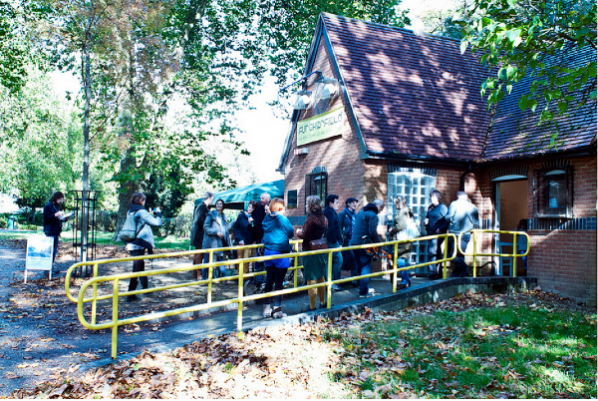
However, we are not just a gallery; we are a network connecting beyond a central hub.
“It is our contention that by engaging with these kinds of projects, the artists, viewers and participants involved become less efficient users and consumers of given informational and material domains as they turn their efforts to new playful forms of exchange. These projects make real decentralised, growth-resistant infrastructures in which alternative worlds start to be articulated and produced as participants share and exchange new knowledge and subjective experiences provoked by the work.” [9] (Garrett & Catlow, 2013)
The park setting informs our approach to curating exhibitions in a place with a strong local identity, a public green space set aside from the urban environment for leisure and enjoyment by a highly multicultural population.
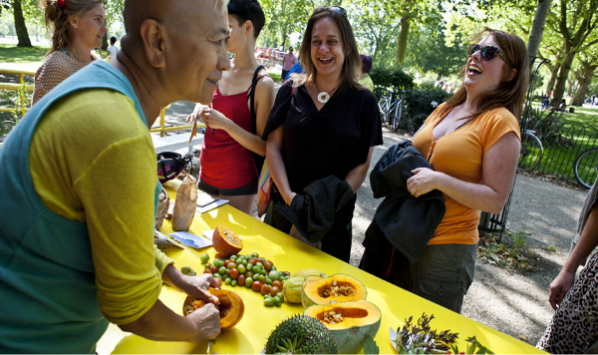
We are simultaneously connected to a network of international critical artists, technologists, thinkers and activists through our online platforms, communities, and wider networked art culture. We get all kinds of visitors from all backgrounds, including those who do not normally visit art spaces. We are not interested in pushing the mythology of high art above other equally significant art practices. Being accessible has nothing to do with dumbing down. It concerns making an effort to examine deeper connections between people and the social themes affecting theirs and our lives. We don’t avoid big issues and controversies and constantly engage in a parallel dialogue between these online communities and those meeting us in the park.
We feature works incorporating local people’s contributions, bringing them closer to the art and engagement of social dialogue. For instance, London Wall, N4 by Thomson and Craighead, reflected a collective stream of consciousness of people all around Finsbury Park, gathering their Tweets to print out and paste onto the gallery walls. By retweeting the images of the tweet posters, we gathered many of the original authors in the gallery to see their words physically located among others made in the vicinity.
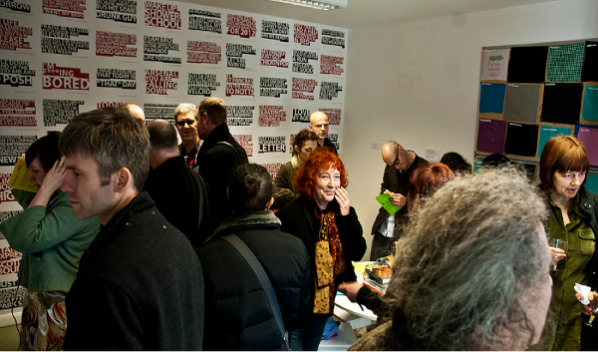
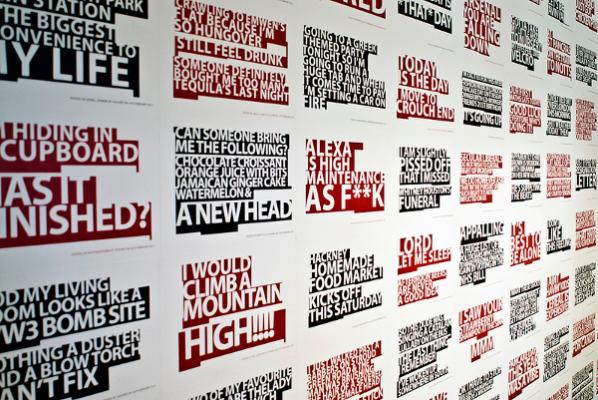
Crow_Sourcing by Andy Deck invited people to tweet animal expressions from around the world – illuminating the link between the formation of human language and our relationships with other wild webs of animal life. Gallery visitors illustrated their animal idioms, drawing directly onto the gallery walls, inspired by the ducks, crows, squirrels and dogs that inhabit the park.
We feature works dealing with networked and pervasive technologies’ human and social effects. Web 2.0 Suicide Machine by moddr_ proposed an improvement to our ‘real’ lives by providing a one-click service to remove yourself, your data, and your profile information forever from Facebook, Twitter and MySpace, replacing your icon (again, forever) with a logo depicting a noose. They also reflect on new forms of exposure and vulnerabilities they give rise to, such as Kay’s Blog, by Liz Sterry, which replicated in physical space the unkempt bedroom of an 18-year-old Canadian girl based only on her blog posts, to eerie effect. The intention is to reach people in a way that has people question their relationship with those technologies. This does not mean promoting technology as a solution to art culture but exploiting it to connect with others and critique technologies simultaneously.
Below: Selection of images from original slide presentation – exhibitions & events.
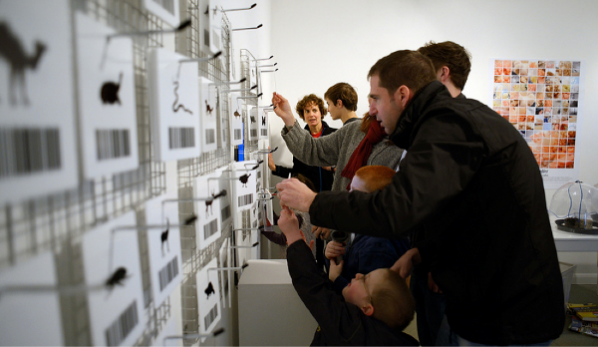

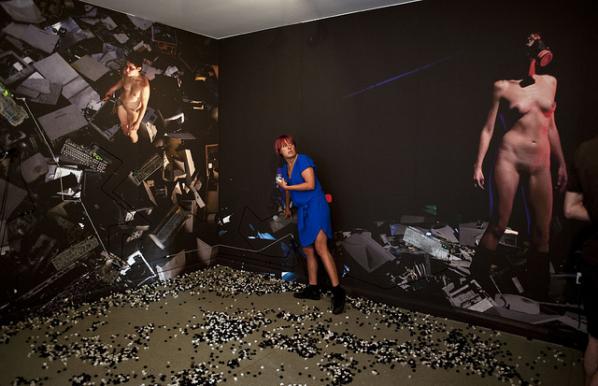
On the 23rd of November, we opened our second space in the park, ‘The Furtherfield Commons’. It kicked off with The Dynamic Site: Finsbury Park Futures, an exhibition by students from the Writtle School of Design (WSD) featuring ideas and visions for future life in Finsbury Park, coinciding with the launch.
This new lab space for experimental arts, technology and community explores ways to establish commons in the 21st Century. It draws upon influences from the 1700s when everyday people in England, such as Gerrard Winstanley and collaborators, forged a movement known as the Diggers, the True Levellers, to reclaim and claim common land from the gentry for grassroots, peer community interests. Through various workshops, residencies, events & talks, we will explore what this might mean to people locally and in connection with our international networks. These include free software works, critical approaches to gardening, gaming and other hands-on practices where people can claim direct influence in their everyday environments in the physical world, to initiate new skills and social change on their terms. From what we have learned from our years working with digital networks, we intend to apply tactical skills and practices into everyday life.
Furtherfield is a network across different time zones, platforms & places – online & physical, existing as various decentralised entities. A culture where people interact: to create, discuss, critique, review, share information, collaborate, build new artworks & alternative environments (technological, ecological, social or both), examine & try out value systems. “A rhizome has no beginning or end; it is always in the middle, between things, interbeing, intermezzo.” (Brian Massumi 1987)
DADA, Situationism, punk, Occupy, hacktivism, networks, Peer 2 Peer Culture, feminism, D.I.Y, DIWO, Free Software Movement, independent music labels, independent thinkers, people we work with, artists, activism, grassroots culture, community…
This comprises technological and physical forms of hacking. It also includes aspects and actions of agency-generation, skill, craft, disruption, self-education, social change, activism, aesthetics, re-contextualizing, claiming or reclaiming territories, independence, emancipation, relearning, rediscovering, play, joy, being imaginative, criticalness, challenging borders, breaking into and opening up closed systems, changing a context or situation, highlighting an issue, finding ways around problems, changing defaults, and restructuring things – Claiming social contexts & artistic legacies with others!
This text is a re-edited slide presentation first shown at the ICA, London, UK, on 16th November 2013 (Duration 25 min). Intermediality: Exploring Relationships in Art. Speakers Katrina Sluis, Peter Ride, Sean Cubitt & Marc Garrett.
http://www.ica.org.uk/39077/Talks/Intermediality-Exploring-Relationships-in-Art.html
Transdisciplinary Community (TDC) Leicester UK 27th Nov 2013 (45 min). Institute of Creative Technologies. De Montfort University.
Two projects Gregory Sholette is currently involved in:
It’s the Political Economy, Stupid. Curated by Oliver Ressler & Gregory Sholette
http://gallery400.uic.edu/exhibitions/its-the-political-economy-stupid
Matt Greco & Greg Sholette | Saadiyat Island Workers Quarters Collectable, 2013
http://bit.ly/1eSI5kX
—————————————————–
All exhibitions, events & projects at Furtherfield – http://www.furtherfield.org/programmes/exhibitions
Contact: info@furtherfield.org
Furtherfield Gallery is pleased to host One Minute Volume 7, a new series of shorts curated by filmmaker Kerry Baldry. The screening is accompanied by One Minute Remix, a selection of moving images from One Minute Volumes 1-5.
One Minute Volume 7 is the latest in the edition of One Minute artists’ moving image programmes curated by artist and filmmaker Kerry Baldry, and includes an eclectic mix of artists’ moving image constrained to the time limit of one minute. The One Minute programmes have been screened at numerous galleries, artists spaces and film festivals worldwide.
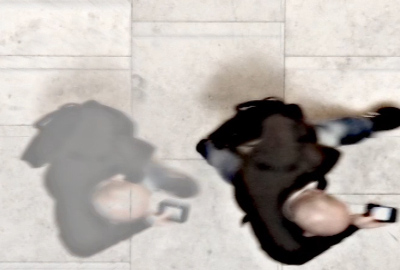
Volume 7 includes work by John Smith, Rose Butler, Tony Hill, Steven Ball, Alexander Costello, Leister/Harris, Kayla Parker and Stuart Moore, Louisa Minkin, Claire Hope, Max Hattler, Guy Sherwin, Steven Woloshen, Lynn Loo, Lumière and Son, Tansy Spinks, Gary Peploe and Peter Nutley, Eva Rudlinger, Michael Szpakowski, Zhel (Zeljko Vukicevic) , Matthias Kispert, Stuart Pound, Sellotape Cinema, Alex Pearl, My Name Is Scot, Kerry Baldry, Esther Johnson, Marty St. James, Nicki Rolls, Katherine Meynell, Chris Paul Daniels, Riccardo Iacono, Edwin Rostron, Martin Pickles, Grant Petrey, Annabel Dover, Kelvin Brown.
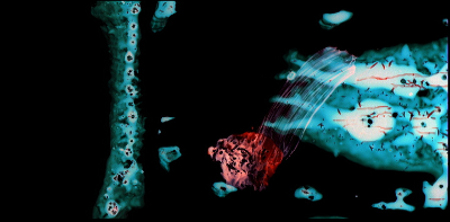
One Minute Remix (a selection from One Minute volumes 1 – 5) was originally compiled by Kerry Baldry for a screening as part of Kayla Parker and Stuart Moore’s moving image event ‘Welcome to The Treasure Dome’ (in a ICCI 360 Arena, which displayed audiovisual/moving image artwork via 5 projectors, with the screens arranged in a ‘seamless’ circle wrapped around the inside of a 21-metre diameter dome, and with surround sound) on behalf of ICCI (Innovation for the Creative and Cultural Industries) with Plymouth University; part of Maritime Mix – London 2012 Cultural Olympiad by the Sea programme, Weymouth (10 and 11 August 2012).

The programme includes work by Martin Pickles, Alex Pearl, Steven Ball, Gordon Dawson, Michael Szpakowski, Virginia Hilyard, Barry Lewis, Nick Jordan, Claire Morales, Nicki Rolls, Kerry Baldry, Riccardo Iacono, Eva Rudlinger, Zhel (Zeljko Vukicevic), Esther Johnson, Sam Renseiw and Philip Sanderson’s Lumière & Son, Katharine Meynell, Stuart Pound, Kayla Parker and Stuart Moore, Ron Diorio, Daniela Butsch, Guy Sherwin, Louisa Minkin, Rose Butler, Dave Griffiths.
+ More information: http://oneminuteartistfilms.blogspot.co.uk/
Produced by Furtherfield.
Kerry BaldryKerry Baldry is an artist/filmmaker who works in a range of media including film and video. She is a Fine Art Graduate from Middlesex University who went on to study film and video at Central St. Martins. Her first commissioned film was to make a film for BBC2’s One Minute Television which was broadcast on The Late Show – a joint collaboration between BBC2 and Arts Council England.
Over the last 6 years, aside from producing her own work, she has been curating, promoting and distributing a self initiated, unfunded project titled One Minute, One Minute Volume 7 being the latest in the edition. One Minute Volumes 1-7 are an eclectic mix of artists moving image constrained to the time limit of one minute and includes over 80 artists at varying stages of their careers.
Furtherfield Gallery
McKenzie Pavilion, Finsbury Park
London N4 2NQ
T: +44 (0)20 8802 2827
E: info@furtherfield.org
Furtherfield Gallery is supported by Haringey Council and Arts Council England.
Old Words Made New.
Ethical knowledge, sacred spaces, forgotten histories and challenging predispositions.
Furtherfield is pleased to present the excellent cross cultural project DISCLOSURE: Old Words Made New. We have collaborated with Medieval Studies Graduate Students from King’s College London, and artist Erica Scourti to reversion a contemporary representation on the subject of medieval social lives, based on the theme of ‘ethical knowledge’ through Old English. With a combination of works in the Finsbury Park surroundings, sound installations, collaborative writing, and performance.
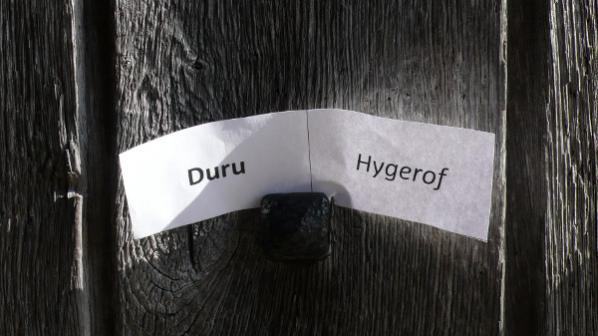
The project is part of Colm Cille’s Spiral project, a collaboration between Difference Exchange, King’s College London and Furtherfield, and takes place alongside a commission by artist Erica Scourti. It relates to a series of contemporary art and literature commissions and dialogues rethinking the legacy of 6th Century Irish monk Colm Cille, or St Columba, that unfolds across Ireland and the UK, starting and ending in Derry-Londonderry for City of Culture 2013.
Come and add an Old English phrase to the Wordhoard painted onto the walls of Furtherfield Gallery!
Help us create a visual hoard of words, received from scholars all over the world, which will show the extent of the current study of Old English. Explore the memories of our site-specific work at Bradwell-on-Sea, a church built in 654 by St Cedd, by watching our recording of the event. Walk through Finsbury Park listening to the sounds of Old English poetry and meditating on trees that bleed.
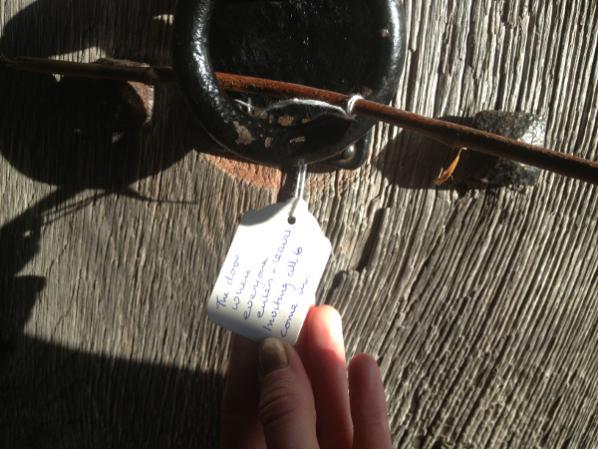
For the event, Erica Scourti will present another iteration of her video postcard project, currently existing as a series of empty, annotated videos on her Instagram profile. As a one-off, the full set of over 100 videos emailed out to friends, family and online contacts over the summer period will be screened, the only time they will be shown publicly. Also, the metadata the recipients provided for each video will form the basis of a sound piece that will play throughout the afternoon.
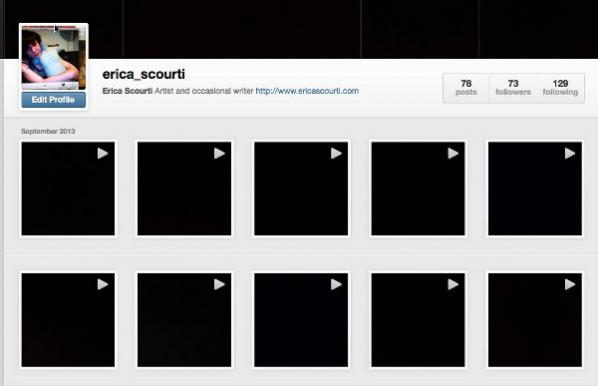
The project has explored new ways to understand and interpret the language and social contexts of a time where Christianity was at its early phase of using its people through networks around the UK, whilst pagan culture was still thriving.
The question posed to the King’s College students was “If we existed in a contemporary society where the Internet could no longer be trusted because of systems of networked surveillance, what would be the different ways in which we could communicate?”
In July 2013 they showcased their findings at a live public event at the historic Bradwell-on-Sea Church, which is now being held at Furtherfield.

A warm thanks to Kings College lecturers Professor Clare Lees, Dr Joshua Davies, Dr James Paz for collaborating.
Other Colm Cille’s Spiral projects have taken place across the UK and Ireland as part of Derry-Londonderry City of Culture and can be explored at www.colmcillespiral.net
Furtherfield Gallery
McKenzie Pavilion, Finsbury Park
London N4 2NQ
T: +44 (0)20 8802 2827
E: info@furtherfield.org
Furtherfield Gallery is supported by Haringey Council and Arts Council England.
Featured image: PAH graphic resources
Over the last few years there has been a keen interest in discussing the notion of public space; demonstrations, camps, collaborative projects, artistic interventions, community projects, social activism are just a few names that exemplify the different forms of engagement that deal with the complexities of it. Despite their different aims and impact most of these actions have given evidence of the need to re-appropriate the public space; through collective and networked practices individuals, groups and organizations ‘challenge the conventional notion of public and the making of space’[1]. Although the liveness and even virality of these events, projects or actions hinder any prediction about its midterm effects or endurance, the fact is that there is an emerging legacy that is already dismantling certain assumed thoughts about ‘the public’.
The retiree Hüseyin Çetinel’s initiative of painting a public stairway with rainbow hues in his neighbourhood in Istanbul has been the last case involving cultural transformation, virality and social activism. After he painted the local stairs to ‘make people smile’ and ‘not as a form of activism’ the municipal cleaning service painted over the stairs in dull grey provoking a chain reaction that mobilized citizens to paint stairways throughout the city. Local communities and social movements appropriated this beautiful participatory action as a form of protest after Çetinel’s stairway became viral in the social media. This example shows the intricacies of the public space and its expanded performativity. As Gus Hosein Executive Director of Privacy International argues ‘there is a confusion as to what is public space is and how it relates to our personal and private space’ in a social context where the emergence of the use of social media and surveillance as well as the appropriations of the space by private corporations and social movements and individuals are constantly questioning its boundaries[2].
From my point of view, some of these actions that play in-between the social, political and artistic might be considered re-enactments of the public space as they aim to reconstruct the term itself by applying alternative procedures and by generating at the same time transductive pedagogies. However, in order to give a comprehensive understanding of the implications of the public space and its controversies it is essential to rethink the notion of the private space. Traditionally, home has been recognized as the physical private space; home is the main representative of the private sphere that encompasses the domestic and intimate. According to Joanne Hollows, ‘the distinction between the public and the private has been a key means of organizing both space and time’[3] and consequently to promote a clear functional division.
This traditional perspective has been questioned and altered due to some current issues and events that are noticeably interconnected with those of the public space; an increasing number of evictions and homeless peoples, housing policies, escraches[4] in front of the houses of politicians, the appearance of ghost neighbourhoods due to real estate speculation, home as an alternative space for performance practice and community development, among others. Thus, home might be conceived as a container of individuals and actions, as a social product or instrument, as topographical placement or as a relational structure. Home entangles interesting layers of analysis that might serve to establish new relational and yet responsive parameters to understand both the private and public space. Some of the following examples that perform between art, activism and affections corroborate the significance of home; as Blunt and Dowling state ‘home is not separated from public, political worlds but it constituted through them: the domestic is created through the extra-domestic and viceversa’[5].
In Barcelona, the city where I live there have been noticeable factors that have stressed the importance of home as a topic of interest. Probably the most significant case is the increasing number of evictions―over 350.000 in the last four years―as many families cannot afford their rent or mortgage after losing their jobs (the unemployment rate is 26.3%). Beyond the personal implications and devastating effects that evictions have on families, they also indicate that home is not anymore our secure space or refuge; on the contrary, if the individual does not respond to the production and consumption requirements is physically displaced to the streets. Consequently, many citizens are trying to find shelter back again in the public space.
If the 70s Richard Sennett announced the decay of the public space by the emergence of an ‘unbalanced personal life and empty public life’[6], the related problems with housing have provoked the reactivation of the public space at many levels. At the same time, there is an increasing culture of the debt that ties together individuals and financial institutions in long-term relationships. As Hardt and Negri explain ‘Being in debt is becoming today the general condition of social life. It is nearly impossible to live without incurring debts—a student loan for school, a mortgage for the house, a loan for the car, another for doctor bills, and so on. The social safety net has passed from a system of welfare to one of debtfare, as loans become the primary’ means to meet social needs’[7].
These ideas can be exemplified by the actions of PAH (The Platform of People Affected by Mortgage Debt), an activist group of citizens that stops evictions through demonstrations and guerrilla media actions in the streets and that also helps struggling borrowers to negotiate with banks and promotes social housing[8]. This organized group of citizens has been awarded this year the Citizen Award by the European Union for denouncing abusive clauses in the Spanish mortgage law and battling social exclusion. PAH has received the support of the collective Enmedio that generates actions in the midst of art, social activism and media. For example, their photographic campaign ‘We are not numbers’ consisted in the design of a collection of postcards each one containing a portrait of a person that was affected by the mortgage debt by a local bank entity. The postcards were delivered in front of the bank’s main building for people to write a message. The written postcards were then stuck in the front door main door turning numbers into a collage of human struggle. PAH and Enmedio actions become highly effective thanks to their media impact and their virality in the social media. Invisible individuals isolated in their struggle, find alternatives through an assemblage of support that connects the public and private space and that is also mediated by informative and constitutive tools that the virtual space offers. As Paolo Gerbaudo claims ‘social media have been chiefly responsible for the construction of a choreography of assembly as a process of symbolic construction of public space which facilitates and guides the physical assembling of highly dispersed and individualized constituency’[9].
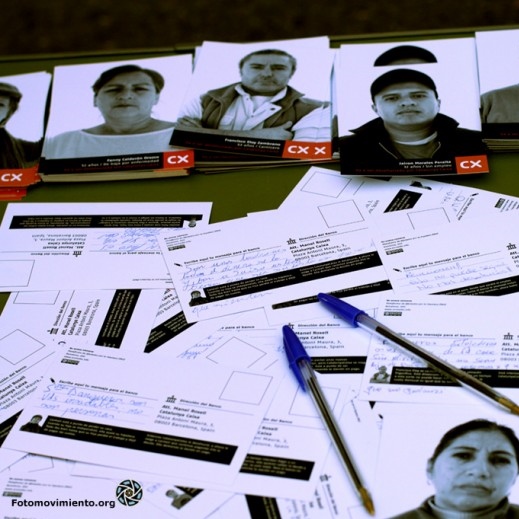
Processes of speculation, gentrification and eviction can be found in many western cities as well as different kinds of collectives and groups working for human rights advocacy. This is also the case of the Brooklyn based collective Not an Alternative has also carried out different guerrilla actions concerned with the problem of housing and eviction such as their series of workshops and media actions of ‘Occupy Real State’ or ‘Occupy Sandy’.
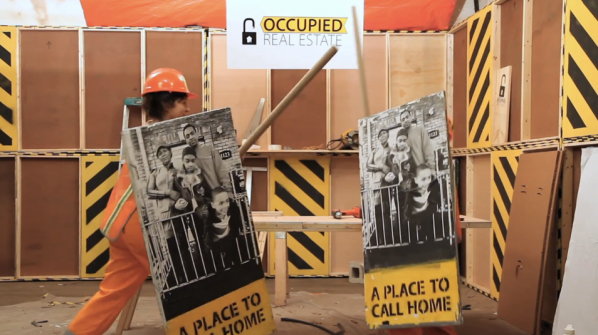
Many of the actions that these collectives promote might be understood as DIY activism as they are based on the empowerment and the development of skills. In this regard, it is interesting to observe how DIY that traditionally has been related to activities in the domestic space serves as a strategy to protect it and to trigger new forms of protest in the public space while enhancing the creation of an expanded family (or at least a sense of togetherness) through the social media.
Despite these actions, the public space is still home for many individuals. In the UK, different associations are concerned about the impact that the implementation of the bedroom tax might have, especially in London where the number of rough sleepers rises every year with an increase of the 62% since 2010-2011. The scenario is not different in many other European cities where beyond these worrying numbers there is also an increasing number of regulations and policies that difficult the life in the public space. As Suzannah Young stresses, ‘homeless people often need to use public space to survive, but are regularly driven off those spaces to satisfy commercial or even state interests’. Public space is often only open to ‘those who engage in permitted behaviour, frequently associated with consumption’[10]. The increasing number of quasi-public spaces―’spaces that are legally private but are a part of the public domain, such as shopping malls, campuses, sports grounds’ and so forth― questions again the boundaries of the private and public space, especially when ‘some EU cities use the criminal justice system to punish people living on the streets for doing things they do in order to survive, such as sleeping, eating and begging’[11]. All these policies have clear implications in the use of space and it is potential possibilities. The fact that the public space becomes home involves the reconsideration of the uses of the public space and the understanding of it through the eyes of the people that fully inhabit it. The London collective The SockMob run the Unseen Tours, alternative city tours guided by a group of homeless. Their embodied knowledge appears as a key aspect to develop these DIY versions of the city while promoting relationships between the homeless and the tour participants.
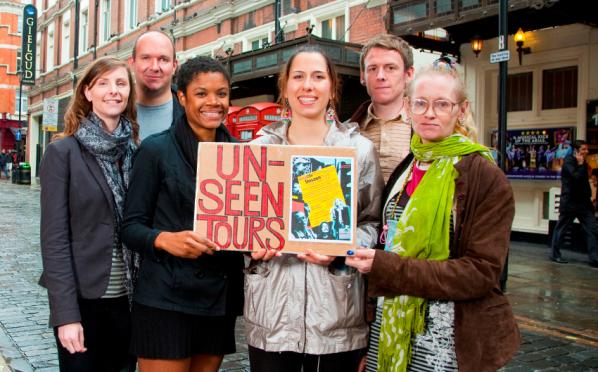
Where is home? In which ways access to spaces gives us opportunities and rights as individuals? In which ways all these site-specific initiatives that often have a transnational reach re-construct the notions of private and public space? How these DIY and media actions are generating new forms of visual arts activism? Despite the fact that these queries might need further analysis, I believe that the qualities of space becomes visible and tangible through these interactive and responsive actions with the spaces. Recently, an international group of activists, visual artists and scholars have published a handbook in which their consider these forms of activism militant research. According to them, ‘militant research involves participation by conviction, where researchers play a role in the actions and share the goals, strategies, and experience of their comrades because of their own committed beliefs and not simply because this conduct is an expedient way to get their data. The outcomes of the research are shaped in a way that can serve as a useful tool for the activist group, either to reflect on structure and process, or to assess the success of particular tactics’[12]. Hence, the idea of some hands-on, the acquisition of skills and the performance of theory appear as key aspects to disentangle and analyse the qualities of the space.
From an artistic perspective home has been crucial in many historical periods of dictatorship to construct an underground scene of the arts; in many of these cases, the evidence of artistic practice appears through testimonials and documentation (photographs, fanzines, recordings, etc.). Again different forms of media help to make the clandestine public, crossing the sphere of the private into the public realm. Thus, the importance of documentation enhances different temporalities of reception and impact in the public realm. In this regard, a differed presentation of the artistic works triggers a reconsideration of the attributes of the spaces too. Currently, homes serve as a basic space for artists to present their work; in the case of music, this is a widely known practice in the US that is becoming more and more common in other countries and other art forms. Homes serve as a personal curatorial space for fine arts artists through the open studio festivals too; artists make their private space open for others as a strategy to show their work publicly. At the same time, in some artistic disciplines self-curation through digital portfolios is becoming increasingly used to showcase artworks. One way or another, home remains often the main space for creativity, production and curation through and expanded DIY conception of their profession.
Home becomes even more crucial in a context marked by the arts cuts and the economic crisis. In this regard, there are initiatives that see an opportunity in the relationship between the public and private space not only to exhibit or perform art but also to trigger a counter-performative form of showing works. This is the case of the domestic festivals that try to challenge the concepts of cultural enterprise and institution by proposing home as a legitimate space of the artistic experience. Friends, neighbours and acquaintances offer a room or a space in their house for artists to perform there (examples can be found in different cities such as Santiago de Chile, Madrid, Berlin, Barcelona, etc.). At the same time, the format wishes to transform the spatial and affective relationships that citizens have with the space, by inverting the spatial dichotomy between the public and the private. Hence, the idea goes beyond to a practical solution to have a space to perform as it also aims to give visibility to performing practices that have not been yet legitimized by the public sphere and they are in danger to remain in a sort of clandestinity (as they are not part of the current cultural market). In this regard, there is also a sense of evicted or homeless art that is trying to produce a social context of experience and articulation beyond the immediate effects of the power that governs at many level the public sphere. These kinds of initiatives generate ‘an activity that undermines the exclusion by letting occur, at the very boundary which separates the public from the “secret”’, an articulation which challenges the prevailing framework of representation and legitimation’[14].
The intersection between art, activism and affections help to explain the multiple and complex questions that configure the notion of home. With these examples I just wanted to stress the importance of home in the discourses that address the concepts of public space/public sphere/publicly. Thus homes ‘are thereby metaphorical gateways to geopolitical contestation that may simultaneously signify the nation, the neighbourhood or just one’s streets’[15]. From a transnational perspective, home seems to pose the crucial questions that connect us with what is happening inside, outside and in-between the spaces and gives us a different perspective to analyse current artistic and social practices that engage with our mode of action, production and identity.
I guess this is all from my home.
Public Screening and Discussion at Furtherfield
Contact: info@furtherfield.org
Visiting Information
THE EVENT HAS LIMITED AVAILABILITY.
PLEASE RSVP TO BOOK YOUR PLACE TO ALESSANDRA
Cornelia Sollfrank will present her latest film Giving What You Don’t Have. It features interviews with individuals Kenneth Goldsmith, Marcell Mars, Sean Dockray, Dmitry Kleiner, discussing with Sollfrank their projects and ideas on peer-to-peer production and distribution as art practice. It includes the projects ubu.com or aaaaarg.org, which combine social, technical and aesthetic innovation; they promote open access to information and knowledge and make creative contributions to the advancement and the reinvention of the idea of the commons.
The post-screening discussion will be led by Cornelia Sollfrank, Joss Hands & Rachel Baker.
On the basis of the interviews of Giving What You Don’t Have, we would like to discuss some of the issues they represent such as new forms of collaborative production, the shift of production from artefacts to the provision of open tools and infrastructures, the development of formats for self-organisation in education and knowledge transfer, (the potential and the limits of) open content licensing as well as the creation of independent ways of distributing cultural goods. An implicit part of Giving What You Don’t Have is a suggested reconceptualization of art under networked conditions.
Cornelia Sollfrank is a postmedia conceptual artist and interdisciplinary researcher and writer. She studied painting at the Academy of Fine Arts in Munich and fine art at the University of Fine Arts of Hamburg (1987-1994). Since 1998 she has taught at various universities and written on issues in the nexus between media, art and politics. In 2011 Sollfrank completed her practice-led interdisciplinary research at Dundee University (UK) and published her PhD thesis with the title Performing the Paradoxes of Intellectual Property. In addition to her work in the artistic and academic fields, Sollfrank gathered experience in the private sector by working as product manager for Philips Media for two years (1995-1996).
Joss Hands‘ research engages the relationship between media, culture and politics. His recent work has explored the role of digital media in direct action, protest and activism, culminating in his book @ is For Activism: Dissent Resistance and Rebellion in a Digital Culture, published by Pluto Press in 2011. His previous research has explored the role of new media in formal democracy and governance as well as its cultural, economic and social impact. He has published in a number of journals such as Information, Communication and Society, Philosophy and Social Criticism and First Monday as well as writing commentary for publications such as Open Democracy, IPPR Journal, The New Left Project, and others.
Rachel Baker is a network artist who collaborated on the influential irational.org. Her art practice explores techniques used in contemporary marketing to gather and distribute data for the purposes of manipulation and propaganda. Networks of all kinds are “sites” for Baker’s public and private distributed art practice, including radio combined with Internet (Net.radio), mobile phones and SMS messaging, and rail networks. She has presented and exhibited work internationally at various new media and electronic art festivals.
Giving What You Don’t Have is an artistic research project commissioned by the Post-Media Lab, Leuphana University.
Furtherfield Gallery
McKenzie Pavilion, Finsbury Park
London N4 2NQ
T: +44 (0)20 8802 2827
E: info@furtherfield.org
Furtherfield Gallery is supported by Haringey Council and Arts Council England.
Post Digital Print
The Mutation of Publishing Since 1894
Alessandro Ludovico, 2012
Onamatopee 77
The sticky fingerprints on the black-and-pink 1970s photomechanical typography-style lettered cover of “Post Digital Print” speak volumes about the nature of physical print after the event of digital typography. It is this sense, of print in a state of technical and historical play after the full event of the digital rather than its end or irrelevance, that Alessandro Ludovico is considering history of print publishing here. But why 1894?
Ludovico dates the first announcement of “the death of print” to that year. More than a century later independent bookshops, large bookshop chains, newspapers and magazines are having to compete with Internet-based publishing or be wiped out. It’s not clear whether physical print publishing believes it can survive this encounter with the digital. Ludovico explains how it can and why it is important that it should.
There are three main threads to “Post Digital Print”. The first is a wide-ranging technical history of print, including technologies that were imagined or proposed but never became widespread. The second is a history of radical political and avant-garde historical use, misuse and critique of those technologies. And the third is an analysis of the social and technological networks that distributed the products of the first two. These threads tie together finally in a consideration of the current situation and future prospects of physical print publishing.
The mainstream history of printing goes from movable type through hot metal to photomechanical and finally PostScript-based publishing. This is how books and newspapers have reached millions of people. But not every print production technology has lasted or gained mass adoption. I was surprised to read that Ezra Pound once wrote a poem specifically for Bob Brown’s “Readies” (an imagined 1930s motorized-paper-strip book replacement), and in the first half of the twentieth century newspapers were transmitted by telegraph, telephone and radio ready to be listened to or remotely printed.
The technical failings of dead media become aesthetic affordances in their afterlives. Letterpress embosses the paper it is printed on, lithography suffers misregistration and other artifacts, and newsprint smears and creases. These are now the very qualities people seek from those media. This is different from mere nostalgia, in that it is used to create a contemporary aesthetic, but what of the “Readies” and other book replacements that never were? They are the subconscious or the dreams of print technology, forgotten futures that help to understand the paths that were taken.
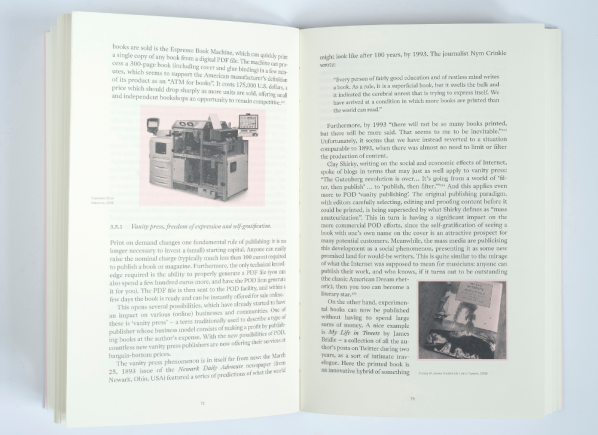
Not every print technology was designed to print millions of copies. Spirit duplicators, photocopiers and print-on-demand publishing all allowed democratic access to print for smaller print runs of projects with less mass appeal. Ludovico tracks this thread of print history from mid-twentieth-century science fiction fanzines through the alternative press to the contemporary fanzine scene.
Artists and political groups pushed the technology and aesthetics of each new print technology with pamphlets, unlicensed newspapers, the alternative press, fanzines, and books and journals. Ludovico uses avant-garde and culture jamming artistic publications, from the Dadaists and Futurists to the Yes Men and Decapitator to demonstrate how artists have pushed the form and content of print publications.
Once you have printed a publication you must distribute it. For publications outside of mainstream or official culture, this is a task that has varied in difficulty from inconvenient to deadly. British newspapers had to be licensed (and thereby censored) by the state in the early nineteenth century. Alternative political views were printed in unlicensed newspapers printed by sympathetic printers. These newspapers outsold the official press, and were subject to repression by the state, leading to funds being set up to support the families of arrested printers.
In the Soviet union, Samizdat copies of books were produced with stolen or smuggled paper and borrowed presses. Less dramatically but still outside the mainstream or official culture, the alternative press and fanzine scenes have survived through mail-order print and online catalogues and through conventions. And the Fluxus scene distributed its print products through an international network of distributors.
The “gesture” of publishing, as Ludovico calls it, is an editorial one and without this editorial control the Internet of blogs and social media presents a problem of filtering rather than access. Writing from the web can be taken into print cheaply through print-on-demand, led by the example of James Bridle’s “My Life In Tweets”, 2009. Where an artist led, business followed and there are now many services that will print your social media as books for you.
(What of eBooks? Ludovico considers their technology and its history in depth, but is not hopeful for them. They simulate print ever more closely, confirming Ludovico’s argument that print is the better interface. They have an environmental impact that makes books look more appealing, and suffer all the problems of censorship and technological obsolescence that print now does not.)
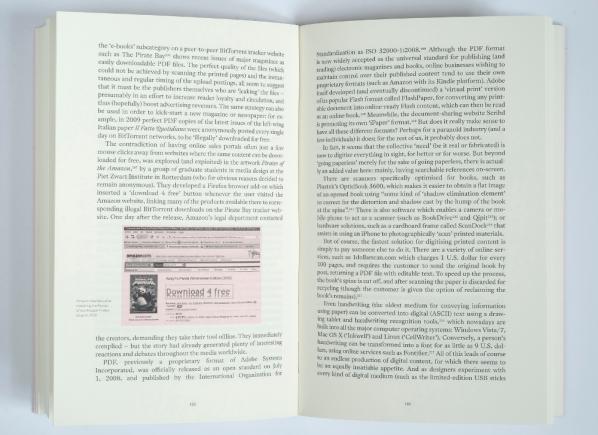
In the final chapter (“The Network”) the author enters the story that he is telling. Since the early 1990s Ludovico has produced the magazine “Neural” (I’m a subscriber and I cannot recommend it highly enough), and has been involved in other art projects, events and interventions that have placed him in the thick of the action of the changes in publishing and textual media that have occurred over this period. Rather than affect a false objectivity, Ludovico lets you know where he is coming from and shares the particularities of his broad experience. This lends his conclusions a context and authority that mere theory might lack.
The history and experience that Ludovico lays out leads to the present crisis of print and answers it with the terms that he has established. How can we continue to print physical books? With the kinds of networks that have always propagated and paid for art and for the alternative press. Why should we continue to make them? Because they are better interfaces, archives, and art objects than purely digital objects.
Post-digital print is print with its production and in some ways its very meaning transformed. Print must adopt digital-inspired models of production and distribution to survive. As Ludovico argues it must adopt the digital strategy of the network, in a free and open way. If it does not, we lose a vital part of our collective cultural voice and memory.
“Paper is flesh, screen is metal. … Flesh and metal will thus merge as in a cyberpunk film, hopefully spawning useful new models for carrying and spreading unprecedented amounts of information and culture.” (Post-Digital Print, p117)
The text of this review is licenced under the Creative Commons BY-SA 3.0 Licence.
(Thank you to Freek Lomme of Onomatopee for providing the book interior images.)
LIVE LINK HERE
In collaboration with Annie Abrahams and Emmanuel Guez, Furtherfield presents two new ReadingClub sessions based on excerpts from McKenzie Wark’s A Hacker Manifesto [version 4.0] and the ARPANET dialogues.
ReadingClub proposes a text and an interpretive arena to 4 readers. These readers write together their reading of a text inside the text itself. The audience sees an evolving, cinematographic picture of thoughts and collaborative writing in the making.
Join the performance online at readingclub.fr and use the chat window to exchange, discuss and comment on the performance.
Monday 21 October 2013, 8pm London Time – A Hacker Manifesto [version 4.0]
Online performance session based on an excerpt from A Hacker Manifesto [version 4.0] by McKenzie Wark – with Aileen Derieg, Cornelia Sollfrank, Dmytri Kleiner and Marc Garrett.
Drawing in equal measure on Guy Debord and Gilles Deleuze, A Hacker Manifesto offers a systematic restatement of Marxist thought for the age of cyberspace and globalization. In the widespread revolt against commodified information, McKenzie Wark sees a utopian promise, beyond the property form, and a new progressive class, the hacker class, who voice a shared interest in a new information commons.
Tuesday 22 October 2013, 8pm London Time – The ARPANET dialogues
Online performance session based on an excerpt of the ARPANET dialogues from 1975-1976 – with Alessandro Ludovico, Jennifer Chan, Lanfranco Aceti and Ruth Catlow.
The ARPANET dialogues is an archive of rare conversations within the contemporary social, political and cultural milieu convened between 1975 and 1979 that were conducted via an instant messaging application networked by computers plugged into ARPANET, the United States Department of Defense’s experimental computer network. All participants in the conversation were given special access to terminals connected to ARPANET, many of them located in US military installations or DOD-sponsored research institutions around the world.
What was originally thought to be a historic moment, when figures from within and without the established art canon first encountered the disruptive effects of digital network communications, turned out to be an ongoing research project by Bassam El Baroni, Jeremy Beaudry and Nav Haq.
Further reading:
“This pre-Internet chatroom conversation between Jim Henson, Ayn Rand, Yoko Ono and Sidney Nolan is fake. But it’s amazing” – Robert Gonzalez in io9, December 2012.
“Ronald Reagan has joined the chatroom” – Interview by Richard Fischer, CultureLab with Jeremy Beaudry, one of the artists behind the project, April 2011.
The ReadingClub is a project by Annie Abrahams and Emmanuel Guez, inspired by Brad Troemel’s Reading Group and the Department of Reading by Sönke Hallman.
The project is supported by Dicréam.
+ More information about ReadingClub
In conjunction with Shu Lea Cheang and Mark Amerika exhibition, Furtherfield is pleased to host Shu Lea Cheang’s Seeds Underground Party.
In certain parts of the world, the vast farmlands have been colonised by genetically modified crops for our staple foods (i.e. wheat, soybeans, corns). Introduced 30 years ago, the transgenic biotechnology has since been commercialised by the patent-protected corporate sectors. Taking over the wholesale markets, the Herbicide-tolerant and pest-resistant seeds promise higher yields and profits without much ecological concerns. This year, the European Union is about to adopt a new seed policy, which favours the seed industry corporations by making all seeds subject to strict regulation. It is feared that this will hurt organic varieties and prevent seed exchange by seed farmers and savers.
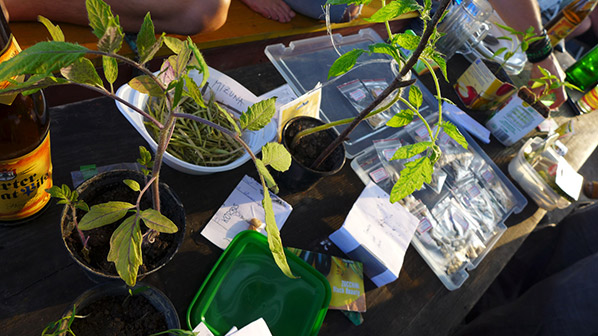
Join us for a seed exchange party where packets of seeds change hands and go underground in the fields around Finsbury Park and beyond.
Bring your self-harvested homegrown seeds of sorts! Sign on to trade seeds, to adopt and germinate, to broadcast and track their distribution. Share some food, drinks and seeds stories while we celebrate the harvest season together in the relaxing setting of Finsbury Park.
+ To join Seeds Underground Party, and trade and track your seeds, please register on http://seedsunderground.net
Click on TRADE and select Furtherfield, London from the “join a seeds underground party” pull down menu.
Seeds Underground holds seed exchange parties where packets of seeds change hands and go underground in the fields across nation borders.
+ More information:
now@seedsunderground.net
www.seedsunderground.net
Furtherfield Gallery
McKenzie Pavilion, Finsbury Park
London N4 2NQ
T: +44 (0)20 8802 2827
E: info@furtherfield.org
Furtherfield Gallery is supported by Haringey Council and Arts Council England
On second day of summer, Maja Kalogera & Med-i-kids from AKC Medika in Zagreb, will gather in Finsbury Park in front of Furtherfiled Gallery. They will present Classical Sitting Squatters. They are quite a joyful bunch, they recite, chirp, sing, blink, sit still, just name it. You are invited to join them/us for a drink and meet them in ‘person’, on Saturday 22 June 2013, between 11am and 5pm.
Classical Sitting Squatters (CSS) is an installation made of a dozen full-sized figures or ‘sitting’ sculptures. They are reciting poetry of Gertrude Stein, Dylan Thomas and Emily Dickinson, on the input of the passers-by.

Med-i-kids is an open group of street artists which connected in Medika, Zagreb. Their mission is to make public artworks to raise awareness and question the many dogmas present in Croatian society, the very same society positoned in third place as one the most courrupted countries positioned.
Maja Kalogera is an artist, curator and catalyst who consistently places herself at the convergence of art and technology. Born in Zagreb, she holds B.F.A. from School of Applied and Visual arts, Zagreb and M.Arch. from Architecture University, Zagreb. From 1999 she is member of the online collective wowm.org. Her creative work over the past 15 years has included a wide range of mediums: digital and interactive media, photography, painting, video and film. In 2005, she founded Center for synergy of digital and visual arts, a Zagreb based NGO, that provides her unique approach focused on synergy between traditional art media with new, digital media. In her own artwork she is interested in ways how people participate in physical and virtual spaces. Lately she started to collaborate with med-i-kids on socially engaged projects.